Quick filters:
Japanese demons Stock Photos and Images
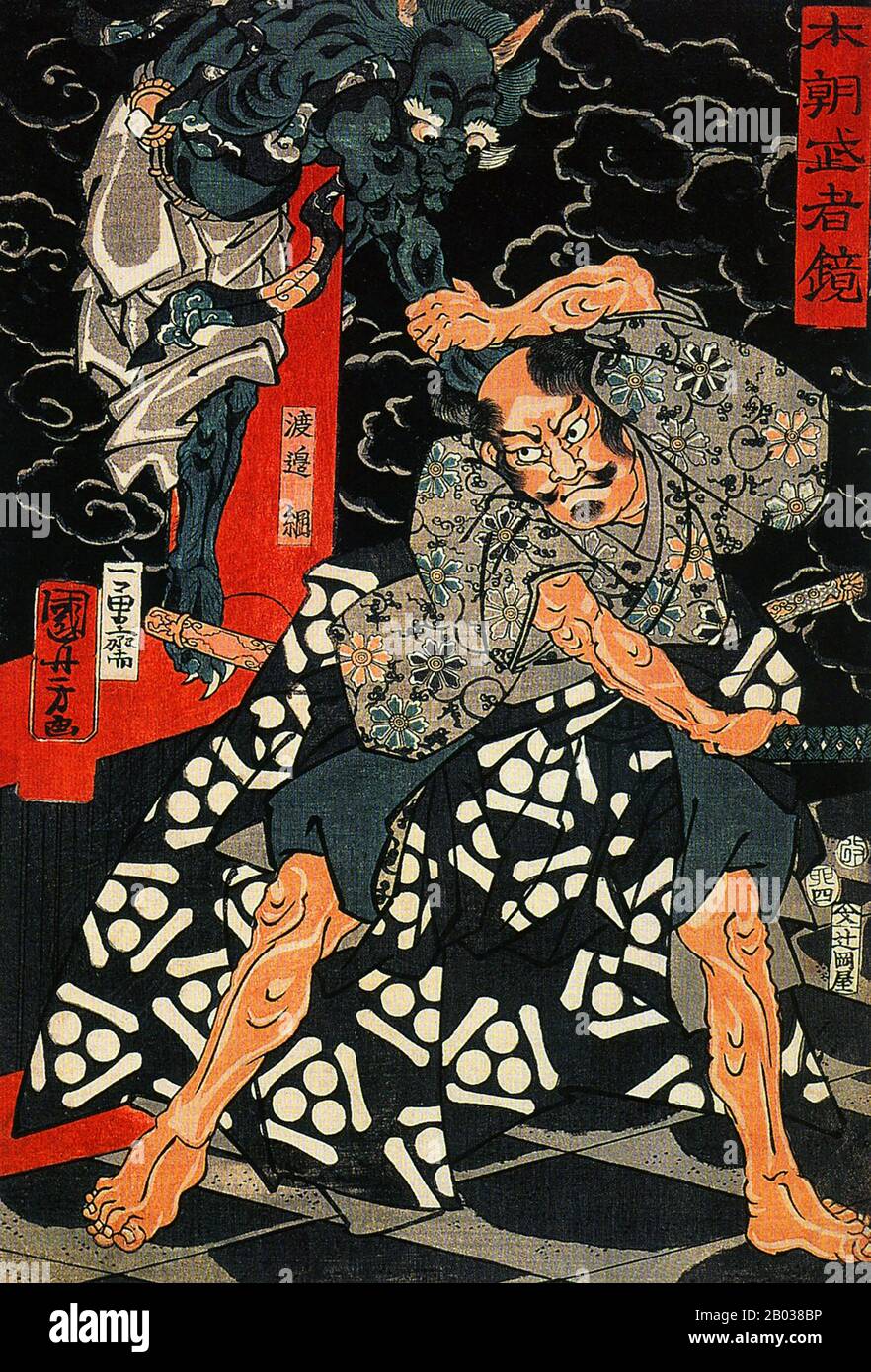 Ibaraki-doji was an oni (demon / ogre) in Japanese tales and legends from the Heian Era. The demon was known to go on murderous rampages throughout the countryside and across Kyoto. She would also fool innocent travellers and kill them, wearing various disguises to lure them in. Once, she tried to kill the legendary samurai Watanabe no Tsuna as he was travelling, appearing as a beautiful maiden who needed help. When Tsuna approached, the girl transformed into an oni and grabbed him by his hair, flying through the air to Mount Atago. Tsuna, not panicking, easily cut off the demon's arm however Stock Photohttps://www.alamy.com/image-license-details/?v=1https://www.alamy.com/ibaraki-doji-was-an-oni-demon-ogre-in-japanese-tales-and-legends-from-the-heian-era-the-demon-was-known-to-go-on-murderous-rampages-throughout-the-countryside-and-across-kyoto-she-would-also-fool-innocent-travellers-and-kill-them-wearing-various-disguises-to-lure-them-in-once-she-tried-to-kill-the-legendary-samurai-watanabe-no-tsuna-as-he-was-travelling-appearing-as-a-beautiful-maiden-who-needed-help-when-tsuna-approached-the-girl-transformed-into-an-oni-and-grabbed-him-by-his-hair-flying-through-the-air-to-mount-atago-tsuna-not-panicking-easily-cut-off-the-demons-arm-however-image344279818.html
Ibaraki-doji was an oni (demon / ogre) in Japanese tales and legends from the Heian Era. The demon was known to go on murderous rampages throughout the countryside and across Kyoto. She would also fool innocent travellers and kill them, wearing various disguises to lure them in. Once, she tried to kill the legendary samurai Watanabe no Tsuna as he was travelling, appearing as a beautiful maiden who needed help. When Tsuna approached, the girl transformed into an oni and grabbed him by his hair, flying through the air to Mount Atago. Tsuna, not panicking, easily cut off the demon's arm however Stock Photohttps://www.alamy.com/image-license-details/?v=1https://www.alamy.com/ibaraki-doji-was-an-oni-demon-ogre-in-japanese-tales-and-legends-from-the-heian-era-the-demon-was-known-to-go-on-murderous-rampages-throughout-the-countryside-and-across-kyoto-she-would-also-fool-innocent-travellers-and-kill-them-wearing-various-disguises-to-lure-them-in-once-she-tried-to-kill-the-legendary-samurai-watanabe-no-tsuna-as-he-was-travelling-appearing-as-a-beautiful-maiden-who-needed-help-when-tsuna-approached-the-girl-transformed-into-an-oni-and-grabbed-him-by-his-hair-flying-through-the-air-to-mount-atago-tsuna-not-panicking-easily-cut-off-the-demons-arm-however-image344279818.htmlRM2B038BP–Ibaraki-doji was an oni (demon / ogre) in Japanese tales and legends from the Heian Era. The demon was known to go on murderous rampages throughout the countryside and across Kyoto. She would also fool innocent travellers and kill them, wearing various disguises to lure them in. Once, she tried to kill the legendary samurai Watanabe no Tsuna as he was travelling, appearing as a beautiful maiden who needed help. When Tsuna approached, the girl transformed into an oni and grabbed him by his hair, flying through the air to Mount Atago. Tsuna, not panicking, easily cut off the demon's arm however
 Rokurokubi and Mikoshi-nyudo, Japanese Demons Stock Photohttps://www.alamy.com/image-license-details/?v=1https://www.alamy.com/stock-photo-rokurokubi-and-mikoshi-nyudo-japanese-demons-135096764.html
Rokurokubi and Mikoshi-nyudo, Japanese Demons Stock Photohttps://www.alamy.com/image-license-details/?v=1https://www.alamy.com/stock-photo-rokurokubi-and-mikoshi-nyudo-japanese-demons-135096764.htmlRMHRP58C–Rokurokubi and Mikoshi-nyudo, Japanese Demons
 Hyakki Yagyo, variation: hyakki yako, (lit. 'Night Parade of One Hundred Demons') is a concept in Japanese folklore. It is a parade which is composed of a hundred kinds of yokai (supernatural monsters). Legend has it that every year the yokai Nurarihyon, will lead all of the yokai through the streets of Japan during summer nights. Anyone who comes across the procession will perish or be spirited away by the yokai, unless protected by handwritten scrolls by anti-yokai onmyoji spellcasters. According to the account in the Shugaisho, a medieval Japanese encyclopedia, the only way to be kept saf Stock Photohttps://www.alamy.com/image-license-details/?v=1https://www.alamy.com/hyakki-yagyo-variation-hyakki-yako-lit-night-parade-of-one-hundred-demons-is-a-concept-in-japanese-folklore-it-is-a-parade-which-is-composed-of-a-hundred-kinds-of-yokai-supernatural-monsters-legend-has-it-that-every-year-the-yokai-nurarihyon-will-lead-all-of-the-yokai-through-the-streets-of-japan-during-summer-nights-anyone-who-comes-across-the-procession-will-perish-or-be-spirited-away-by-the-yokai-unless-protected-by-handwritten-scrolls-by-anti-yokai-onmyoji-spellcasters-according-to-the-account-in-the-shugaisho-a-medieval-japanese-encyclopedia-the-only-way-to-be-kept-saf-image344271627.html
Hyakki Yagyo, variation: hyakki yako, (lit. 'Night Parade of One Hundred Demons') is a concept in Japanese folklore. It is a parade which is composed of a hundred kinds of yokai (supernatural monsters). Legend has it that every year the yokai Nurarihyon, will lead all of the yokai through the streets of Japan during summer nights. Anyone who comes across the procession will perish or be spirited away by the yokai, unless protected by handwritten scrolls by anti-yokai onmyoji spellcasters. According to the account in the Shugaisho, a medieval Japanese encyclopedia, the only way to be kept saf Stock Photohttps://www.alamy.com/image-license-details/?v=1https://www.alamy.com/hyakki-yagyo-variation-hyakki-yako-lit-night-parade-of-one-hundred-demons-is-a-concept-in-japanese-folklore-it-is-a-parade-which-is-composed-of-a-hundred-kinds-of-yokai-supernatural-monsters-legend-has-it-that-every-year-the-yokai-nurarihyon-will-lead-all-of-the-yokai-through-the-streets-of-japan-during-summer-nights-anyone-who-comes-across-the-procession-will-perish-or-be-spirited-away-by-the-yokai-unless-protected-by-handwritten-scrolls-by-anti-yokai-onmyoji-spellcasters-according-to-the-account-in-the-shugaisho-a-medieval-japanese-encyclopedia-the-only-way-to-be-kept-saf-image344271627.htmlRM2B02WY7–Hyakki Yagyo, variation: hyakki yako, (lit. 'Night Parade of One Hundred Demons') is a concept in Japanese folklore. It is a parade which is composed of a hundred kinds of yokai (supernatural monsters). Legend has it that every year the yokai Nurarihyon, will lead all of the yokai through the streets of Japan during summer nights. Anyone who comes across the procession will perish or be spirited away by the yokai, unless protected by handwritten scrolls by anti-yokai onmyoji spellcasters. According to the account in the Shugaisho, a medieval Japanese encyclopedia, the only way to be kept saf
 Enenra, Konjaku Hyakki Shūi First Volume Cloud, published ca. 1781, by Japanese artist Sekien Toriyama ( 1712 - 1788 ) Stock Photohttps://www.alamy.com/image-license-details/?v=1https://www.alamy.com/enenra-konjaku-hyakki-shi-first-volume-cloud-published-ca-1781-by-japanese-artist-sekien-toriyama-1712-1788-image208345606.html
Enenra, Konjaku Hyakki Shūi First Volume Cloud, published ca. 1781, by Japanese artist Sekien Toriyama ( 1712 - 1788 ) Stock Photohttps://www.alamy.com/image-license-details/?v=1https://www.alamy.com/enenra-konjaku-hyakki-shi-first-volume-cloud-published-ca-1781-by-japanese-artist-sekien-toriyama-1712-1788-image208345606.htmlRMP2XXXE–Enenra, Konjaku Hyakki Shūi First Volume Cloud, published ca. 1781, by Japanese artist Sekien Toriyama ( 1712 - 1788 )
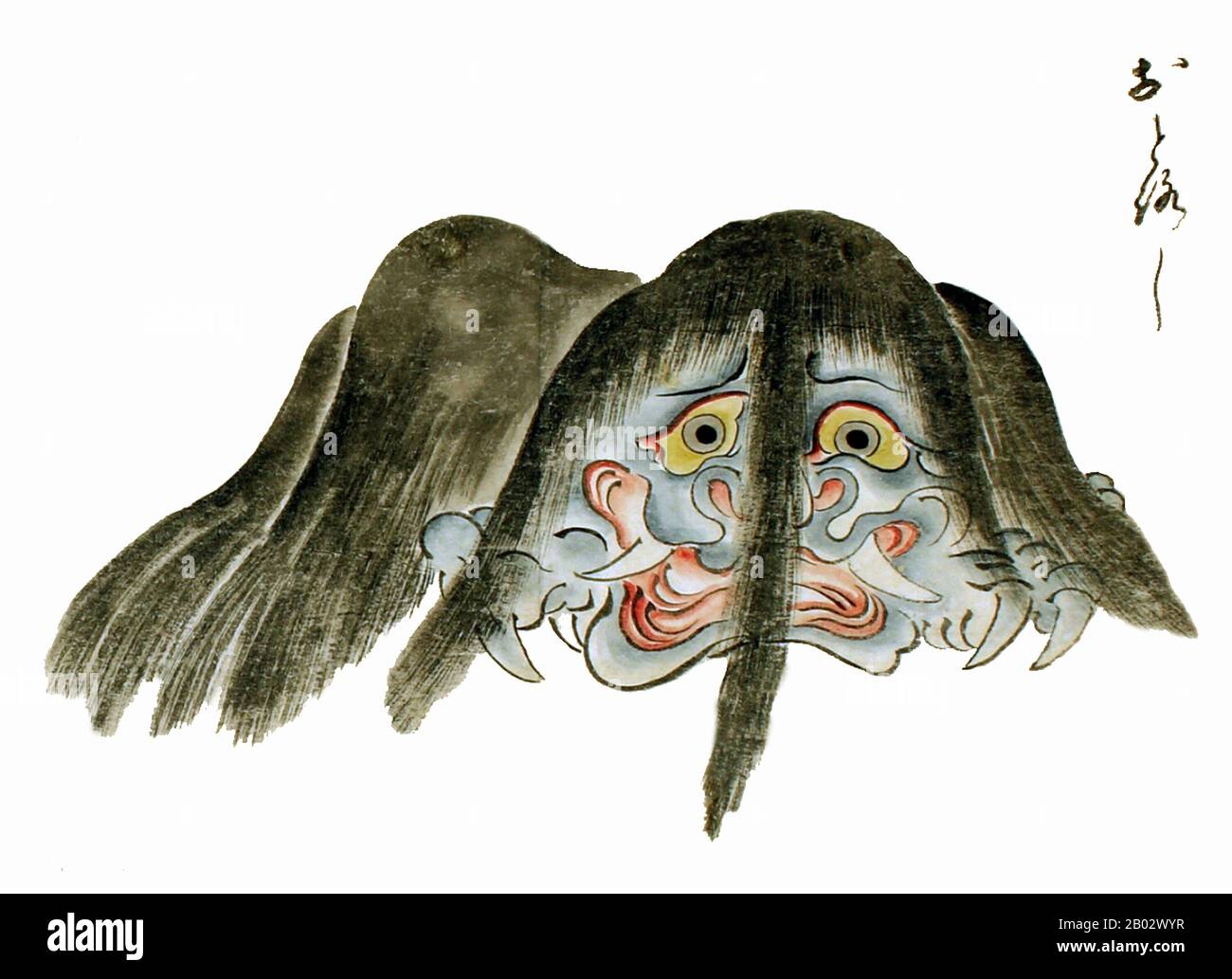 Hyakki Yagyo, variation: hyakki yako, (lit. 'Night Parade of One Hundred Demons') is a concept in Japanese folklore. It is a parade which is composed of a hundred kinds of yokai (supernatural monsters). Legend has it that every year the yokai Nurarihyon, will lead all of the yokai through the streets of Japan during summer nights. Anyone who comes across the procession will perish or be spirited away by the yokai, unless protected by handwritten scrolls by anti-yokai onmyoji spellcasters. According to the account in the Shugaisho, a medieval Japanese encyclopedia, the only way to be kept saf Stock Photohttps://www.alamy.com/image-license-details/?v=1https://www.alamy.com/hyakki-yagyo-variation-hyakki-yako-lit-night-parade-of-one-hundred-demons-is-a-concept-in-japanese-folklore-it-is-a-parade-which-is-composed-of-a-hundred-kinds-of-yokai-supernatural-monsters-legend-has-it-that-every-year-the-yokai-nurarihyon-will-lead-all-of-the-yokai-through-the-streets-of-japan-during-summer-nights-anyone-who-comes-across-the-procession-will-perish-or-be-spirited-away-by-the-yokai-unless-protected-by-handwritten-scrolls-by-anti-yokai-onmyoji-spellcasters-according-to-the-account-in-the-shugaisho-a-medieval-japanese-encyclopedia-the-only-way-to-be-kept-saf-image344271643.html
Hyakki Yagyo, variation: hyakki yako, (lit. 'Night Parade of One Hundred Demons') is a concept in Japanese folklore. It is a parade which is composed of a hundred kinds of yokai (supernatural monsters). Legend has it that every year the yokai Nurarihyon, will lead all of the yokai through the streets of Japan during summer nights. Anyone who comes across the procession will perish or be spirited away by the yokai, unless protected by handwritten scrolls by anti-yokai onmyoji spellcasters. According to the account in the Shugaisho, a medieval Japanese encyclopedia, the only way to be kept saf Stock Photohttps://www.alamy.com/image-license-details/?v=1https://www.alamy.com/hyakki-yagyo-variation-hyakki-yako-lit-night-parade-of-one-hundred-demons-is-a-concept-in-japanese-folklore-it-is-a-parade-which-is-composed-of-a-hundred-kinds-of-yokai-supernatural-monsters-legend-has-it-that-every-year-the-yokai-nurarihyon-will-lead-all-of-the-yokai-through-the-streets-of-japan-during-summer-nights-anyone-who-comes-across-the-procession-will-perish-or-be-spirited-away-by-the-yokai-unless-protected-by-handwritten-scrolls-by-anti-yokai-onmyoji-spellcasters-according-to-the-account-in-the-shugaisho-a-medieval-japanese-encyclopedia-the-only-way-to-be-kept-saf-image344271643.htmlRM2B02WYR–Hyakki Yagyo, variation: hyakki yako, (lit. 'Night Parade of One Hundred Demons') is a concept in Japanese folklore. It is a parade which is composed of a hundred kinds of yokai (supernatural monsters). Legend has it that every year the yokai Nurarihyon, will lead all of the yokai through the streets of Japan during summer nights. Anyone who comes across the procession will perish or be spirited away by the yokai, unless protected by handwritten scrolls by anti-yokai onmyoji spellcasters. According to the account in the Shugaisho, a medieval Japanese encyclopedia, the only way to be kept saf
 Bas relief of Buddha meditating in Bodh Gaya under Bodhi tree to achieve enlightment with demons send by Mara to confuse Stock Photohttps://www.alamy.com/image-license-details/?v=1https://www.alamy.com/bas-relief-of-buddha-meditating-in-bodh-gaya-under-bodhi-tree-to-achieve-image5623928.html
Bas relief of Buddha meditating in Bodh Gaya under Bodhi tree to achieve enlightment with demons send by Mara to confuse Stock Photohttps://www.alamy.com/image-license-details/?v=1https://www.alamy.com/bas-relief-of-buddha-meditating-in-bodh-gaya-under-bodhi-tree-to-achieve-image5623928.htmlRMA00NY9–Bas relief of Buddha meditating in Bodh Gaya under Bodhi tree to achieve enlightment with demons send by Mara to confuse
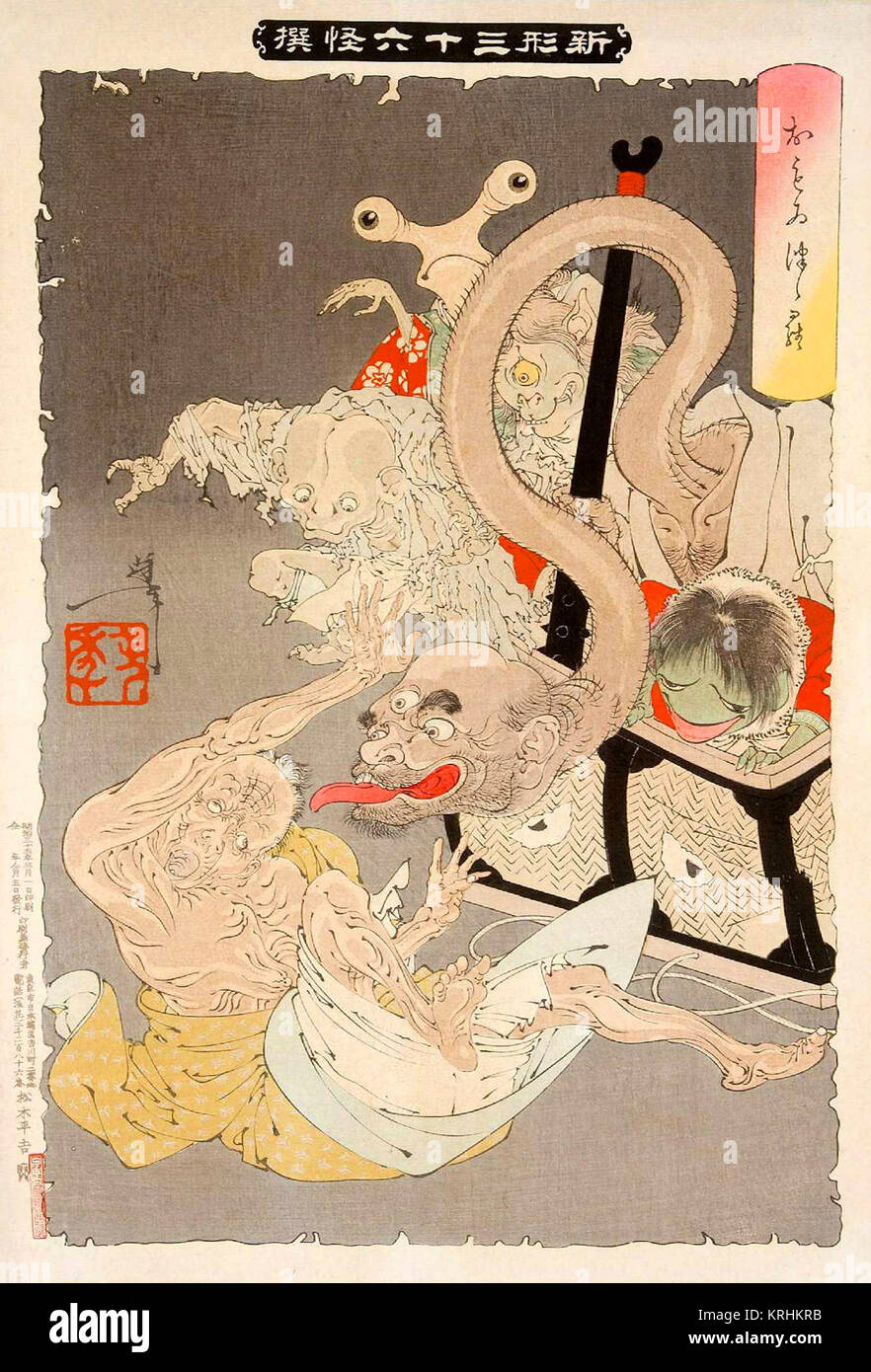 Yokai in a Hamper Stock Photohttps://www.alamy.com/image-license-details/?v=1https://www.alamy.com/stock-image-yokai-in-a-hamper-169419135.html
Yokai in a Hamper Stock Photohttps://www.alamy.com/image-license-details/?v=1https://www.alamy.com/stock-image-yokai-in-a-hamper-169419135.htmlRMKRHKRB–Yokai in a Hamper
 Two Japanese Oni (demons, devils) meeting kids at the Sapporo Snow festival. Stock Photohttps://www.alamy.com/image-license-details/?v=1https://www.alamy.com/stock-photo-two-japanese-oni-demons-devils-meeting-kids-at-the-sapporo-snow-festival-25850906.html
Two Japanese Oni (demons, devils) meeting kids at the Sapporo Snow festival. Stock Photohttps://www.alamy.com/image-license-details/?v=1https://www.alamy.com/stock-photo-two-japanese-oni-demons-devils-meeting-kids-at-the-sapporo-snow-festival-25850906.htmlRMBE1H2J–Two Japanese Oni (demons, devils) meeting kids at the Sapporo Snow festival.
 Otafuku Throwing Black Beans to Chase Away the Demons on New Year’s Eve (Senmen Otafuku zu), 1794/95, Toshusai Sharaku 東洲斎 写楽, Japanese, active 1794-95, Japan, Fan print, stencil-printed color on paper, 21.2 x 40.8 cm Stock Photohttps://www.alamy.com/image-license-details/?v=1https://www.alamy.com/otafuku-throwing-black-beans-to-chase-away-the-demons-on-new-years-eve-senmen-otafuku-zu-179495-toshusai-sharaku-japanese-active-1794-95-japan-fan-print-stencil-printed-color-on-paper-212-x-408-cm-image328639009.html
Otafuku Throwing Black Beans to Chase Away the Demons on New Year’s Eve (Senmen Otafuku zu), 1794/95, Toshusai Sharaku 東洲斎 写楽, Japanese, active 1794-95, Japan, Fan print, stencil-printed color on paper, 21.2 x 40.8 cm Stock Photohttps://www.alamy.com/image-license-details/?v=1https://www.alamy.com/otafuku-throwing-black-beans-to-chase-away-the-demons-on-new-years-eve-senmen-otafuku-zu-179495-toshusai-sharaku-japanese-active-1794-95-japan-fan-print-stencil-printed-color-on-paper-212-x-408-cm-image328639009.htmlRM2A2JPBD–Otafuku Throwing Black Beans to Chase Away the Demons on New Year’s Eve (Senmen Otafuku zu), 1794/95, Toshusai Sharaku 東洲斎 写楽, Japanese, active 1794-95, Japan, Fan print, stencil-printed color on paper, 21.2 x 40.8 cm
 Antique Japanese print depicting Shoki, the tormentor of demons by Kawanabe Ky™sai Man with sword and wild beard, a demon in the left hand. At the top left a second demon flees. Japan c. 1860. Print, paper, woodcut. Stock Photohttps://www.alamy.com/image-license-details/?v=1https://www.alamy.com/antique-japanese-print-depicting-shoki-the-tormentor-of-demons-by-kawanabe-kysai-man-with-sword-and-wild-beard-a-demon-in-the-left-hand-at-the-top-left-a-second-demon-flees-japan-c-1860-print-paper-woodcut-image601444808.html
Antique Japanese print depicting Shoki, the tormentor of demons by Kawanabe Ky™sai Man with sword and wild beard, a demon in the left hand. At the top left a second demon flees. Japan c. 1860. Print, paper, woodcut. Stock Photohttps://www.alamy.com/image-license-details/?v=1https://www.alamy.com/antique-japanese-print-depicting-shoki-the-tormentor-of-demons-by-kawanabe-kysai-man-with-sword-and-wild-beard-a-demon-in-the-left-hand-at-the-top-left-a-second-demon-flees-japan-c-1860-print-paper-woodcut-image601444808.htmlRM2WXE4YM–Antique Japanese print depicting Shoki, the tormentor of demons by Kawanabe Ky™sai Man with sword and wild beard, a demon in the left hand. At the top left a second demon flees. Japan c. 1860. Print, paper, woodcut.
 Exorcising demons in Japan Stock Photohttps://www.alamy.com/image-license-details/?v=1https://www.alamy.com/exorcising-demons-in-japan-image65357302.html
Exorcising demons in Japan Stock Photohttps://www.alamy.com/image-license-details/?v=1https://www.alamy.com/exorcising-demons-in-japan-image65357302.htmlRMDP97WA–Exorcising demons in Japan
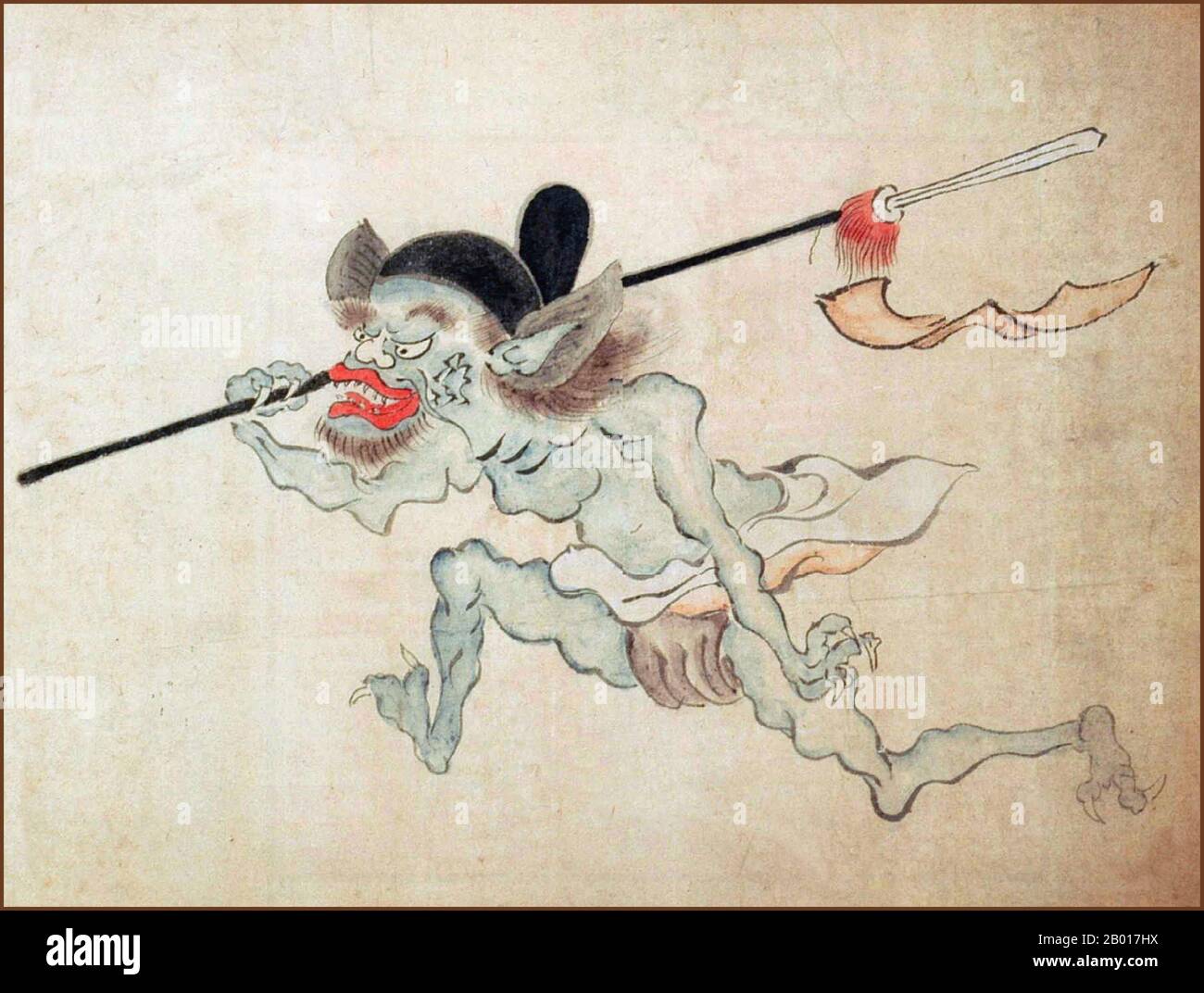 Japan: 'Hyakki Yako (Night Parade of One Hundred Demons)'. Detail of handscroll painting, 19th century. Hyakki Yagyo/Hyakki Yako ('Night Parade of One Hundred Demons') is a Japanese folk belief. The belief holds that every year yokai, Japanese supernatural beings, will take to the streets during summer nights. The procession is sometimes orderly, while at other times it is a riot. Anyone who comes across the procession will die, unless protected by some Buddhist sutra. It is a popular theme in Japanese visual art. Stock Photohttps://www.alamy.com/image-license-details/?v=1https://www.alamy.com/japan-hyakki-yako-night-parade-of-one-hundred-demons-detail-of-handscroll-painting-19th-century-hyakki-yagyohyakki-yako-night-parade-of-one-hundred-demons-is-a-japanese-folk-belief-the-belief-holds-that-every-year-yokai-japanese-supernatural-beings-will-take-to-the-streets-during-summer-nights-the-procession-is-sometimes-orderly-while-at-other-times-it-is-a-riot-anyone-who-comes-across-the-procession-will-die-unless-protected-by-some-buddhist-sutra-it-is-a-popular-theme-in-japanese-visual-art-image344235302.html
Japan: 'Hyakki Yako (Night Parade of One Hundred Demons)'. Detail of handscroll painting, 19th century. Hyakki Yagyo/Hyakki Yako ('Night Parade of One Hundred Demons') is a Japanese folk belief. The belief holds that every year yokai, Japanese supernatural beings, will take to the streets during summer nights. The procession is sometimes orderly, while at other times it is a riot. Anyone who comes across the procession will die, unless protected by some Buddhist sutra. It is a popular theme in Japanese visual art. Stock Photohttps://www.alamy.com/image-license-details/?v=1https://www.alamy.com/japan-hyakki-yako-night-parade-of-one-hundred-demons-detail-of-handscroll-painting-19th-century-hyakki-yagyohyakki-yako-night-parade-of-one-hundred-demons-is-a-japanese-folk-belief-the-belief-holds-that-every-year-yokai-japanese-supernatural-beings-will-take-to-the-streets-during-summer-nights-the-procession-is-sometimes-orderly-while-at-other-times-it-is-a-riot-anyone-who-comes-across-the-procession-will-die-unless-protected-by-some-buddhist-sutra-it-is-a-popular-theme-in-japanese-visual-art-image344235302.htmlRM2B017HX–Japan: 'Hyakki Yako (Night Parade of One Hundred Demons)'. Detail of handscroll painting, 19th century. Hyakki Yagyo/Hyakki Yako ('Night Parade of One Hundred Demons') is a Japanese folk belief. The belief holds that every year yokai, Japanese supernatural beings, will take to the streets during summer nights. The procession is sometimes orderly, while at other times it is a riot. Anyone who comes across the procession will die, unless protected by some Buddhist sutra. It is a popular theme in Japanese visual art.
 Monsters in the Sky Stock Photohttps://www.alamy.com/image-license-details/?v=1https://www.alamy.com/monsters-in-the-sky-image179280490.html
Monsters in the Sky Stock Photohttps://www.alamy.com/image-license-details/?v=1https://www.alamy.com/monsters-in-the-sky-image179280490.htmlRMMBJX2J–Monsters in the Sky
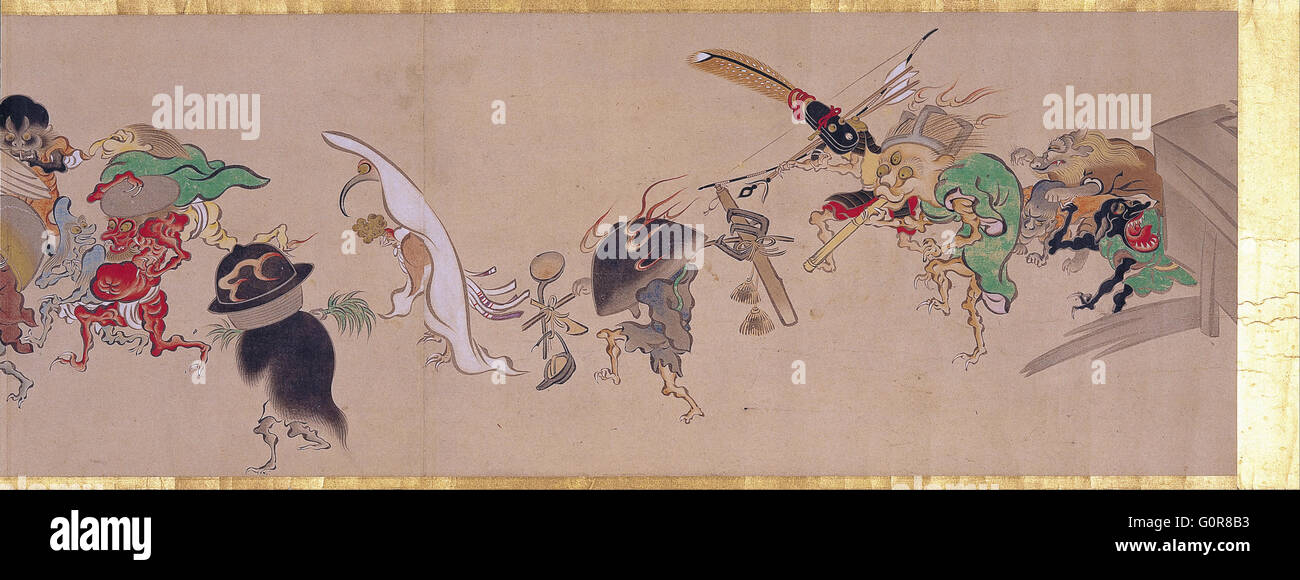 Night Parade of a Hundred Demons - Osaka City Museum of Fine Arts Stock Photohttps://www.alamy.com/image-license-details/?v=1https://www.alamy.com/stock-photo-night-parade-of-a-hundred-demons-osaka-city-museum-of-fine-arts-103773687.html
Night Parade of a Hundred Demons - Osaka City Museum of Fine Arts Stock Photohttps://www.alamy.com/image-license-details/?v=1https://www.alamy.com/stock-photo-night-parade-of-a-hundred-demons-osaka-city-museum-of-fine-arts-103773687.htmlRMG0R8B3–Night Parade of a Hundred Demons - Osaka City Museum of Fine Arts
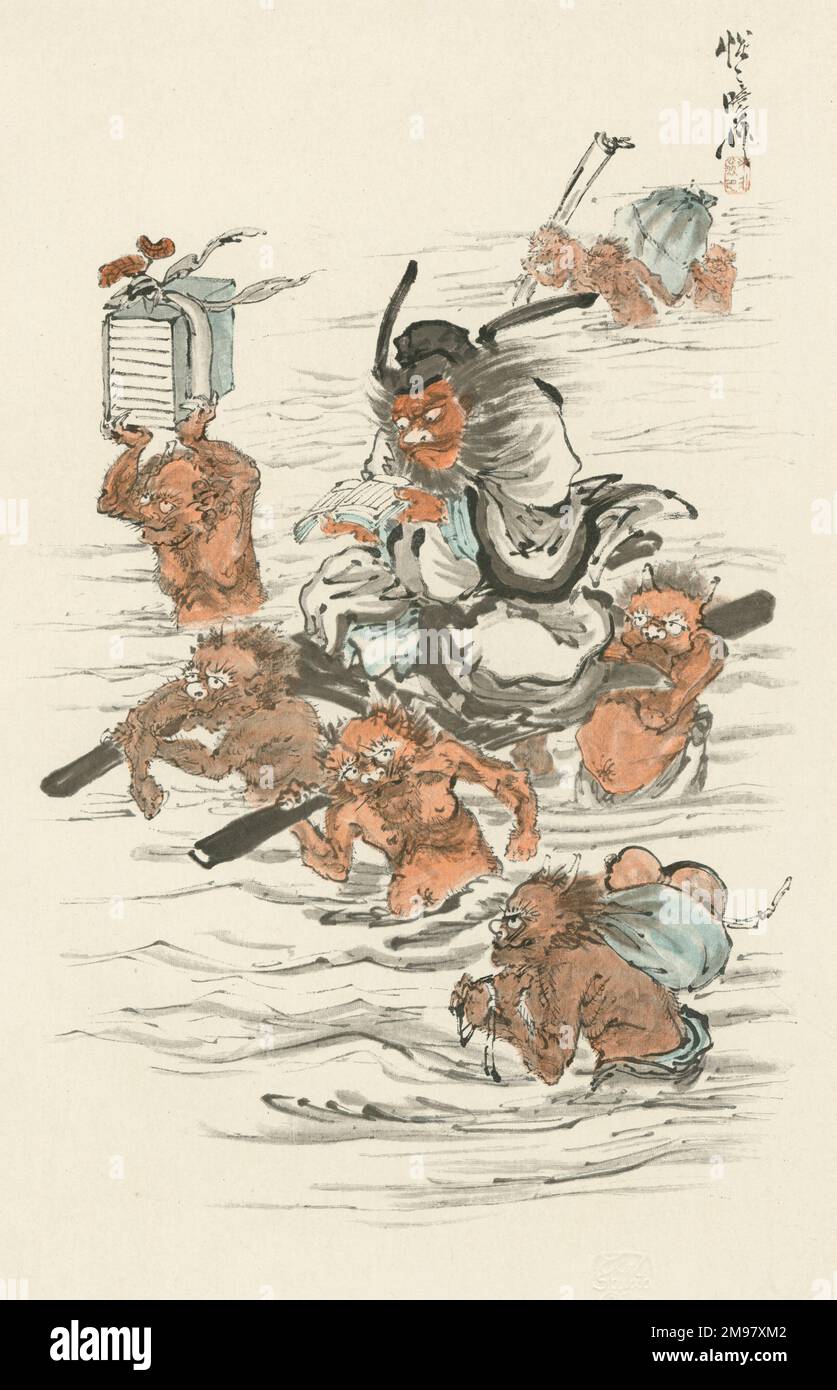 Shoki and Attendant Demons. Stock Photohttps://www.alamy.com/image-license-details/?v=1https://www.alamy.com/shoki-and-attendant-demons-image504807186.html
Shoki and Attendant Demons. Stock Photohttps://www.alamy.com/image-license-details/?v=1https://www.alamy.com/shoki-and-attendant-demons-image504807186.htmlRM2M97XM2–Shoki and Attendant Demons.
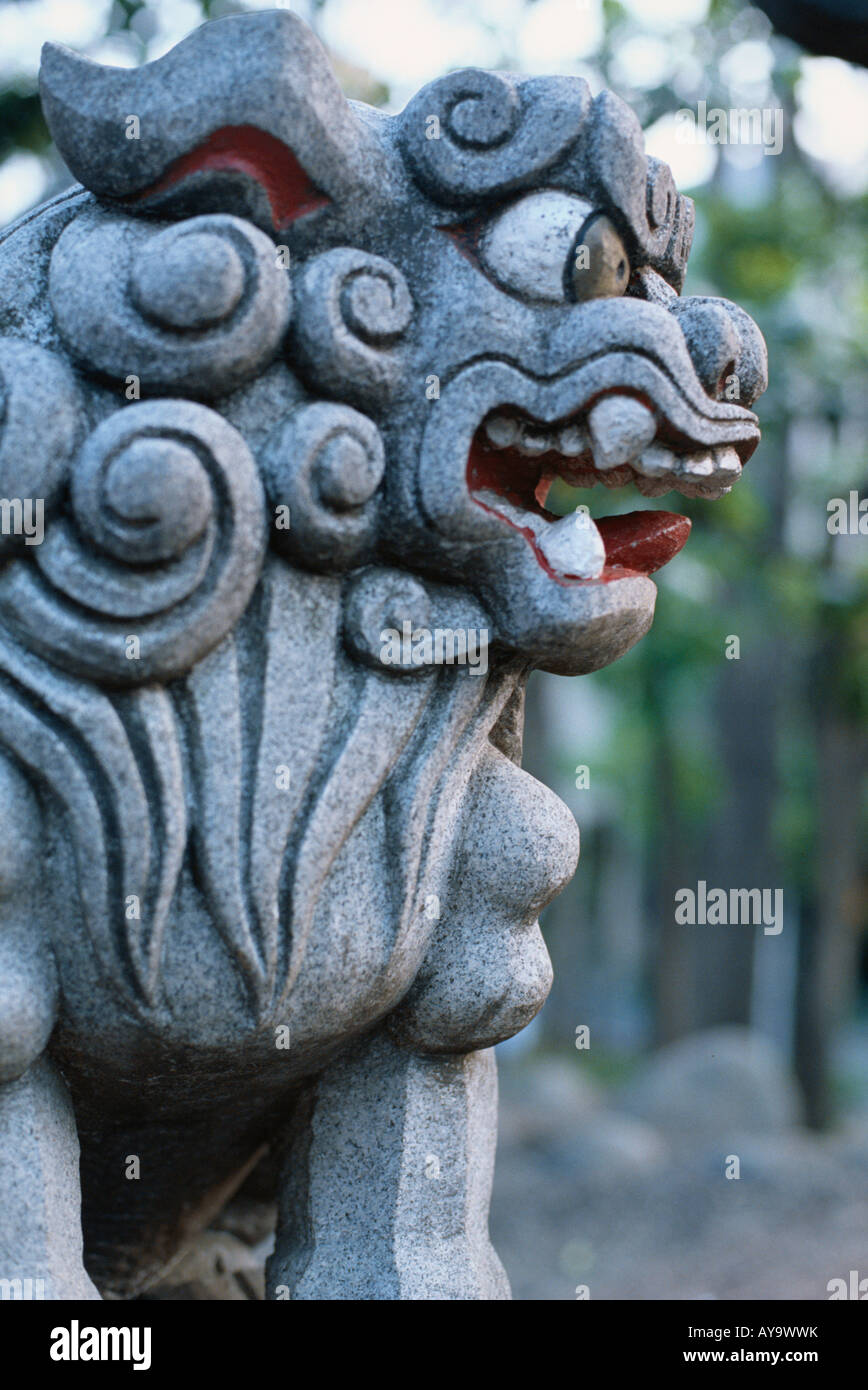 Japanese Stone Sculpture Stock Photohttps://www.alamy.com/image-license-details/?v=1https://www.alamy.com/stock-photo-japanese-stone-sculpture-17040318.html
Japanese Stone Sculpture Stock Photohttps://www.alamy.com/image-license-details/?v=1https://www.alamy.com/stock-photo-japanese-stone-sculpture-17040318.htmlRFAY9WWK–Japanese Stone Sculpture
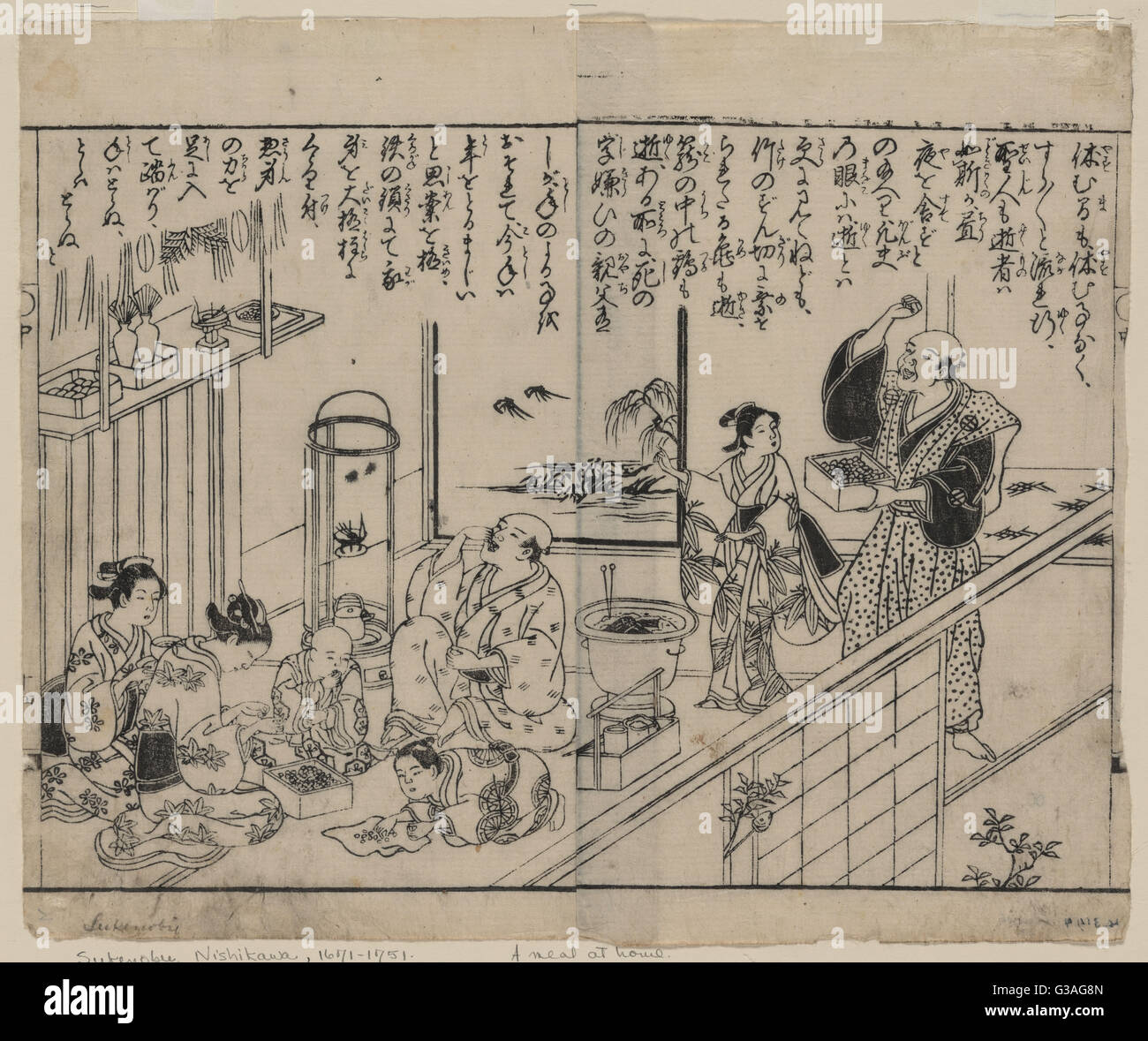 Mamemaki: expelling demons with beans Stock Photohttps://www.alamy.com/image-license-details/?v=1https://www.alamy.com/stock-photo-mamemaki-expelling-demons-with-beans-105338485.html
Mamemaki: expelling demons with beans Stock Photohttps://www.alamy.com/image-license-details/?v=1https://www.alamy.com/stock-photo-mamemaki-expelling-demons-with-beans-105338485.htmlRMG3AG8N–Mamemaki: expelling demons with beans
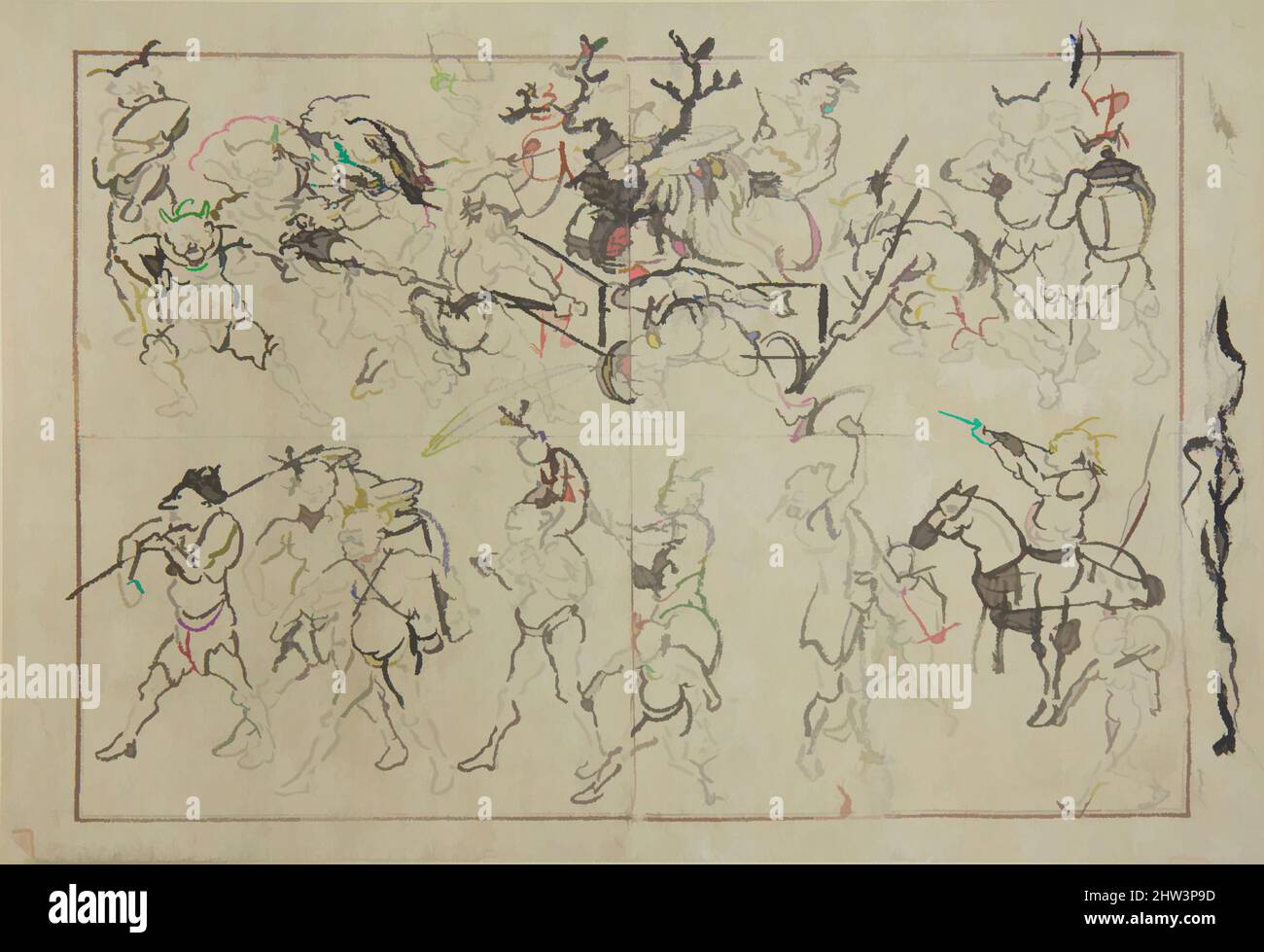 Art inspired by Preliminary Drawings of Demons, Meiji period (1868–1912), late 19th century, Japan, On paper, 9 1/8 x 13 1/4 in. (23.2 x 33.7 cm), Paintings, Kawanabe Kyōsai (Japanese, 1831–1889), These sketches in the distinctive drawing style of Kawanabe Kyōsai appear to be, Classic works modernized by Artotop with a splash of modernity. Shapes, color and value, eye-catching visual impact on art. Emotions through freedom of artworks in a contemporary way. A timeless message pursuing a wildly creative new direction. Artists turning to the digital medium and creating the Artotop NFT Stock Photohttps://www.alamy.com/image-license-details/?v=1https://www.alamy.com/art-inspired-by-preliminary-drawings-of-demons-meiji-period-18681912-late-19th-century-japan-on-paper-9-18-x-13-14-in-232-x-337-cm-paintings-kawanabe-kysai-japanese-18311889-these-sketches-in-the-distinctive-drawing-style-of-kawanabe-kysai-appear-to-be-classic-works-modernized-by-artotop-with-a-splash-of-modernity-shapes-color-and-value-eye-catching-visual-impact-on-art-emotions-through-freedom-of-artworks-in-a-contemporary-way-a-timeless-message-pursuing-a-wildly-creative-new-direction-artists-turning-to-the-digital-medium-and-creating-the-artotop-nft-image462919337.html
Art inspired by Preliminary Drawings of Demons, Meiji period (1868–1912), late 19th century, Japan, On paper, 9 1/8 x 13 1/4 in. (23.2 x 33.7 cm), Paintings, Kawanabe Kyōsai (Japanese, 1831–1889), These sketches in the distinctive drawing style of Kawanabe Kyōsai appear to be, Classic works modernized by Artotop with a splash of modernity. Shapes, color and value, eye-catching visual impact on art. Emotions through freedom of artworks in a contemporary way. A timeless message pursuing a wildly creative new direction. Artists turning to the digital medium and creating the Artotop NFT Stock Photohttps://www.alamy.com/image-license-details/?v=1https://www.alamy.com/art-inspired-by-preliminary-drawings-of-demons-meiji-period-18681912-late-19th-century-japan-on-paper-9-18-x-13-14-in-232-x-337-cm-paintings-kawanabe-kysai-japanese-18311889-these-sketches-in-the-distinctive-drawing-style-of-kawanabe-kysai-appear-to-be-classic-works-modernized-by-artotop-with-a-splash-of-modernity-shapes-color-and-value-eye-catching-visual-impact-on-art-emotions-through-freedom-of-artworks-in-a-contemporary-way-a-timeless-message-pursuing-a-wildly-creative-new-direction-artists-turning-to-the-digital-medium-and-creating-the-artotop-nft-image462919337.htmlRF2HW3P9D–Art inspired by Preliminary Drawings of Demons, Meiji period (1868–1912), late 19th century, Japan, On paper, 9 1/8 x 13 1/4 in. (23.2 x 33.7 cm), Paintings, Kawanabe Kyōsai (Japanese, 1831–1889), These sketches in the distinctive drawing style of Kawanabe Kyōsai appear to be, Classic works modernized by Artotop with a splash of modernity. Shapes, color and value, eye-catching visual impact on art. Emotions through freedom of artworks in a contemporary way. A timeless message pursuing a wildly creative new direction. Artists turning to the digital medium and creating the Artotop NFT
 'Shoki and the Demons', c1880 (1886).Artist: Wilhelm Greve Stock Photohttps://www.alamy.com/image-license-details/?v=1https://www.alamy.com/shoki-and-the-demons-c1880-1886artist-wilhelm-greve-image262764734.html
'Shoki and the Demons', c1880 (1886).Artist: Wilhelm Greve Stock Photohttps://www.alamy.com/image-license-details/?v=1https://www.alamy.com/shoki-and-the-demons-c1880-1886artist-wilhelm-greve-image262764734.htmlRMW7DY2P–'Shoki and the Demons', c1880 (1886).Artist: Wilhelm Greve
 Japanese Tsugaru Shamisen Players and Dancers from Japan performing and dancing Traditional Sword Dance of Demons on Stage Stock Photohttps://www.alamy.com/image-license-details/?v=1https://www.alamy.com/japanese-tsugaru-shamisen-players-and-dancers-from-japan-performing-image3609954.html
Japanese Tsugaru Shamisen Players and Dancers from Japan performing and dancing Traditional Sword Dance of Demons on Stage Stock Photohttps://www.alamy.com/image-license-details/?v=1https://www.alamy.com/japanese-tsugaru-shamisen-players-and-dancers-from-japan-performing-image3609954.htmlRMA4HW63–Japanese Tsugaru Shamisen Players and Dancers from Japan performing and dancing Traditional Sword Dance of Demons on Stage
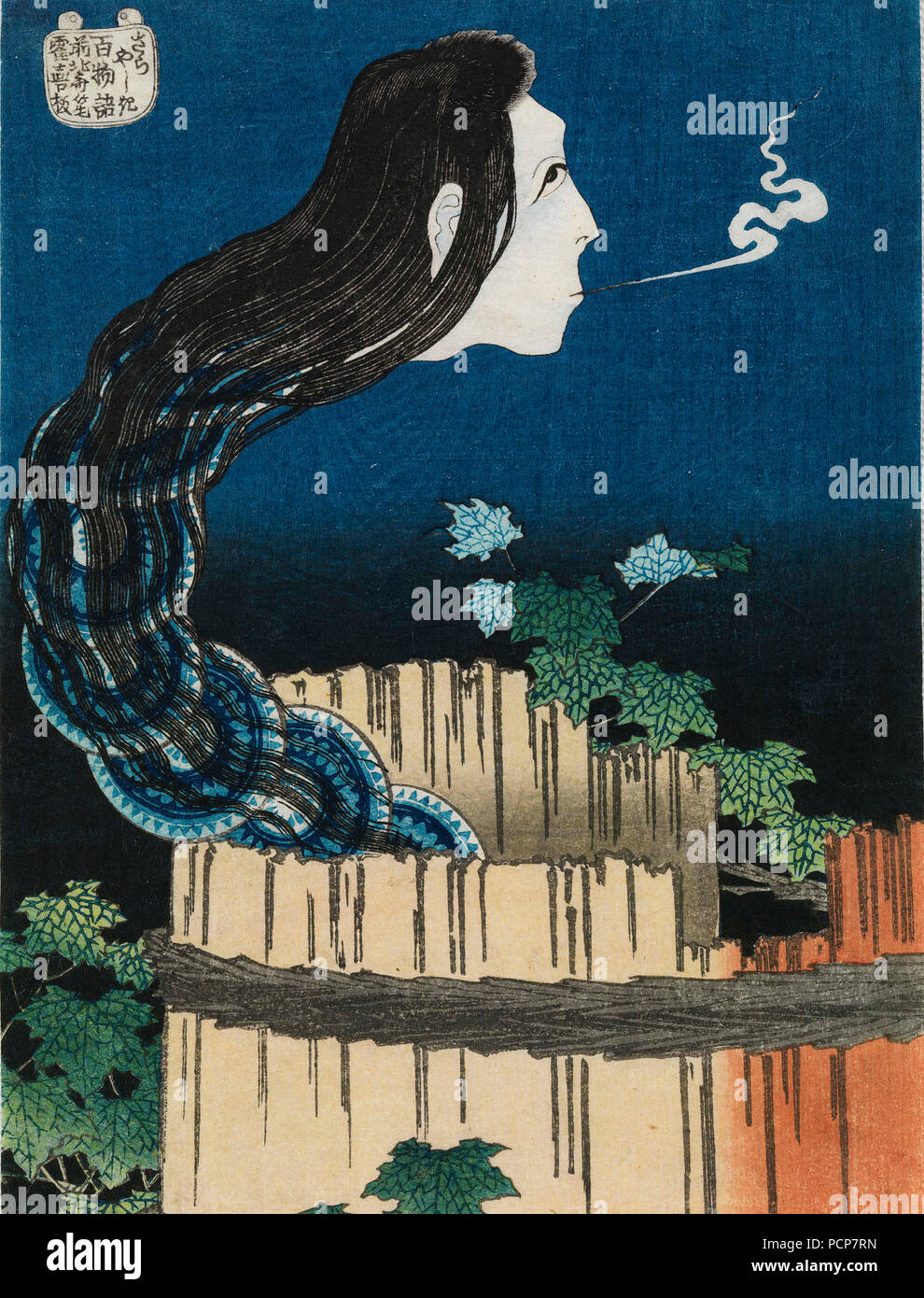 The Mansion of the Plates (Sara yashiki), from the series One Hundred Ghost Stories (Hyaku monogatar Stock Photohttps://www.alamy.com/image-license-details/?v=1https://www.alamy.com/the-mansion-of-the-plates-sara-yashiki-from-the-series-one-hundred-ghost-stories-hyaku-monogatar-image214389385.html
The Mansion of the Plates (Sara yashiki), from the series One Hundred Ghost Stories (Hyaku monogatar Stock Photohttps://www.alamy.com/image-license-details/?v=1https://www.alamy.com/the-mansion-of-the-plates-sara-yashiki-from-the-series-one-hundred-ghost-stories-hyaku-monogatar-image214389385.htmlRMPCP7RN–The Mansion of the Plates (Sara yashiki), from the series One Hundred Ghost Stories (Hyaku monogatar
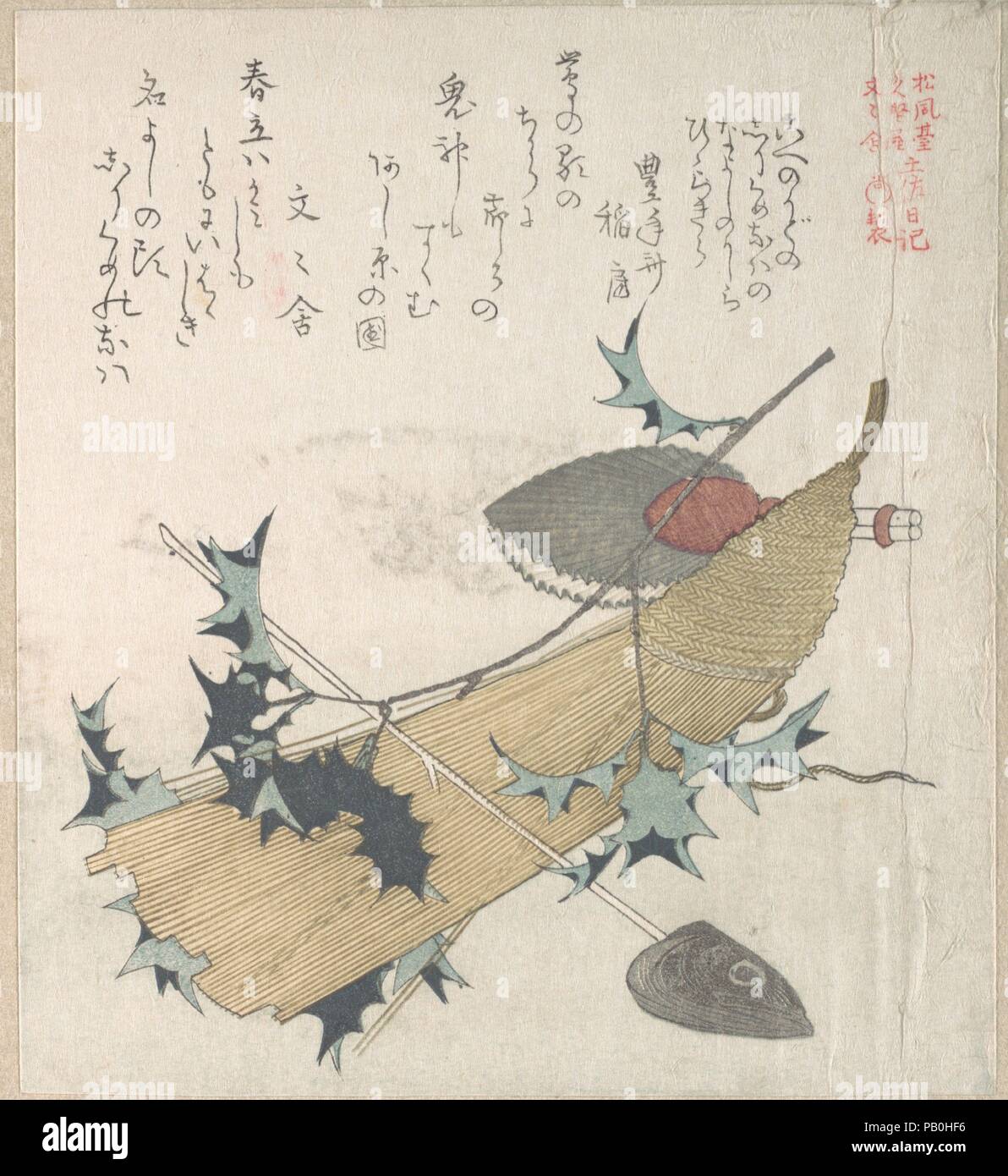 Objects Representing the Ceremony of Exorcising Demons, One of the New Year Performances. Artist: Kubo Shunman (Japanese, 1757-1820) (?). Culture: Japan. Dimensions: 7 15/16 x 7 1/8 in. (20.2 x 18.1 cm). Date: 19th century. Museum: Metropolitan Museum of Art, New York, USA. Stock Photohttps://www.alamy.com/image-license-details/?v=1https://www.alamy.com/objects-representing-the-ceremony-of-exorcising-demons-one-of-the-new-year-performances-artist-kubo-shunman-japanese-1757-1820-culture-japan-dimensions-7-1516-x-7-18-in-202-x-181-cm-date-19th-century-museum-metropolitan-museum-of-art-new-york-usa-image213299386.html
Objects Representing the Ceremony of Exorcising Demons, One of the New Year Performances. Artist: Kubo Shunman (Japanese, 1757-1820) (?). Culture: Japan. Dimensions: 7 15/16 x 7 1/8 in. (20.2 x 18.1 cm). Date: 19th century. Museum: Metropolitan Museum of Art, New York, USA. Stock Photohttps://www.alamy.com/image-license-details/?v=1https://www.alamy.com/objects-representing-the-ceremony-of-exorcising-demons-one-of-the-new-year-performances-artist-kubo-shunman-japanese-1757-1820-culture-japan-dimensions-7-1516-x-7-18-in-202-x-181-cm-date-19th-century-museum-metropolitan-museum-of-art-new-york-usa-image213299386.htmlRMPB0HF6–Objects Representing the Ceremony of Exorcising Demons, One of the New Year Performances. Artist: Kubo Shunman (Japanese, 1757-1820) (?). Culture: Japan. Dimensions: 7 15/16 x 7 1/8 in. (20.2 x 18.1 cm). Date: 19th century. Museum: Metropolitan Museum of Art, New York, USA.
 Oni or Japanese Devil at Noboribetsu Springs in Hokkaido Stock Photohttps://www.alamy.com/image-license-details/?v=1https://www.alamy.com/stock-photo-oni-or-japanese-devil-at-noboribetsu-springs-in-hokkaido-24033203.html
Oni or Japanese Devil at Noboribetsu Springs in Hokkaido Stock Photohttps://www.alamy.com/image-license-details/?v=1https://www.alamy.com/stock-photo-oni-or-japanese-devil-at-noboribetsu-springs-in-hokkaido-24033203.htmlRMBB2PGK–Oni or Japanese Devil at Noboribetsu Springs in Hokkaido
 Japan, Kyushu, Taketa. Mask above Doorway to Guard against Demons. Stock Photohttps://www.alamy.com/image-license-details/?v=1https://www.alamy.com/japan-kyushu-taketa-mask-above-doorway-to-guard-against-demons-image563523144.html
Japan, Kyushu, Taketa. Mask above Doorway to Guard against Demons. Stock Photohttps://www.alamy.com/image-license-details/?v=1https://www.alamy.com/japan-kyushu-taketa-mask-above-doorway-to-guard-against-demons-image563523144.htmlRM2RMPKEG–Japan, Kyushu, Taketa. Mask above Doorway to Guard against Demons.
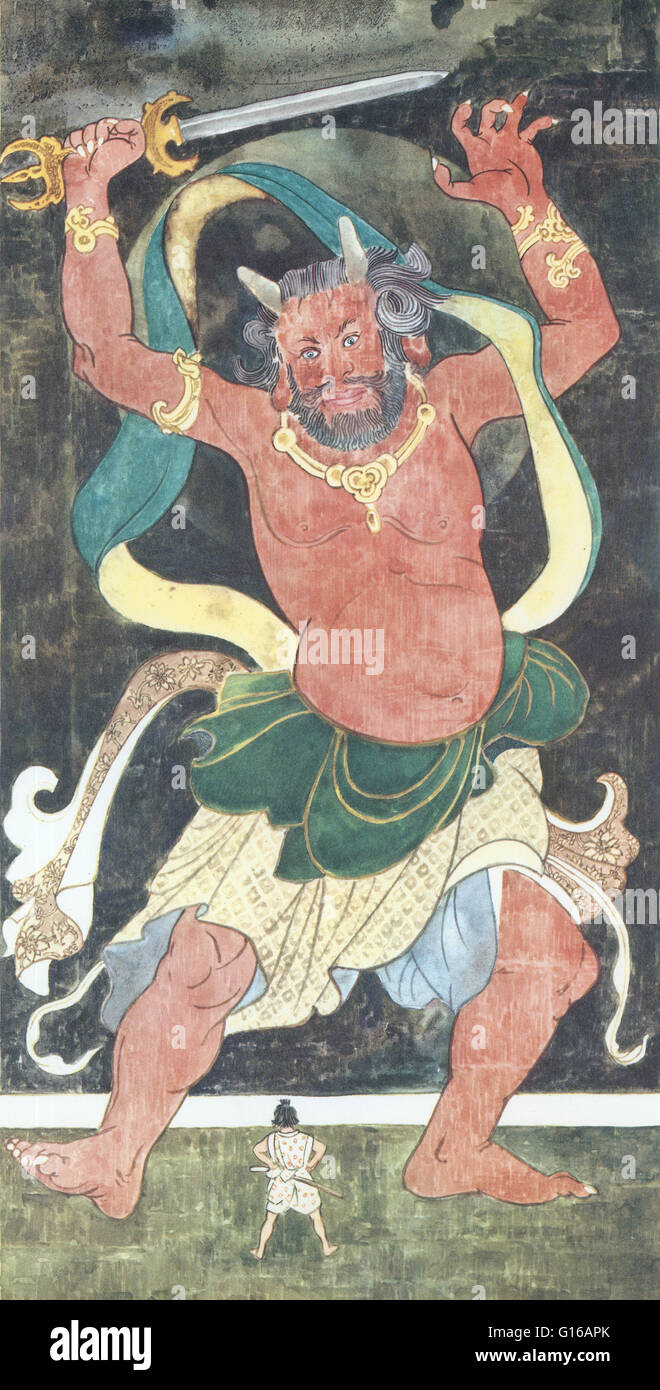 Oni are a kind of yokai from Japanese folklore, variously translated as demons, devils, ogres or trolls. Depictions of oni vary widely but usually portray them as hideous, gigantic ogre-like creatures with sharp claws, wild hair, and two long horns growin Stock Photohttps://www.alamy.com/image-license-details/?v=1https://www.alamy.com/stock-photo-oni-are-a-kind-of-yokai-from-japanese-folklore-variously-translated-104017051.html
Oni are a kind of yokai from Japanese folklore, variously translated as demons, devils, ogres or trolls. Depictions of oni vary widely but usually portray them as hideous, gigantic ogre-like creatures with sharp claws, wild hair, and two long horns growin Stock Photohttps://www.alamy.com/image-license-details/?v=1https://www.alamy.com/stock-photo-oni-are-a-kind-of-yokai-from-japanese-folklore-variously-translated-104017051.htmlRMG16APK–Oni are a kind of yokai from Japanese folklore, variously translated as demons, devils, ogres or trolls. Depictions of oni vary widely but usually portray them as hideous, gigantic ogre-like creatures with sharp claws, wild hair, and two long horns growin
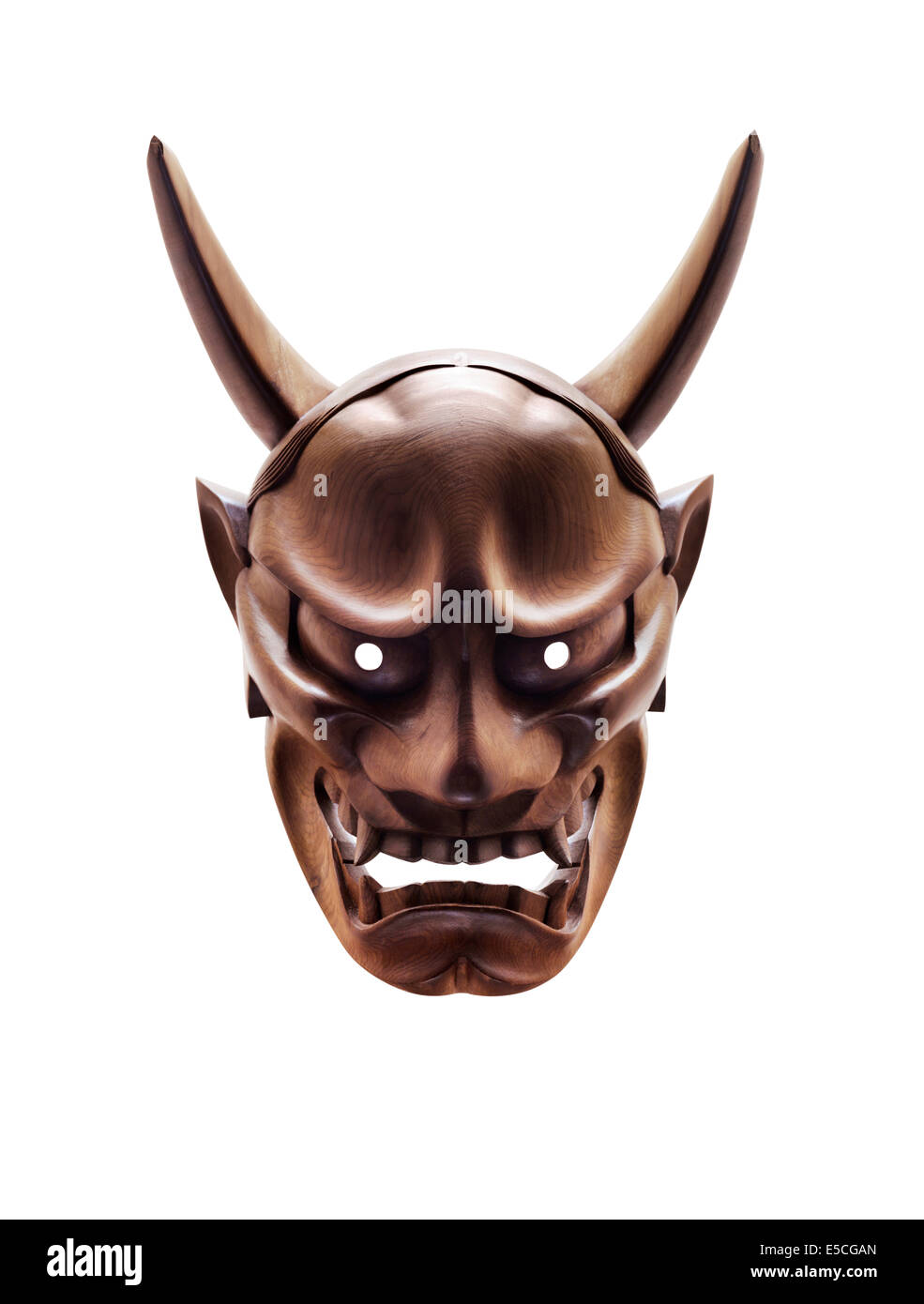 The Hannya wooden mask used in Japanese Noh theater, representing a jealous female demon. Isolated on white background with clip Stock Photohttps://www.alamy.com/image-license-details/?v=1https://www.alamy.com/stock-photo-the-hannya-wooden-mask-used-in-japanese-noh-theater-representing-a-72191021.html
The Hannya wooden mask used in Japanese Noh theater, representing a jealous female demon. Isolated on white background with clip Stock Photohttps://www.alamy.com/image-license-details/?v=1https://www.alamy.com/stock-photo-the-hannya-wooden-mask-used-in-japanese-noh-theater-representing-a-72191021.htmlRFE5CGAN–The Hannya wooden mask used in Japanese Noh theater, representing a jealous female demon. Isolated on white background with clip
 Two Japanese Oni (demons, devils) meeting kids at the Sapporo Snow festival. Stock Photohttps://www.alamy.com/image-license-details/?v=1https://www.alamy.com/stock-photo-two-japanese-oni-demons-devils-meeting-kids-at-the-sapporo-snow-festival-25850926.html
Two Japanese Oni (demons, devils) meeting kids at the Sapporo Snow festival. Stock Photohttps://www.alamy.com/image-license-details/?v=1https://www.alamy.com/stock-photo-two-japanese-oni-demons-devils-meeting-kids-at-the-sapporo-snow-festival-25850926.htmlRMBE1H3A–Two Japanese Oni (demons, devils) meeting kids at the Sapporo Snow festival.
 Kawanabe Kyōsai, Kyōsai’s Pictures of One Hundred Demons (Kyōsai Hyakkigadan), Japan, Meiji period (1868–1912), Kawanabe Kyōsai (Japanese, 1831–1889), 1890, Japan, Woodblock printed book (orihon, accordion-style binding); ink and color on paper, 8 1/4 × 4 13/16 in. (21 × 12.2 cm), Illustrated Books Stock Photohttps://www.alamy.com/image-license-details/?v=1https://www.alamy.com/kawanabe-kysai-kysais-pictures-of-one-hundred-demons-kysai-hyakkigadan-japan-meiji-period-18681912-kawanabe-kysai-japanese-18311889-1890-japan-woodblock-printed-book-orihon-accordion-style-binding-ink-and-color-on-paper-8-14-4-1316-in-21-122-cm-illustrated-books-image344665040.html
Kawanabe Kyōsai, Kyōsai’s Pictures of One Hundred Demons (Kyōsai Hyakkigadan), Japan, Meiji period (1868–1912), Kawanabe Kyōsai (Japanese, 1831–1889), 1890, Japan, Woodblock printed book (orihon, accordion-style binding); ink and color on paper, 8 1/4 × 4 13/16 in. (21 × 12.2 cm), Illustrated Books Stock Photohttps://www.alamy.com/image-license-details/?v=1https://www.alamy.com/kawanabe-kysai-kysais-pictures-of-one-hundred-demons-kysai-hyakkigadan-japan-meiji-period-18681912-kawanabe-kysai-japanese-18311889-1890-japan-woodblock-printed-book-orihon-accordion-style-binding-ink-and-color-on-paper-8-14-4-1316-in-21-122-cm-illustrated-books-image344665040.htmlRM2B0MRNM–Kawanabe Kyōsai, Kyōsai’s Pictures of One Hundred Demons (Kyōsai Hyakkigadan), Japan, Meiji period (1868–1912), Kawanabe Kyōsai (Japanese, 1831–1889), 1890, Japan, Woodblock printed book (orihon, accordion-style binding); ink and color on paper, 8 1/4 × 4 13/16 in. (21 × 12.2 cm), Illustrated Books
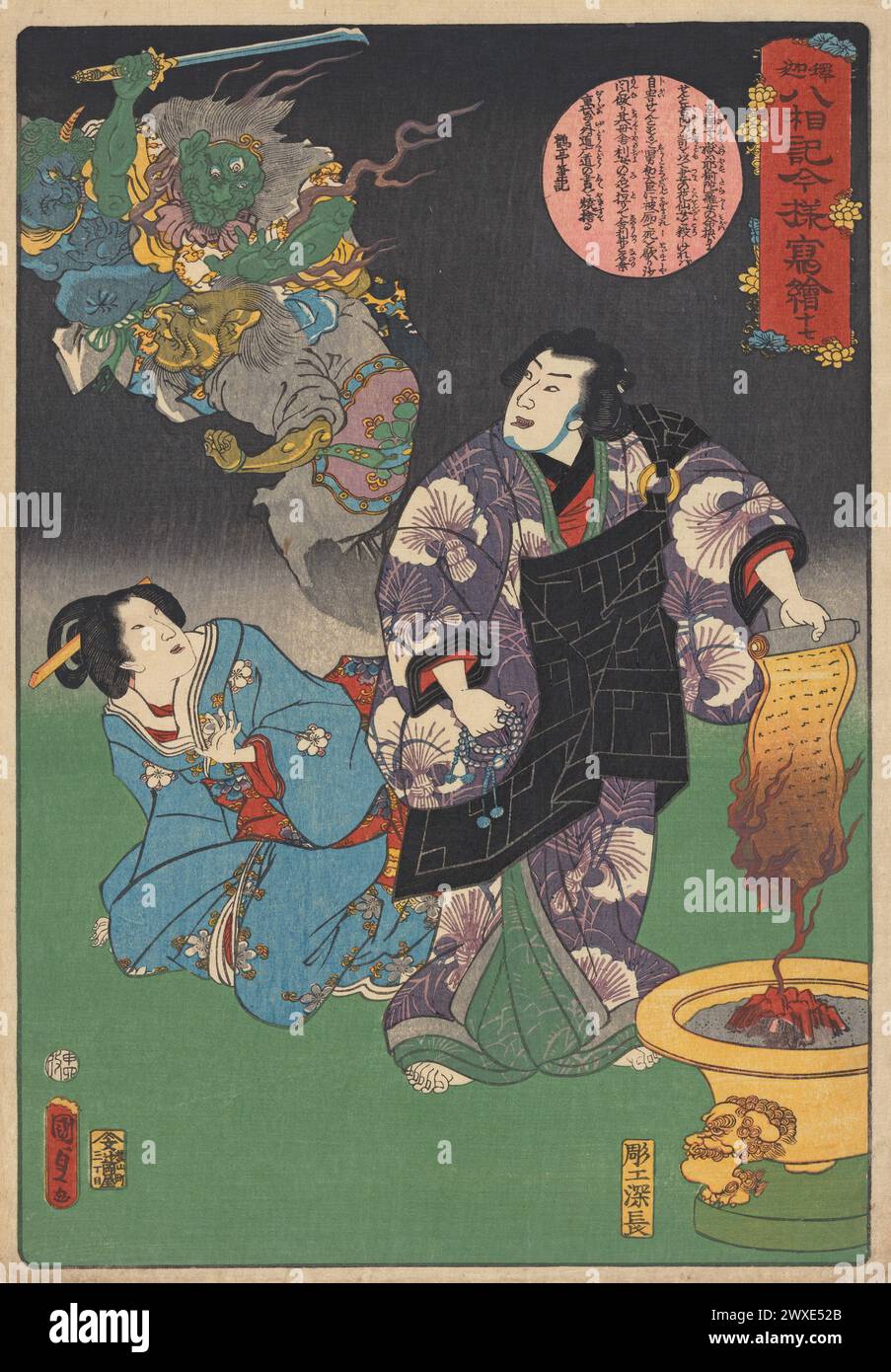 Japanese printed woodcut - The life of the Buddha in modern magic lantern slides A priest burns a manuscript over a brazier in the presence of a seated woman. His robe is decorated with a motif of bundled leaves that resemble skulls. In the background, demons with three horns and three eyes fly away. Artist: Kunisada Utagawa print maker: Fukagawa Ch™jir™ publisher: Tsujiokaya Bunsuke, Japan, Jun-1860 Stock Photohttps://www.alamy.com/image-license-details/?v=1https://www.alamy.com/japanese-printed-woodcut-the-life-of-the-buddha-in-modern-magic-lantern-slides-a-priest-burns-a-manuscript-over-a-brazier-in-the-presence-of-a-seated-woman-his-robe-is-decorated-with-a-motif-of-bundled-leaves-that-resemble-skulls-in-the-background-demons-with-three-horns-and-three-eyes-fly-away-artist-kunisada-utagawa-print-maker-fukagawa-chjir-publisher-tsujiokaya-bunsuke-japan-jun-1860-image601444883.html
Japanese printed woodcut - The life of the Buddha in modern magic lantern slides A priest burns a manuscript over a brazier in the presence of a seated woman. His robe is decorated with a motif of bundled leaves that resemble skulls. In the background, demons with three horns and three eyes fly away. Artist: Kunisada Utagawa print maker: Fukagawa Ch™jir™ publisher: Tsujiokaya Bunsuke, Japan, Jun-1860 Stock Photohttps://www.alamy.com/image-license-details/?v=1https://www.alamy.com/japanese-printed-woodcut-the-life-of-the-buddha-in-modern-magic-lantern-slides-a-priest-burns-a-manuscript-over-a-brazier-in-the-presence-of-a-seated-woman-his-robe-is-decorated-with-a-motif-of-bundled-leaves-that-resemble-skulls-in-the-background-demons-with-three-horns-and-three-eyes-fly-away-artist-kunisada-utagawa-print-maker-fukagawa-chjir-publisher-tsujiokaya-bunsuke-japan-jun-1860-image601444883.htmlRM2WXE52B–Japanese printed woodcut - The life of the Buddha in modern magic lantern slides A priest burns a manuscript over a brazier in the presence of a seated woman. His robe is decorated with a motif of bundled leaves that resemble skulls. In the background, demons with three horns and three eyes fly away. Artist: Kunisada Utagawa print maker: Fukagawa Ch™jir™ publisher: Tsujiokaya Bunsuke, Japan, Jun-1860
 Ryugujo (Dragon King's palace). Yoshitoshi Taiso, 1839-1892, artist. Published Print shows the warrior Watanabe no Tsuna, with bow and arrows, at the palace of the demon Ibaraki. 1885 Stock Photohttps://www.alamy.com/image-license-details/?v=1https://www.alamy.com/ryugujo-dragon-kings-palace-yoshitoshi-taiso-1839-1892-artist-published-image68557330.html
Ryugujo (Dragon King's palace). Yoshitoshi Taiso, 1839-1892, artist. Published Print shows the warrior Watanabe no Tsuna, with bow and arrows, at the palace of the demon Ibaraki. 1885 Stock Photohttps://www.alamy.com/image-license-details/?v=1https://www.alamy.com/ryugujo-dragon-kings-palace-yoshitoshi-taiso-1839-1892-artist-published-image68557330.htmlRMDYF1G2–Ryugujo (Dragon King's palace). Yoshitoshi Taiso, 1839-1892, artist. Published Print shows the warrior Watanabe no Tsuna, with bow and arrows, at the palace of the demon Ibaraki. 1885
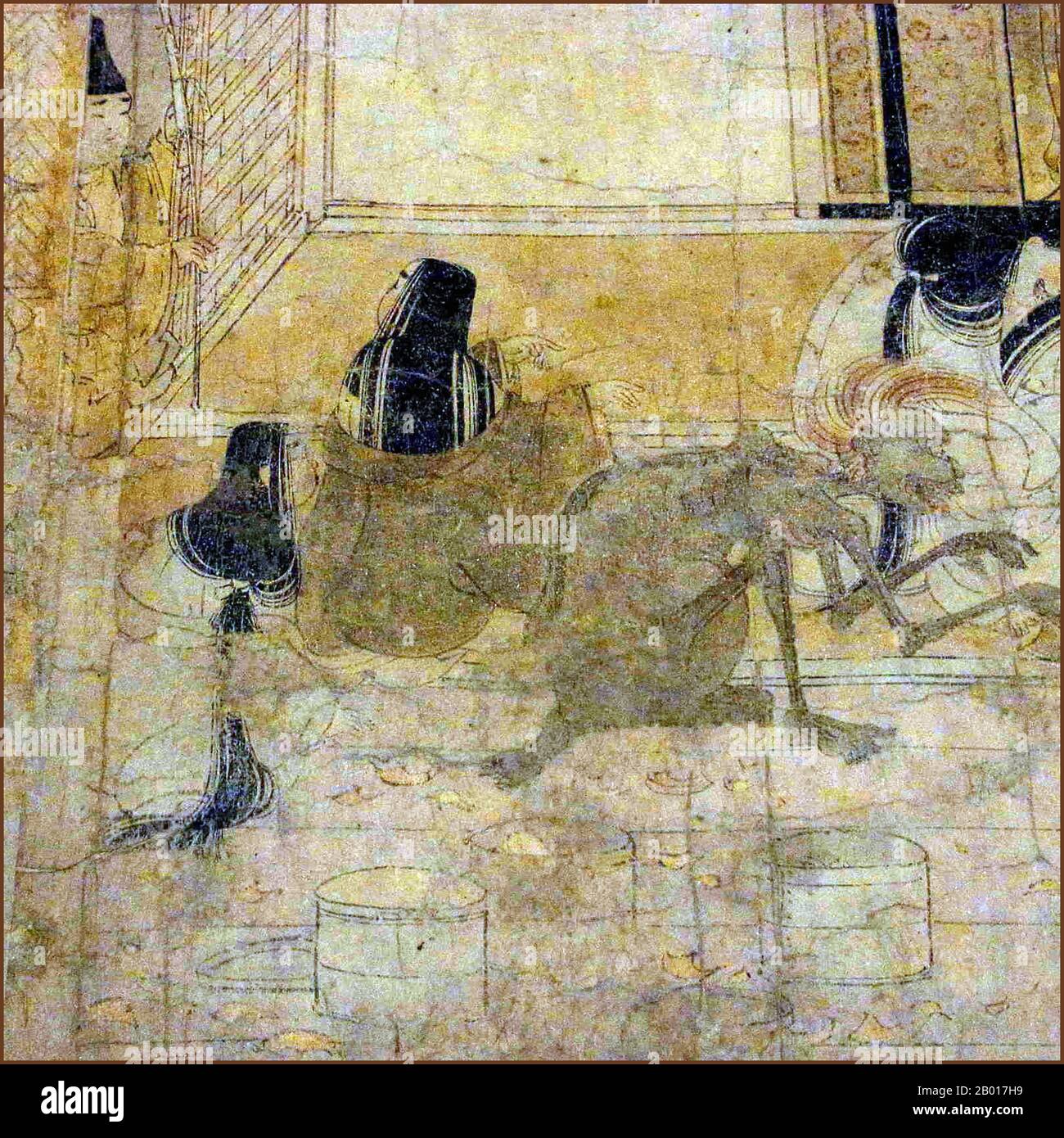 Japan: 'Hyakki Yako (Night Parade of One Hundred Demons)'. Detail of handscroll painting, 18th century. Hyakki Yagyo/Hyakki Yako ('Night Parade of One Hundred Demons') is a Japanese folk belief. The belief holds that every year yokai, Japanese supernatural beings, will take to the streets during summer nights. The procession is sometimes orderly, while at other times it is a riot. Anyone who comes across the procession will die, unless protected by some Buddhist sutra. It is a popular theme in Japanese visual art. Stock Photohttps://www.alamy.com/image-license-details/?v=1https://www.alamy.com/japan-hyakki-yako-night-parade-of-one-hundred-demons-detail-of-handscroll-painting-18th-century-hyakki-yagyohyakki-yako-night-parade-of-one-hundred-demons-is-a-japanese-folk-belief-the-belief-holds-that-every-year-yokai-japanese-supernatural-beings-will-take-to-the-streets-during-summer-nights-the-procession-is-sometimes-orderly-while-at-other-times-it-is-a-riot-anyone-who-comes-across-the-procession-will-die-unless-protected-by-some-buddhist-sutra-it-is-a-popular-theme-in-japanese-visual-art-image344235285.html
Japan: 'Hyakki Yako (Night Parade of One Hundred Demons)'. Detail of handscroll painting, 18th century. Hyakki Yagyo/Hyakki Yako ('Night Parade of One Hundred Demons') is a Japanese folk belief. The belief holds that every year yokai, Japanese supernatural beings, will take to the streets during summer nights. The procession is sometimes orderly, while at other times it is a riot. Anyone who comes across the procession will die, unless protected by some Buddhist sutra. It is a popular theme in Japanese visual art. Stock Photohttps://www.alamy.com/image-license-details/?v=1https://www.alamy.com/japan-hyakki-yako-night-parade-of-one-hundred-demons-detail-of-handscroll-painting-18th-century-hyakki-yagyohyakki-yako-night-parade-of-one-hundred-demons-is-a-japanese-folk-belief-the-belief-holds-that-every-year-yokai-japanese-supernatural-beings-will-take-to-the-streets-during-summer-nights-the-procession-is-sometimes-orderly-while-at-other-times-it-is-a-riot-anyone-who-comes-across-the-procession-will-die-unless-protected-by-some-buddhist-sutra-it-is-a-popular-theme-in-japanese-visual-art-image344235285.htmlRM2B017H9–Japan: 'Hyakki Yako (Night Parade of One Hundred Demons)'. Detail of handscroll painting, 18th century. Hyakki Yagyo/Hyakki Yako ('Night Parade of One Hundred Demons') is a Japanese folk belief. The belief holds that every year yokai, Japanese supernatural beings, will take to the streets during summer nights. The procession is sometimes orderly, while at other times it is a riot. Anyone who comes across the procession will die, unless protected by some Buddhist sutra. It is a popular theme in Japanese visual art.
 Ryugujo (Dragon King's palace). Yoshitoshi Taiso, 1839-1892, artist. Published Print shows the warrior Watanabe no Tsuna, with bow and arrows, at the palace of the demon Ibaraki. 1885 Stock Photohttps://www.alamy.com/image-license-details/?v=1https://www.alamy.com/ryugujo-dragon-kings-palace-yoshitoshi-taiso-1839-1892-artist-published-print-shows-the-warrior-watanabe-no-tsuna-with-bow-and-arrows-at-the-palace-of-the-demon-ibaraki-1885-image210363045.html
Ryugujo (Dragon King's palace). Yoshitoshi Taiso, 1839-1892, artist. Published Print shows the warrior Watanabe no Tsuna, with bow and arrows, at the palace of the demon Ibaraki. 1885 Stock Photohttps://www.alamy.com/image-license-details/?v=1https://www.alamy.com/ryugujo-dragon-kings-palace-yoshitoshi-taiso-1839-1892-artist-published-print-shows-the-warrior-watanabe-no-tsuna-with-bow-and-arrows-at-the-palace-of-the-demon-ibaraki-1885-image210363045.htmlRMP66T5W–Ryugujo (Dragon King's palace). Yoshitoshi Taiso, 1839-1892, artist. Published Print shows the warrior Watanabe no Tsuna, with bow and arrows, at the palace of the demon Ibaraki. 1885
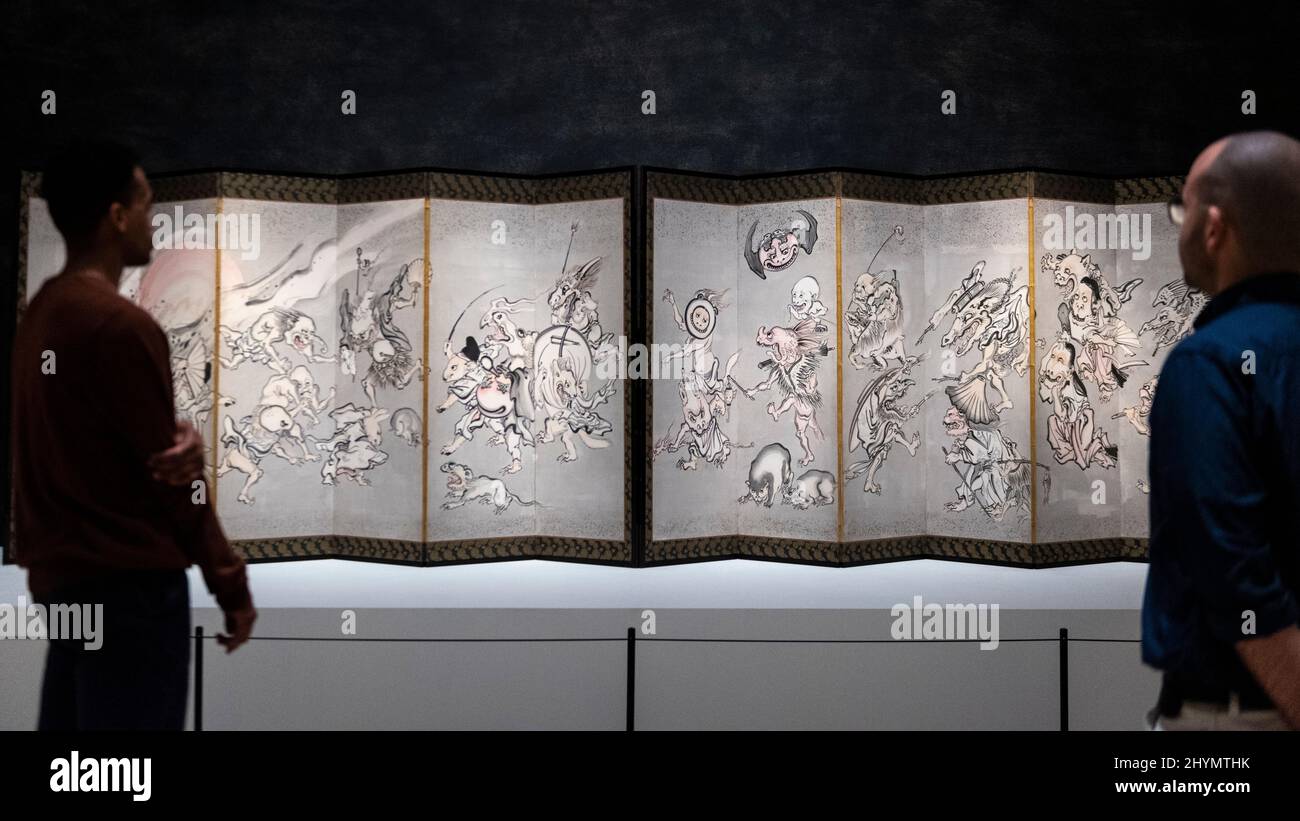 London, UK. 15 March 2022. Staff members view 'Night Procession of One Hundred Demons', 1871/89, by Kawanabe Kyōsai. Preview of Kyōsai: The Israel Goldman Collection exhibition at the Royal Academy of Arts where 80 works by late 19th century Japanese painter Kawanabe Kyōsai are on display 19 March to 19 June 2022 in the artist’s first solo UK exhibition in 30 years. Credit: Stephen Chung / Alamy Live News Stock Photohttps://www.alamy.com/image-license-details/?v=1https://www.alamy.com/london-uk-15-march-2022-staff-members-view-night-procession-of-one-hundred-demons-187189-by-kawanabe-kysai-preview-of-kysai-the-israel-goldman-collection-exhibition-at-the-royal-academy-of-arts-where-80-works-by-late-19th-century-japanese-painter-kawanabe-kysai-are-on-display-19-march-to-19-june-2022-in-the-artists-first-solo-uk-exhibition-in-30-years-credit-stephen-chung-alamy-live-news-image464523631.html
London, UK. 15 March 2022. Staff members view 'Night Procession of One Hundred Demons', 1871/89, by Kawanabe Kyōsai. Preview of Kyōsai: The Israel Goldman Collection exhibition at the Royal Academy of Arts where 80 works by late 19th century Japanese painter Kawanabe Kyōsai are on display 19 March to 19 June 2022 in the artist’s first solo UK exhibition in 30 years. Credit: Stephen Chung / Alamy Live News Stock Photohttps://www.alamy.com/image-license-details/?v=1https://www.alamy.com/london-uk-15-march-2022-staff-members-view-night-procession-of-one-hundred-demons-187189-by-kawanabe-kysai-preview-of-kysai-the-israel-goldman-collection-exhibition-at-the-royal-academy-of-arts-where-80-works-by-late-19th-century-japanese-painter-kawanabe-kysai-are-on-display-19-march-to-19-june-2022-in-the-artists-first-solo-uk-exhibition-in-30-years-credit-stephen-chung-alamy-live-news-image464523631.htmlRM2HYMTHK–London, UK. 15 March 2022. Staff members view 'Night Procession of One Hundred Demons', 1871/89, by Kawanabe Kyōsai. Preview of Kyōsai: The Israel Goldman Collection exhibition at the Royal Academy of Arts where 80 works by late 19th century Japanese painter Kawanabe Kyōsai are on display 19 March to 19 June 2022 in the artist’s first solo UK exhibition in 30 years. Credit: Stephen Chung / Alamy Live News
 . English: Yokai/' Night March of a Hundred Demons' scroll by Tosa Mitsuoki. Tosa Mitsuoki (Japanese: 土佐 光起; 1617–November 14, 1691) was a Japanese painter. Tosa was born in Sakai, Osaka, the son of Tosa Mitsunori (1583–1638), also a painter. His original name was Tosa Fujimitsu, also called Tsuneaki. Tosa lived in the early Edo period (1603–1867). He revived the Tosa school of painting, recapturing the title of official court artist. He died in Kyoto. 1600s. Tosa Mitsuki 250 Hyakki Yako no Zu by Tosa Mitsuoki- left half Stock Photohttps://www.alamy.com/image-license-details/?v=1https://www.alamy.com/english-yokai-night-march-of-a-hundred-demons-scroll-by-tosa-mitsuoki-tosa-mitsuoki-japanese-1617november-14-1691-was-a-japanese-painter-tosa-was-born-in-sakai-osaka-the-son-of-tosa-mitsunori-15831638-also-a-painter-his-original-name-was-tosa-fujimitsu-also-called-tsuneaki-tosa-lived-in-the-early-edo-period-16031867-he-revived-the-tosa-school-of-painting-recapturing-the-title-of-official-court-artist-he-died-in-kyoto-1600s-tosa-mitsuki-250-hyakki-yako-no-zu-by-tosa-mitsuoki-left-half-image189068937.html
. English: Yokai/' Night March of a Hundred Demons' scroll by Tosa Mitsuoki. Tosa Mitsuoki (Japanese: 土佐 光起; 1617–November 14, 1691) was a Japanese painter. Tosa was born in Sakai, Osaka, the son of Tosa Mitsunori (1583–1638), also a painter. His original name was Tosa Fujimitsu, also called Tsuneaki. Tosa lived in the early Edo period (1603–1867). He revived the Tosa school of painting, recapturing the title of official court artist. He died in Kyoto. 1600s. Tosa Mitsuki 250 Hyakki Yako no Zu by Tosa Mitsuoki- left half Stock Photohttps://www.alamy.com/image-license-details/?v=1https://www.alamy.com/english-yokai-night-march-of-a-hundred-demons-scroll-by-tosa-mitsuoki-tosa-mitsuoki-japanese-1617november-14-1691-was-a-japanese-painter-tosa-was-born-in-sakai-osaka-the-son-of-tosa-mitsunori-15831638-also-a-painter-his-original-name-was-tosa-fujimitsu-also-called-tsuneaki-tosa-lived-in-the-early-edo-period-16031867-he-revived-the-tosa-school-of-painting-recapturing-the-title-of-official-court-artist-he-died-in-kyoto-1600s-tosa-mitsuki-250-hyakki-yako-no-zu-by-tosa-mitsuoki-left-half-image189068937.htmlRMMYGRA1–. English: Yokai/' Night March of a Hundred Demons' scroll by Tosa Mitsuoki. Tosa Mitsuoki (Japanese: 土佐 光起; 1617–November 14, 1691) was a Japanese painter. Tosa was born in Sakai, Osaka, the son of Tosa Mitsunori (1583–1638), also a painter. His original name was Tosa Fujimitsu, also called Tsuneaki. Tosa lived in the early Edo period (1603–1867). He revived the Tosa school of painting, recapturing the title of official court artist. He died in Kyoto. 1600s. Tosa Mitsuki 250 Hyakki Yako no Zu by Tosa Mitsuoki- left half
 Shot during a visit to Kyoto´s Imperial Palace Stock Photohttps://www.alamy.com/image-license-details/?v=1https://www.alamy.com/stock-photo-shot-during-a-visit-to-kyotos-imperial-palace-89678236.html
Shot during a visit to Kyoto´s Imperial Palace Stock Photohttps://www.alamy.com/image-license-details/?v=1https://www.alamy.com/stock-photo-shot-during-a-visit-to-kyotos-imperial-palace-89678236.htmlRFF5W5E4–Shot during a visit to Kyoto´s Imperial Palace
 Immerse yourself in the captivating world of Japanese arts with our stunning collection of vector art files, Vector Oni Hannya masks. Stock Vectorhttps://www.alamy.com/image-license-details/?v=1https://www.alamy.com/immerse-yourself-in-the-captivating-world-of-japanese-arts-with-our-stunning-collection-of-vector-art-files-vector-oni-hannya-masks-image595843425.html
Immerse yourself in the captivating world of Japanese arts with our stunning collection of vector art files, Vector Oni Hannya masks. Stock Vectorhttps://www.alamy.com/image-license-details/?v=1https://www.alamy.com/immerse-yourself-in-the-captivating-world-of-japanese-arts-with-our-stunning-collection-of-vector-art-files-vector-oni-hannya-masks-image595843425.htmlRF2WHB0A9–Immerse yourself in the captivating world of Japanese arts with our stunning collection of vector art files, Vector Oni Hannya masks.
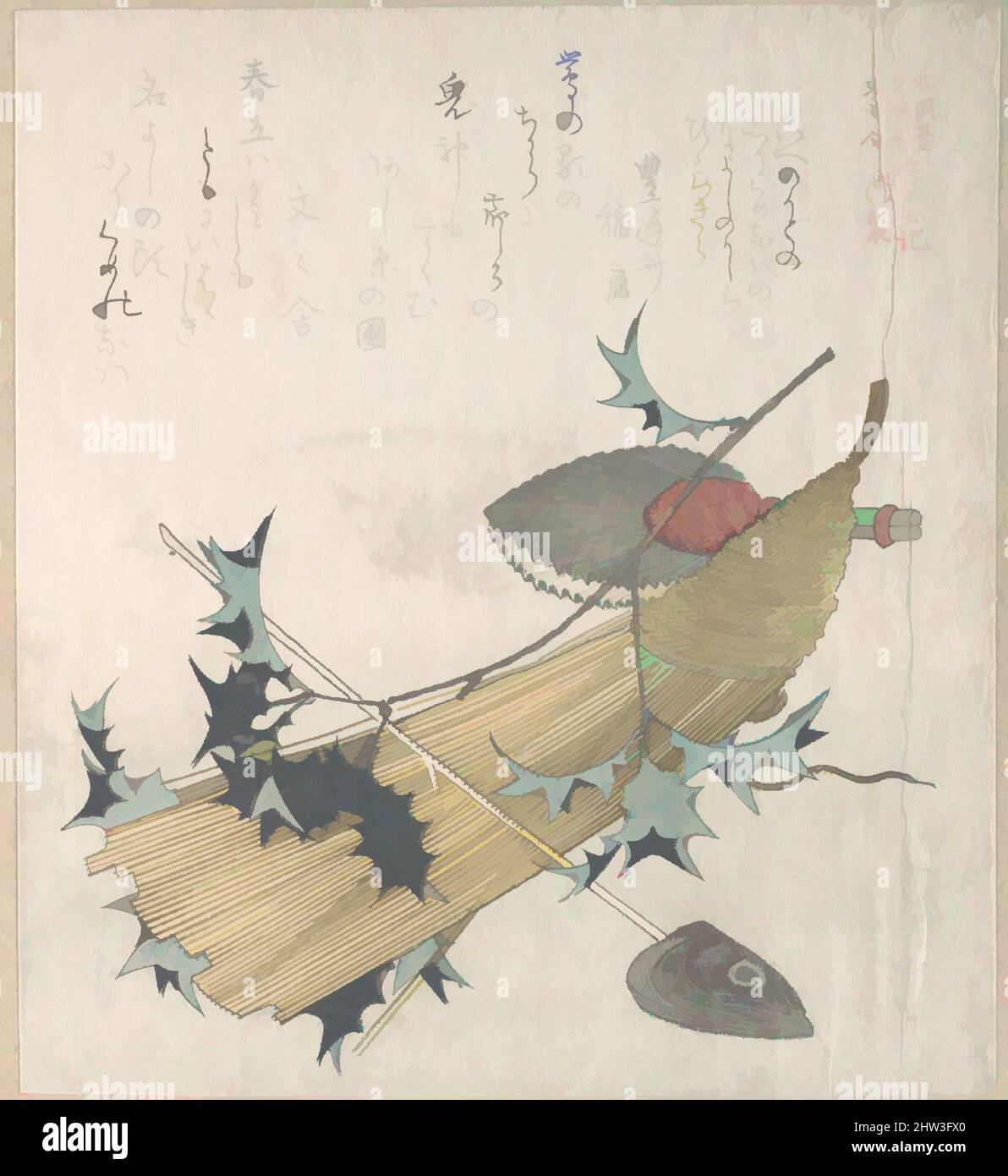 Art inspired by Objects Representing the Ceremony of Exorcising Demons, One of the New Year Performances, Edo period (1615–1868), 19th century, Japan, Polychrome woodblock print (surimono); ink and color on paper, 7 15/16 x 7 1/8 in. (20.2 x 18.1 cm), Prints, Kubo Shunman (Japanese, Classic works modernized by Artotop with a splash of modernity. Shapes, color and value, eye-catching visual impact on art. Emotions through freedom of artworks in a contemporary way. A timeless message pursuing a wildly creative new direction. Artists turning to the digital medium and creating the Artotop NFT Stock Photohttps://www.alamy.com/image-license-details/?v=1https://www.alamy.com/art-inspired-by-objects-representing-the-ceremony-of-exorcising-demons-one-of-the-new-year-performances-edo-period-16151868-19th-century-japan-polychrome-woodblock-print-surimono-ink-and-color-on-paper-7-1516-x-7-18-in-202-x-181-cm-prints-kubo-shunman-japanese-classic-works-modernized-by-artotop-with-a-splash-of-modernity-shapes-color-and-value-eye-catching-visual-impact-on-art-emotions-through-freedom-of-artworks-in-a-contemporary-way-a-timeless-message-pursuing-a-wildly-creative-new-direction-artists-turning-to-the-digital-medium-and-creating-the-artotop-nft-image462914312.html
Art inspired by Objects Representing the Ceremony of Exorcising Demons, One of the New Year Performances, Edo period (1615–1868), 19th century, Japan, Polychrome woodblock print (surimono); ink and color on paper, 7 15/16 x 7 1/8 in. (20.2 x 18.1 cm), Prints, Kubo Shunman (Japanese, Classic works modernized by Artotop with a splash of modernity. Shapes, color and value, eye-catching visual impact on art. Emotions through freedom of artworks in a contemporary way. A timeless message pursuing a wildly creative new direction. Artists turning to the digital medium and creating the Artotop NFT Stock Photohttps://www.alamy.com/image-license-details/?v=1https://www.alamy.com/art-inspired-by-objects-representing-the-ceremony-of-exorcising-demons-one-of-the-new-year-performances-edo-period-16151868-19th-century-japan-polychrome-woodblock-print-surimono-ink-and-color-on-paper-7-1516-x-7-18-in-202-x-181-cm-prints-kubo-shunman-japanese-classic-works-modernized-by-artotop-with-a-splash-of-modernity-shapes-color-and-value-eye-catching-visual-impact-on-art-emotions-through-freedom-of-artworks-in-a-contemporary-way-a-timeless-message-pursuing-a-wildly-creative-new-direction-artists-turning-to-the-digital-medium-and-creating-the-artotop-nft-image462914312.htmlRF2HW3FX0–Art inspired by Objects Representing the Ceremony of Exorcising Demons, One of the New Year Performances, Edo period (1615–1868), 19th century, Japan, Polychrome woodblock print (surimono); ink and color on paper, 7 15/16 x 7 1/8 in. (20.2 x 18.1 cm), Prints, Kubo Shunman (Japanese, Classic works modernized by Artotop with a splash of modernity. Shapes, color and value, eye-catching visual impact on art. Emotions through freedom of artworks in a contemporary way. A timeless message pursuing a wildly creative new direction. Artists turning to the digital medium and creating the Artotop NFT
 Fearsome statue guarding a Japanese Buddhist temple Stock Photohttps://www.alamy.com/image-license-details/?v=1https://www.alamy.com/stock-photo-fearsome-statue-guarding-a-japanese-buddhist-temple-70262074.html
Fearsome statue guarding a Japanese Buddhist temple Stock Photohttps://www.alamy.com/image-license-details/?v=1https://www.alamy.com/stock-photo-fearsome-statue-guarding-a-japanese-buddhist-temple-70262074.htmlRME28KYP–Fearsome statue guarding a Japanese Buddhist temple
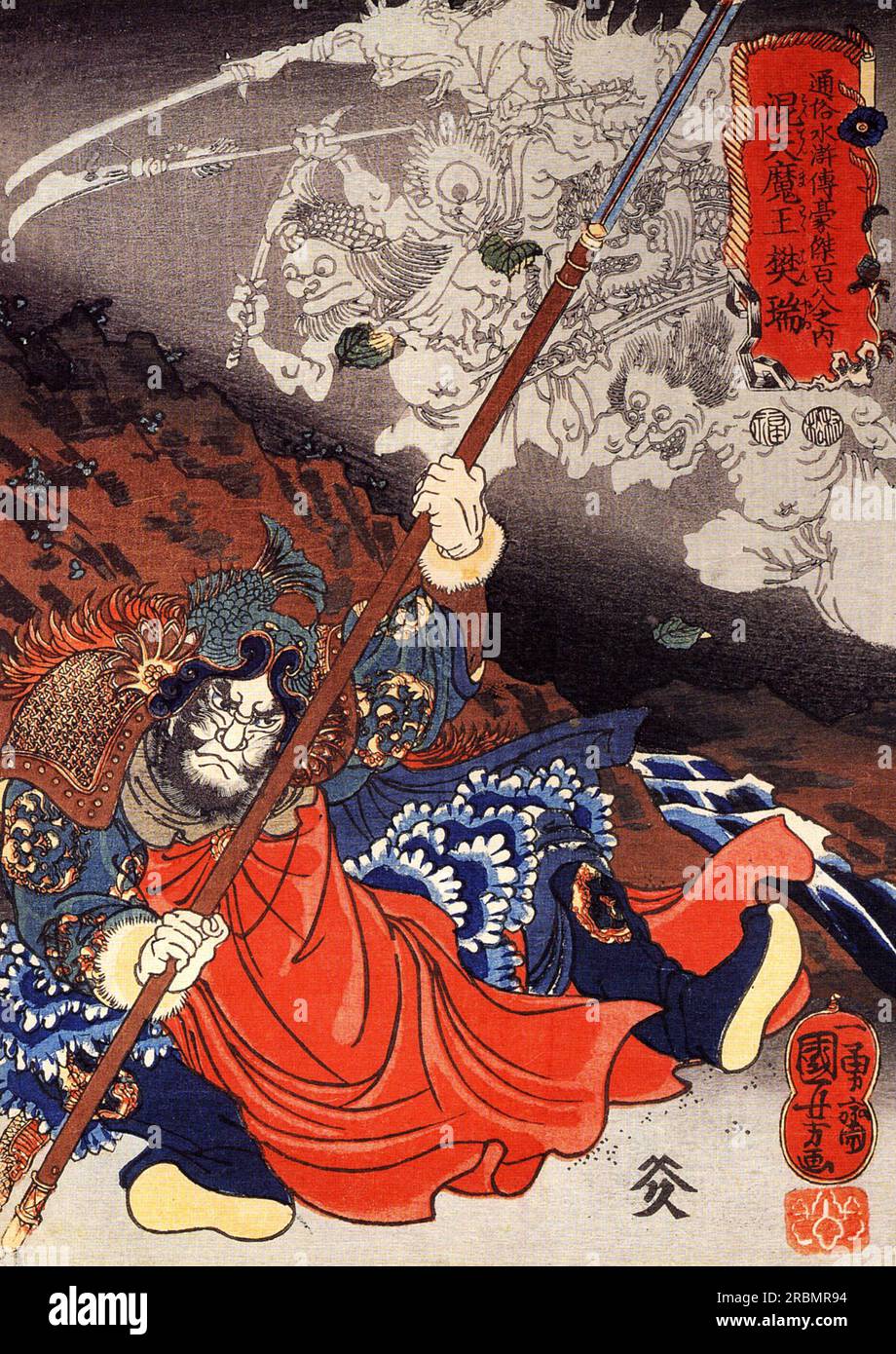 Konseimao hanzui beset by demons by Utagawa Kuniyoshi Stock Photohttps://www.alamy.com/image-license-details/?v=1https://www.alamy.com/konseimao-hanzui-beset-by-demons-by-utagawa-kuniyoshi-image557950320.html
Konseimao hanzui beset by demons by Utagawa Kuniyoshi Stock Photohttps://www.alamy.com/image-license-details/?v=1https://www.alamy.com/konseimao-hanzui-beset-by-demons-by-utagawa-kuniyoshi-image557950320.htmlRM2RBMR94–Konseimao hanzui beset by demons by Utagawa Kuniyoshi
 Dorotabo, Konjaku Hyakki Shūi First Volume Cloud, published ca. 1781, by Japanese artist Sekien Toriyama ( 1712 - 1788 ) Stock Photohttps://www.alamy.com/image-license-details/?v=1https://www.alamy.com/dorotabo-konjaku-hyakki-shi-first-volume-cloud-published-ca-1781-by-japanese-artist-sekien-toriyama-1712-1788-image208345605.html
Dorotabo, Konjaku Hyakki Shūi First Volume Cloud, published ca. 1781, by Japanese artist Sekien Toriyama ( 1712 - 1788 ) Stock Photohttps://www.alamy.com/image-license-details/?v=1https://www.alamy.com/dorotabo-konjaku-hyakki-shi-first-volume-cloud-published-ca-1781-by-japanese-artist-sekien-toriyama-1712-1788-image208345605.htmlRMP2XXXD–Dorotabo, Konjaku Hyakki Shūi First Volume Cloud, published ca. 1781, by Japanese artist Sekien Toriyama ( 1712 - 1788 )
 Green Peas in a Measure and Sprays of Hollyhock with Heads of Sardines; Symbols Representing the Ceremony of Exorcising Demons. Artist: Kubo Shunman (Japanese, 1757-1820) (?). Culture: Japan. Dimensions: 7 7/8 x 7 3/16 in. (20 x 18.3 cm). Date: 19th century. Museum: Metropolitan Museum of Art, New York, USA. Stock Photohttps://www.alamy.com/image-license-details/?v=1https://www.alamy.com/green-peas-in-a-measure-and-sprays-of-hollyhock-with-heads-of-sardines-symbols-representing-the-ceremony-of-exorcising-demons-artist-kubo-shunman-japanese-1757-1820-culture-japan-dimensions-7-78-x-7-316-in-20-x-183-cm-date-19th-century-museum-metropolitan-museum-of-art-new-york-usa-image213073541.html
Green Peas in a Measure and Sprays of Hollyhock with Heads of Sardines; Symbols Representing the Ceremony of Exorcising Demons. Artist: Kubo Shunman (Japanese, 1757-1820) (?). Culture: Japan. Dimensions: 7 7/8 x 7 3/16 in. (20 x 18.3 cm). Date: 19th century. Museum: Metropolitan Museum of Art, New York, USA. Stock Photohttps://www.alamy.com/image-license-details/?v=1https://www.alamy.com/green-peas-in-a-measure-and-sprays-of-hollyhock-with-heads-of-sardines-symbols-representing-the-ceremony-of-exorcising-demons-artist-kubo-shunman-japanese-1757-1820-culture-japan-dimensions-7-78-x-7-316-in-20-x-183-cm-date-19th-century-museum-metropolitan-museum-of-art-new-york-usa-image213073541.htmlRMPAJ9D9–Green Peas in a Measure and Sprays of Hollyhock with Heads of Sardines; Symbols Representing the Ceremony of Exorcising Demons. Artist: Kubo Shunman (Japanese, 1757-1820) (?). Culture: Japan. Dimensions: 7 7/8 x 7 3/16 in. (20 x 18.3 cm). Date: 19th century. Museum: Metropolitan Museum of Art, New York, USA.
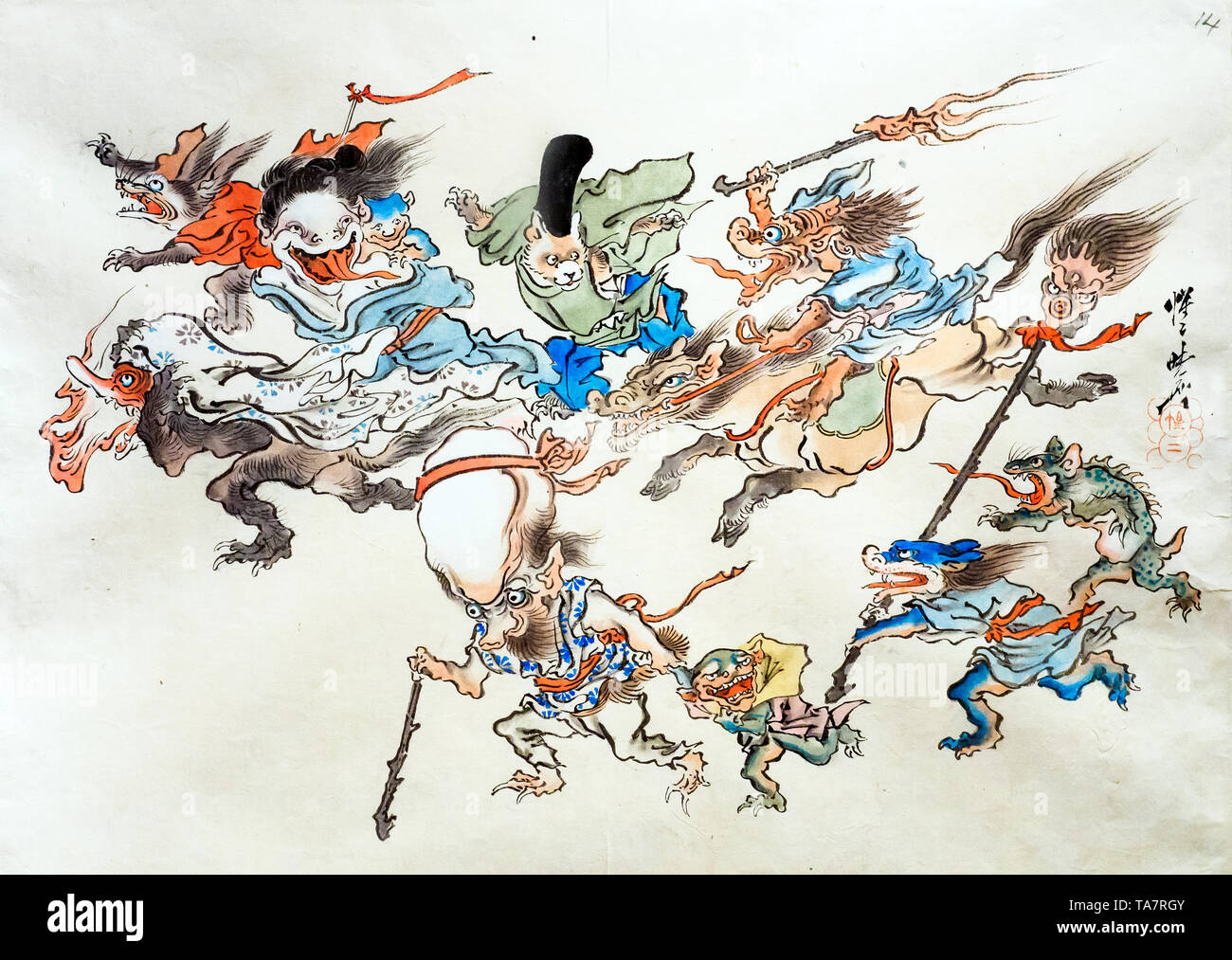 Night procession of hundred demons By Kawanabe Kyosai (1831-1889) Painting ink and colour on paper, about 1879 Stock Photohttps://www.alamy.com/image-license-details/?v=1https://www.alamy.com/night-procession-of-hundred-demons-by-kawanabe-kyosai-1831-1889-painting-ink-and-colour-on-paper-about-1879-image247263883.html
Night procession of hundred demons By Kawanabe Kyosai (1831-1889) Painting ink and colour on paper, about 1879 Stock Photohttps://www.alamy.com/image-license-details/?v=1https://www.alamy.com/night-procession-of-hundred-demons-by-kawanabe-kyosai-1831-1889-painting-ink-and-colour-on-paper-about-1879-image247263883.htmlRMTA7RGY–Night procession of hundred demons By Kawanabe Kyosai (1831-1889) Painting ink and colour on paper, about 1879
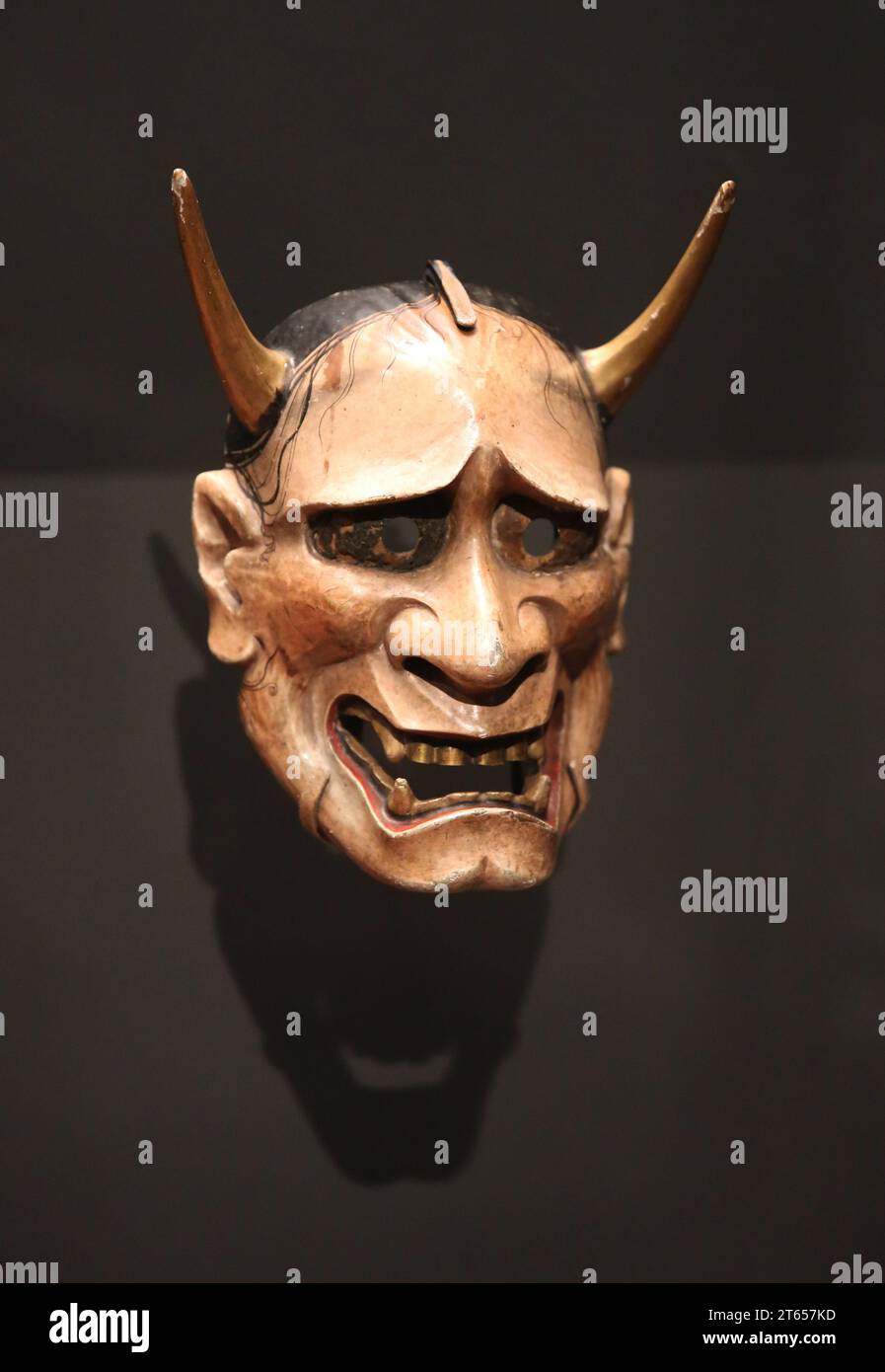 Noh theater Mask. Represent Hannya, the soul of a female who has become a demon or ghost throught jealousy or obsession. Japan. 18th-19th century. La Stock Photohttps://www.alamy.com/image-license-details/?v=1https://www.alamy.com/noh-theater-mask-represent-hannya-the-soul-of-a-female-who-has-become-a-demon-or-ghost-throught-jealousy-or-obsession-japan-18th-19th-century-la-image571745873.html
Noh theater Mask. Represent Hannya, the soul of a female who has become a demon or ghost throught jealousy or obsession. Japan. 18th-19th century. La Stock Photohttps://www.alamy.com/image-license-details/?v=1https://www.alamy.com/noh-theater-mask-represent-hannya-the-soul-of-a-female-who-has-become-a-demon-or-ghost-throught-jealousy-or-obsession-japan-18th-19th-century-la-image571745873.htmlRM2T657KD–Noh theater Mask. Represent Hannya, the soul of a female who has become a demon or ghost throught jealousy or obsession. Japan. 18th-19th century. La
 The Tsugaru Shamisen Players from Japan performing the Traditional Sword Dance of the Demons on Stage Stock Photohttps://www.alamy.com/image-license-details/?v=1https://www.alamy.com/stock-photo-the-tsugaru-shamisen-players-from-japan-performing-the-traditional-13094409.html
The Tsugaru Shamisen Players from Japan performing the Traditional Sword Dance of the Demons on Stage Stock Photohttps://www.alamy.com/image-license-details/?v=1https://www.alamy.com/stock-photo-the-tsugaru-shamisen-players-from-japan-performing-the-traditional-13094409.htmlRMACAE3P–The Tsugaru Shamisen Players from Japan performing the Traditional Sword Dance of the Demons on Stage
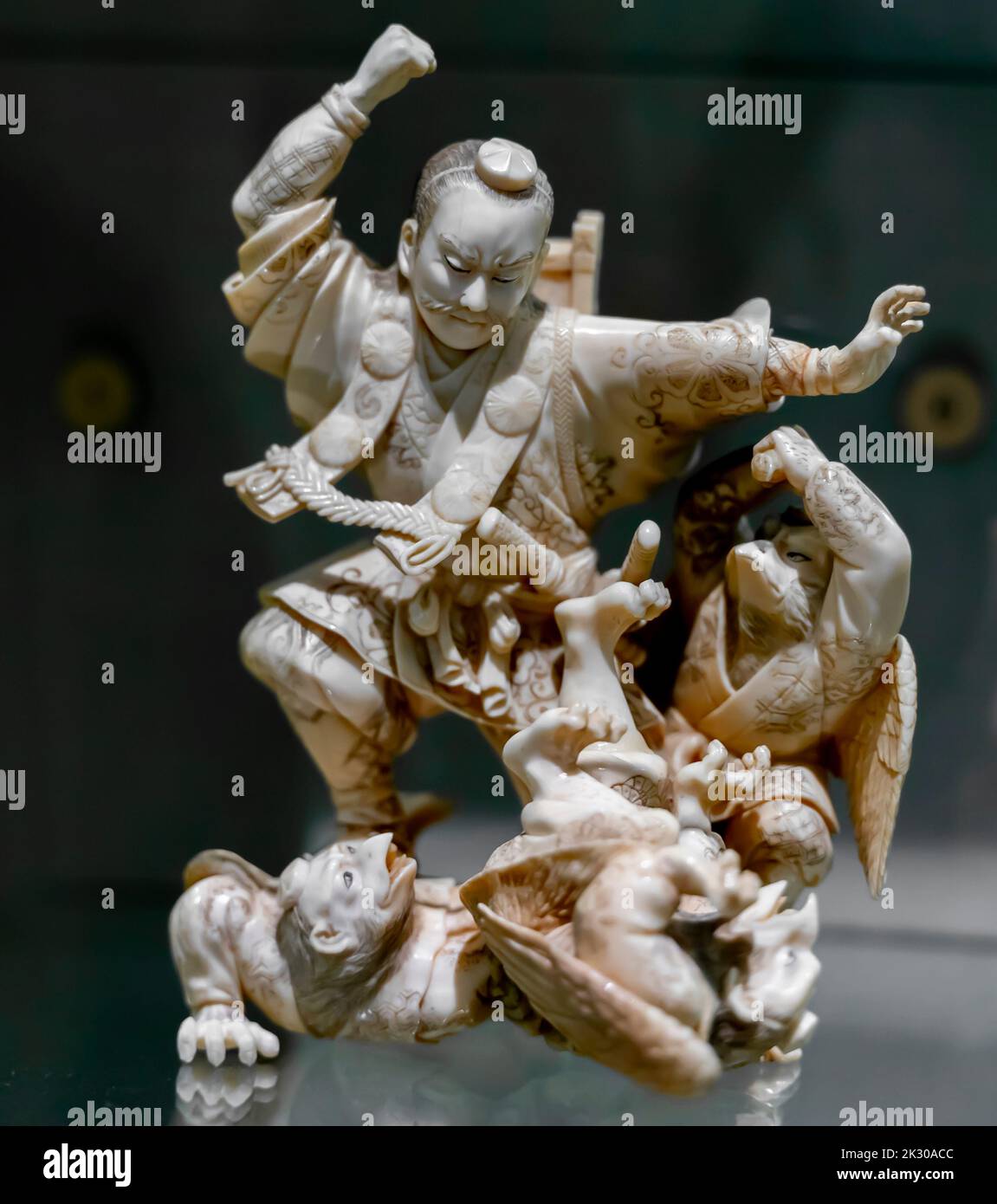 Hojo Takatoki and Tengu, winged demon, goblin - ivory carving - Japanese figurine, Japan. late 19th century Stock Photohttps://www.alamy.com/image-license-details/?v=1https://www.alamy.com/hojo-takatoki-and-tengu-winged-demon-goblin-ivory-carving-japanese-figurine-japan-late-19th-century-image483742460.html
Hojo Takatoki and Tengu, winged demon, goblin - ivory carving - Japanese figurine, Japan. late 19th century Stock Photohttps://www.alamy.com/image-license-details/?v=1https://www.alamy.com/hojo-takatoki-and-tengu-winged-demon-goblin-ivory-carving-japanese-figurine-japan-late-19th-century-image483742460.htmlRM2K30ACC–Hojo Takatoki and Tengu, winged demon, goblin - ivory carving - Japanese figurine, Japan. late 19th century
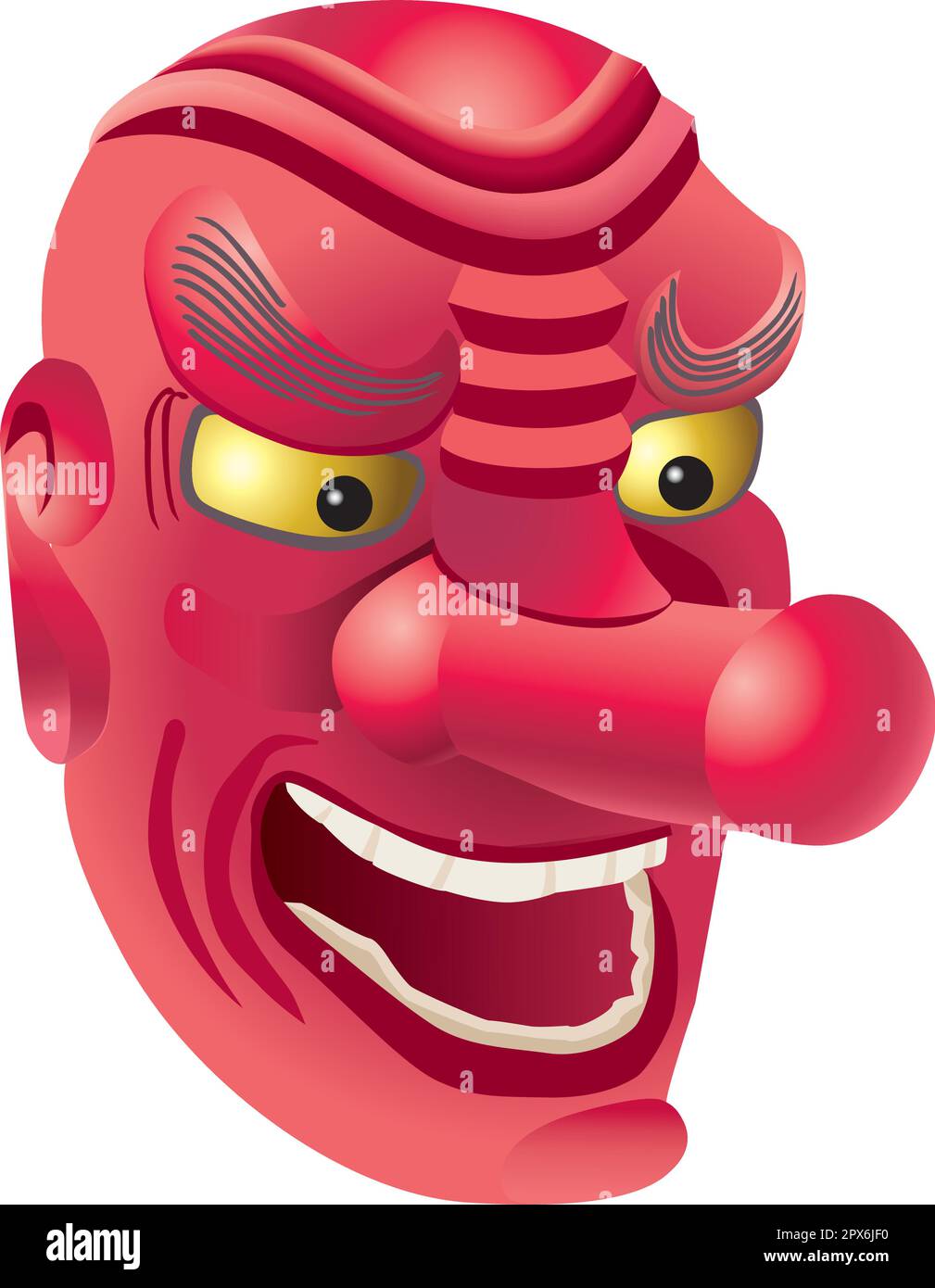 Tengu face mask or head - Japanese long-nosed tengu Shinto Demigod, folk god; all vector illustration. Stock Vectorhttps://www.alamy.com/image-license-details/?v=1https://www.alamy.com/tengu-face-mask-or-head-japanese-long-nosed-tengu-shinto-demigod-folk-god-all-vector-illustration-image549648708.html
Tengu face mask or head - Japanese long-nosed tengu Shinto Demigod, folk god; all vector illustration. Stock Vectorhttps://www.alamy.com/image-license-details/?v=1https://www.alamy.com/tengu-face-mask-or-head-japanese-long-nosed-tengu-shinto-demigod-folk-god-all-vector-illustration-image549648708.htmlRF2PX6JF0–Tengu face mask or head - Japanese long-nosed tengu Shinto Demigod, folk god; all vector illustration.
 Mask in the Shape of a Mountain Demon's Face, Japanese, early 18th century, Japanese, Iron, lacquer, textile (silk), H. 8 5/16 in. (21.1 cm); W. 7 3/16 in. (18.3 cm); D. 8 in. (20.3 cm); Wt. 1 lb. 1 oz. (481 g), Armor Parts-Masks Stock Photohttps://www.alamy.com/image-license-details/?v=1https://www.alamy.com/mask-in-the-shape-of-a-mountain-demons-face-japanese-early-18th-century-japanese-iron-lacquer-textile-silk-h-8-516-in-211-cm-w-7-316-in-183-cm-d-8-in-203-cm-wt-1-lb-1-oz-481-g-armor-parts-masks-image344658464.html
Mask in the Shape of a Mountain Demon's Face, Japanese, early 18th century, Japanese, Iron, lacquer, textile (silk), H. 8 5/16 in. (21.1 cm); W. 7 3/16 in. (18.3 cm); D. 8 in. (20.3 cm); Wt. 1 lb. 1 oz. (481 g), Armor Parts-Masks Stock Photohttps://www.alamy.com/image-license-details/?v=1https://www.alamy.com/mask-in-the-shape-of-a-mountain-demons-face-japanese-early-18th-century-japanese-iron-lacquer-textile-silk-h-8-516-in-211-cm-w-7-316-in-183-cm-d-8-in-203-cm-wt-1-lb-1-oz-481-g-armor-parts-masks-image344658464.htmlRM2B0MFAT–Mask in the Shape of a Mountain Demon's Face, Japanese, early 18th century, Japanese, Iron, lacquer, textile (silk), H. 8 5/16 in. (21.1 cm); W. 7 3/16 in. (18.3 cm); D. 8 in. (20.3 cm); Wt. 1 lb. 1 oz. (481 g), Armor Parts-Masks
 Garden dedicated to Buddhist priest Rocho, who vowed to drive away demons, near Ishiyamadera temple, in Otsu, Shiga Prefecture, Kansai region, Japan. Stock Photohttps://www.alamy.com/image-license-details/?v=1https://www.alamy.com/garden-dedicated-to-buddhist-priest-rocho-who-vowed-to-drive-away-demons-near-ishiyamadera-temple-in-otsu-shiga-prefecture-kansai-region-japan-image611463674.html
Garden dedicated to Buddhist priest Rocho, who vowed to drive away demons, near Ishiyamadera temple, in Otsu, Shiga Prefecture, Kansai region, Japan. Stock Photohttps://www.alamy.com/image-license-details/?v=1https://www.alamy.com/garden-dedicated-to-buddhist-priest-rocho-who-vowed-to-drive-away-demons-near-ishiyamadera-temple-in-otsu-shiga-prefecture-kansai-region-japan-image611463674.htmlRF2XEPG4A–Garden dedicated to Buddhist priest Rocho, who vowed to drive away demons, near Ishiyamadera temple, in Otsu, Shiga Prefecture, Kansai region, Japan.
 Fan Trade Mark Medicine Stock Photohttps://www.alamy.com/image-license-details/?v=1https://www.alamy.com/fan-trade-mark-medicine-image370866079.html
Fan Trade Mark Medicine Stock Photohttps://www.alamy.com/image-license-details/?v=1https://www.alamy.com/fan-trade-mark-medicine-image370866079.htmlRM2CFABD3–Fan Trade Mark Medicine
 Japan: 'Hyakki Yako (Night Parade of One Hundred Demons)'. Detail of handscroll painting, 18th century. Hyakki Yagyo/Hyakki Yako ('Night Parade of One Hundred Demons') is a Japanese folk belief. The belief holds that every year yokai, Japanese supernatural beings, will take to the streets during summer nights. The procession is sometimes orderly, while at other times it is a riot. Anyone who comes across the procession will die, unless protected by some Buddhist sutra. It is a popular theme in Japanese visual art. Stock Photohttps://www.alamy.com/image-license-details/?v=1https://www.alamy.com/japan-hyakki-yako-night-parade-of-one-hundred-demons-detail-of-handscroll-painting-18th-century-hyakki-yagyohyakki-yako-night-parade-of-one-hundred-demons-is-a-japanese-folk-belief-the-belief-holds-that-every-year-yokai-japanese-supernatural-beings-will-take-to-the-streets-during-summer-nights-the-procession-is-sometimes-orderly-while-at-other-times-it-is-a-riot-anyone-who-comes-across-the-procession-will-die-unless-protected-by-some-buddhist-sutra-it-is-a-popular-theme-in-japanese-visual-art-image344235286.html
Japan: 'Hyakki Yako (Night Parade of One Hundred Demons)'. Detail of handscroll painting, 18th century. Hyakki Yagyo/Hyakki Yako ('Night Parade of One Hundred Demons') is a Japanese folk belief. The belief holds that every year yokai, Japanese supernatural beings, will take to the streets during summer nights. The procession is sometimes orderly, while at other times it is a riot. Anyone who comes across the procession will die, unless protected by some Buddhist sutra. It is a popular theme in Japanese visual art. Stock Photohttps://www.alamy.com/image-license-details/?v=1https://www.alamy.com/japan-hyakki-yako-night-parade-of-one-hundred-demons-detail-of-handscroll-painting-18th-century-hyakki-yagyohyakki-yako-night-parade-of-one-hundred-demons-is-a-japanese-folk-belief-the-belief-holds-that-every-year-yokai-japanese-supernatural-beings-will-take-to-the-streets-during-summer-nights-the-procession-is-sometimes-orderly-while-at-other-times-it-is-a-riot-anyone-who-comes-across-the-procession-will-die-unless-protected-by-some-buddhist-sutra-it-is-a-popular-theme-in-japanese-visual-art-image344235286.htmlRM2B017HA–Japan: 'Hyakki Yako (Night Parade of One Hundred Demons)'. Detail of handscroll painting, 18th century. Hyakki Yagyo/Hyakki Yako ('Night Parade of One Hundred Demons') is a Japanese folk belief. The belief holds that every year yokai, Japanese supernatural beings, will take to the streets during summer nights. The procession is sometimes orderly, while at other times it is a riot. Anyone who comes across the procession will die, unless protected by some Buddhist sutra. It is a popular theme in Japanese visual art.
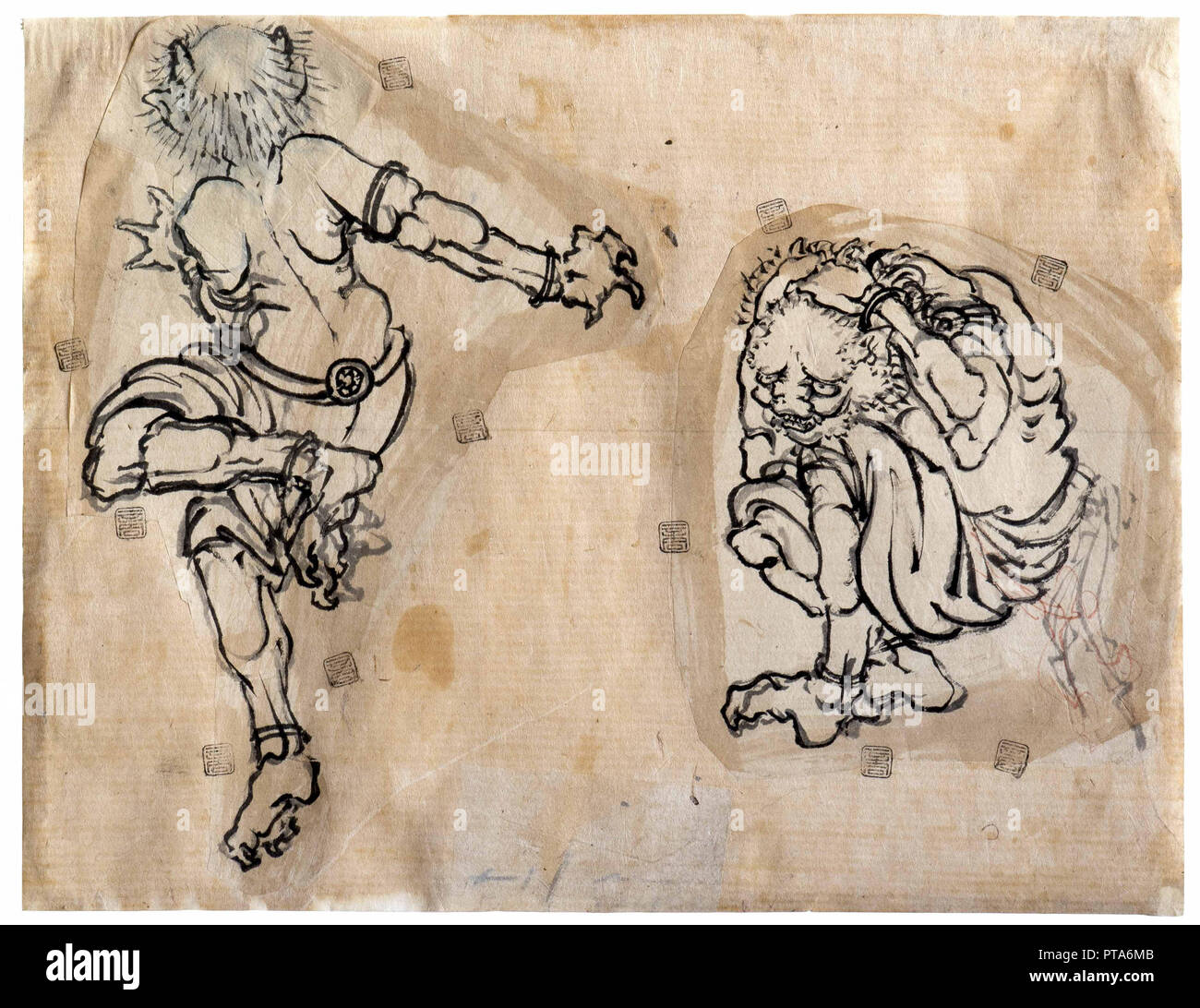 Two Oni (Demons), 1830-1839. Creator: Hokusai, Katsushika (1760-1849). Stock Photohttps://www.alamy.com/image-license-details/?v=1https://www.alamy.com/two-oni-demons-1830-1839-creator-hokusai-katsushika-1760-1849-image221500955.html
Two Oni (Demons), 1830-1839. Creator: Hokusai, Katsushika (1760-1849). Stock Photohttps://www.alamy.com/image-license-details/?v=1https://www.alamy.com/two-oni-demons-1830-1839-creator-hokusai-katsushika-1760-1849-image221500955.htmlRMPTA6MB–Two Oni (Demons), 1830-1839. Creator: Hokusai, Katsushika (1760-1849).
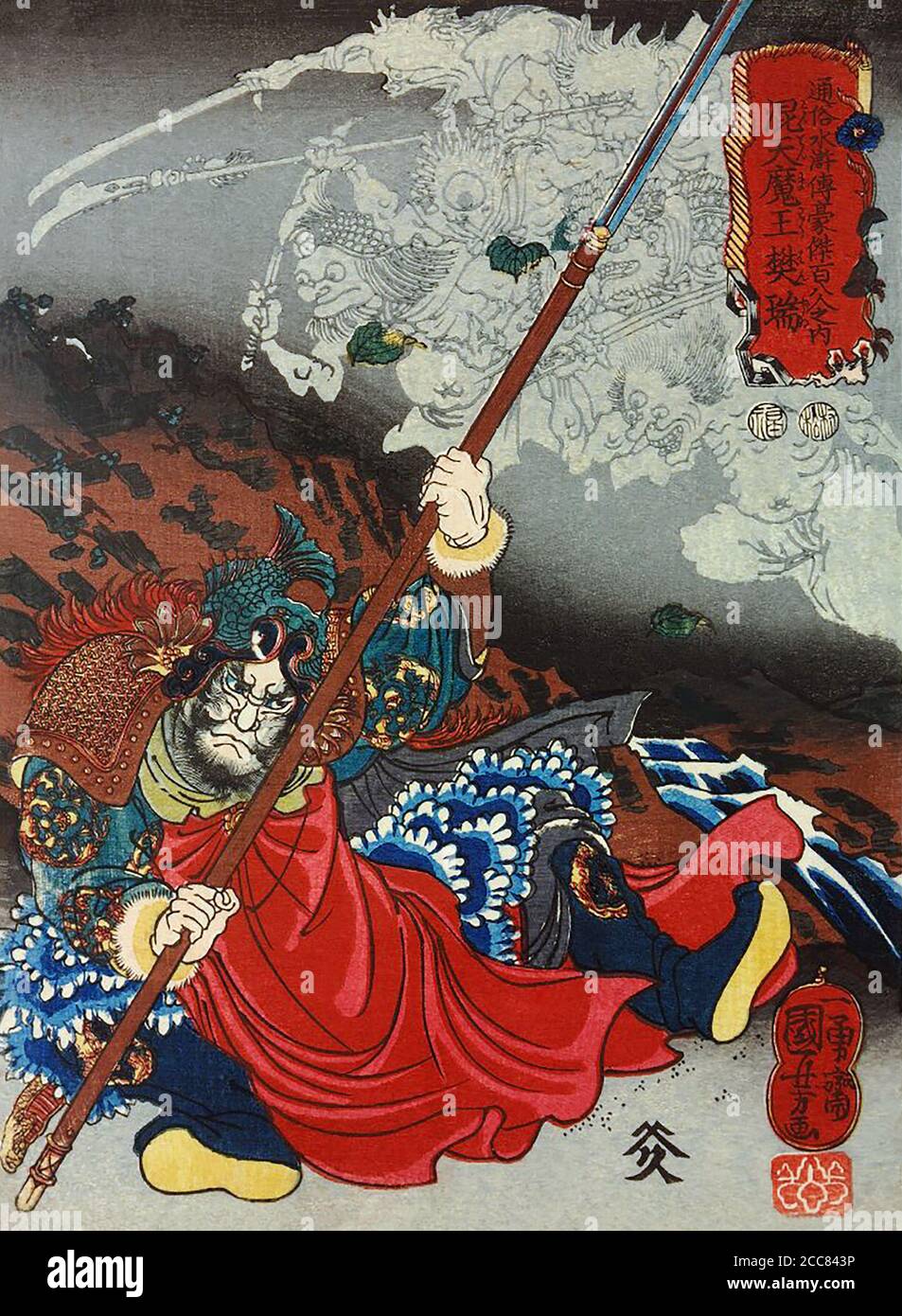 Japan: Konsei Mao or Kotenmao Hazui, one of the 'One Hundred and Eight Heroes of the Water Margin', grasping his spear, falls back before an apparition of demons. Woodblock print by Utagawa Kuniyoshi (1797-1863), 1827-1830. The Water Margin (known in Chinese as Shuihu Zhuan, sometimes abbreviated to Shuihu, known as Suikoden in Japanese, as well as Outlaws of the Marsh, Tale of the Marshes, All Men Are Brothers, Men of the Marshes, or The Marshes of Mount Liang in English, is a 14th century novel and one of the Four Great Classical Novels of Chinese literature. Attributed to Shi Nai'an and wri Stock Photohttps://www.alamy.com/image-license-details/?v=1https://www.alamy.com/japan-konsei-mao-or-kotenmao-hazui-one-of-the-one-hundred-and-eight-heroes-of-the-water-margin-grasping-his-spear-falls-back-before-an-apparition-of-demons-woodblock-print-by-utagawa-kuniyoshi-1797-1863-1827-1830-the-water-margin-known-in-chinese-as-shuihu-zhuan-sometimes-abbreviated-to-shuihu-known-as-suikoden-in-japanese-as-well-as-outlaws-of-the-marsh-tale-of-the-marshes-all-men-are-brothers-men-of-the-marshes-or-the-marshes-of-mount-liang-in-english-is-a-14th-century-novel-and-one-of-the-four-great-classical-novels-of-chinese-literature-attributed-to-shi-naian-and-wri-image368972458.html
Japan: Konsei Mao or Kotenmao Hazui, one of the 'One Hundred and Eight Heroes of the Water Margin', grasping his spear, falls back before an apparition of demons. Woodblock print by Utagawa Kuniyoshi (1797-1863), 1827-1830. The Water Margin (known in Chinese as Shuihu Zhuan, sometimes abbreviated to Shuihu, known as Suikoden in Japanese, as well as Outlaws of the Marsh, Tale of the Marshes, All Men Are Brothers, Men of the Marshes, or The Marshes of Mount Liang in English, is a 14th century novel and one of the Four Great Classical Novels of Chinese literature. Attributed to Shi Nai'an and wri Stock Photohttps://www.alamy.com/image-license-details/?v=1https://www.alamy.com/japan-konsei-mao-or-kotenmao-hazui-one-of-the-one-hundred-and-eight-heroes-of-the-water-margin-grasping-his-spear-falls-back-before-an-apparition-of-demons-woodblock-print-by-utagawa-kuniyoshi-1797-1863-1827-1830-the-water-margin-known-in-chinese-as-shuihu-zhuan-sometimes-abbreviated-to-shuihu-known-as-suikoden-in-japanese-as-well-as-outlaws-of-the-marsh-tale-of-the-marshes-all-men-are-brothers-men-of-the-marshes-or-the-marshes-of-mount-liang-in-english-is-a-14th-century-novel-and-one-of-the-four-great-classical-novels-of-chinese-literature-attributed-to-shi-naian-and-wri-image368972458.htmlRM2CC843P–Japan: Konsei Mao or Kotenmao Hazui, one of the 'One Hundred and Eight Heroes of the Water Margin', grasping his spear, falls back before an apparition of demons. Woodblock print by Utagawa Kuniyoshi (1797-1863), 1827-1830. The Water Margin (known in Chinese as Shuihu Zhuan, sometimes abbreviated to Shuihu, known as Suikoden in Japanese, as well as Outlaws of the Marsh, Tale of the Marshes, All Men Are Brothers, Men of the Marshes, or The Marshes of Mount Liang in English, is a 14th century novel and one of the Four Great Classical Novels of Chinese literature. Attributed to Shi Nai'an and wri
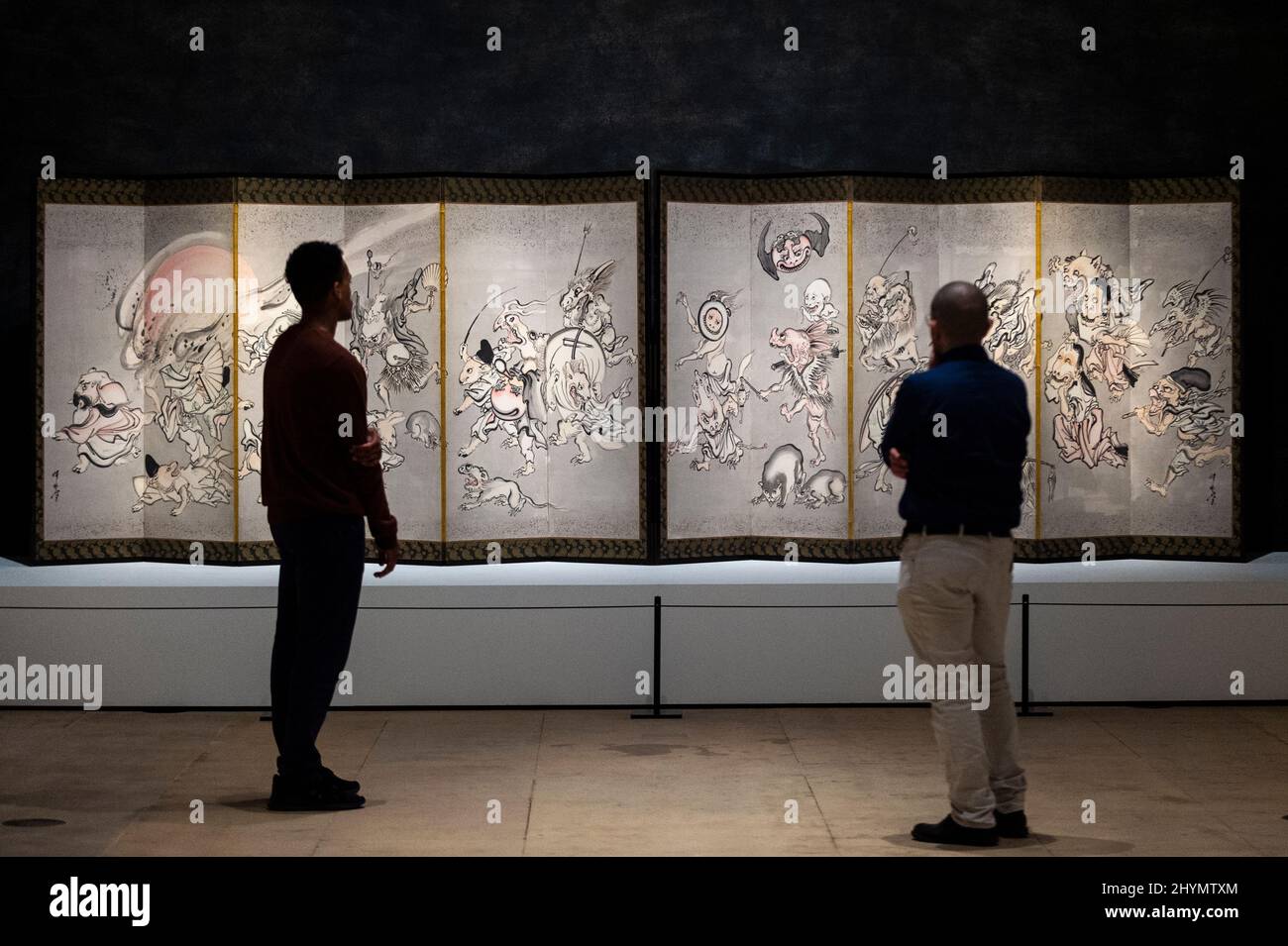 London, UK. 15 March 2022. Staff members view 'Night Procession of One Hundred Demons', 1871/89, by Kawanabe Kyōsai. Preview of Kyōsai: The Israel Goldman Collection exhibition at the Royal Academy of Arts where 80 works by late 19th century Japanese painter Kawanabe Kyōsai are on display 19 March to 19 June 2022 in the artist’s first solo UK exhibition in 30 years. Credit: Stephen Chung / Alamy Live News Stock Photohttps://www.alamy.com/image-license-details/?v=1https://www.alamy.com/london-uk-15-march-2022-staff-members-view-night-procession-of-one-hundred-demons-187189-by-kawanabe-kysai-preview-of-kysai-the-israel-goldman-collection-exhibition-at-the-royal-academy-of-arts-where-80-works-by-late-19th-century-japanese-painter-kawanabe-kysai-are-on-display-19-march-to-19-june-2022-in-the-artists-first-solo-uk-exhibition-in-30-years-credit-stephen-chung-alamy-live-news-image464523884.html
London, UK. 15 March 2022. Staff members view 'Night Procession of One Hundred Demons', 1871/89, by Kawanabe Kyōsai. Preview of Kyōsai: The Israel Goldman Collection exhibition at the Royal Academy of Arts where 80 works by late 19th century Japanese painter Kawanabe Kyōsai are on display 19 March to 19 June 2022 in the artist’s first solo UK exhibition in 30 years. Credit: Stephen Chung / Alamy Live News Stock Photohttps://www.alamy.com/image-license-details/?v=1https://www.alamy.com/london-uk-15-march-2022-staff-members-view-night-procession-of-one-hundred-demons-187189-by-kawanabe-kysai-preview-of-kysai-the-israel-goldman-collection-exhibition-at-the-royal-academy-of-arts-where-80-works-by-late-19th-century-japanese-painter-kawanabe-kysai-are-on-display-19-march-to-19-june-2022-in-the-artists-first-solo-uk-exhibition-in-30-years-credit-stephen-chung-alamy-live-news-image464523884.htmlRM2HYMTXM–London, UK. 15 March 2022. Staff members view 'Night Procession of One Hundred Demons', 1871/89, by Kawanabe Kyōsai. Preview of Kyōsai: The Israel Goldman Collection exhibition at the Royal Academy of Arts where 80 works by late 19th century Japanese painter Kawanabe Kyōsai are on display 19 March to 19 June 2022 in the artist’s first solo UK exhibition in 30 years. Credit: Stephen Chung / Alamy Live News
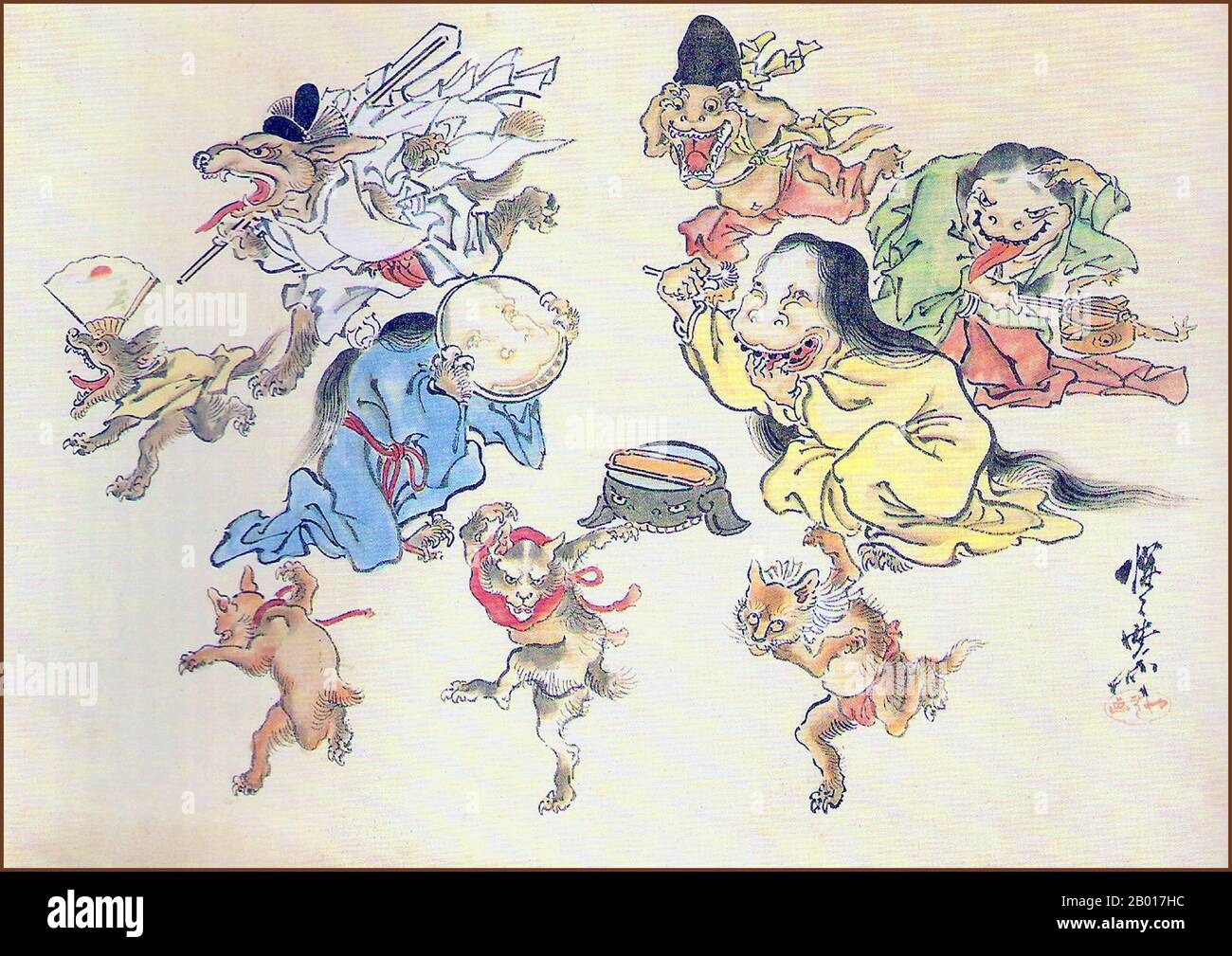 Japan: 'Hyakki Yako (Night Parade of One Hundred Demons)'. Detail of handscroll painting by Kawanabe Kyosai (18 May 1831 - 26 April 1889), 19th century. Hyakki Yagyo/Hyakki Yako ('Night Parade of One Hundred Demons') is a Japanese folk belief. The belief holds that every year yokai, Japanese supernatural beings, will take to the streets during summer nights. The procession is sometimes orderly, while at other times it is a riot. Anyone who comes across the procession will die, unless protected by some Buddhist sutra. It is a popular theme in Japanese visual art. Stock Photohttps://www.alamy.com/image-license-details/?v=1https://www.alamy.com/japan-hyakki-yako-night-parade-of-one-hundred-demons-detail-of-handscroll-painting-by-kawanabe-kyosai-18-may-1831-26-april-1889-19th-century-hyakki-yagyohyakki-yako-night-parade-of-one-hundred-demons-is-a-japanese-folk-belief-the-belief-holds-that-every-year-yokai-japanese-supernatural-beings-will-take-to-the-streets-during-summer-nights-the-procession-is-sometimes-orderly-while-at-other-times-it-is-a-riot-anyone-who-comes-across-the-procession-will-die-unless-protected-by-some-buddhist-sutra-it-is-a-popular-theme-in-japanese-visual-art-image344235288.html
Japan: 'Hyakki Yako (Night Parade of One Hundred Demons)'. Detail of handscroll painting by Kawanabe Kyosai (18 May 1831 - 26 April 1889), 19th century. Hyakki Yagyo/Hyakki Yako ('Night Parade of One Hundred Demons') is a Japanese folk belief. The belief holds that every year yokai, Japanese supernatural beings, will take to the streets during summer nights. The procession is sometimes orderly, while at other times it is a riot. Anyone who comes across the procession will die, unless protected by some Buddhist sutra. It is a popular theme in Japanese visual art. Stock Photohttps://www.alamy.com/image-license-details/?v=1https://www.alamy.com/japan-hyakki-yako-night-parade-of-one-hundred-demons-detail-of-handscroll-painting-by-kawanabe-kyosai-18-may-1831-26-april-1889-19th-century-hyakki-yagyohyakki-yako-night-parade-of-one-hundred-demons-is-a-japanese-folk-belief-the-belief-holds-that-every-year-yokai-japanese-supernatural-beings-will-take-to-the-streets-during-summer-nights-the-procession-is-sometimes-orderly-while-at-other-times-it-is-a-riot-anyone-who-comes-across-the-procession-will-die-unless-protected-by-some-buddhist-sutra-it-is-a-popular-theme-in-japanese-visual-art-image344235288.htmlRM2B017HC–Japan: 'Hyakki Yako (Night Parade of One Hundred Demons)'. Detail of handscroll painting by Kawanabe Kyosai (18 May 1831 - 26 April 1889), 19th century. Hyakki Yagyo/Hyakki Yako ('Night Parade of One Hundred Demons') is a Japanese folk belief. The belief holds that every year yokai, Japanese supernatural beings, will take to the streets during summer nights. The procession is sometimes orderly, while at other times it is a riot. Anyone who comes across the procession will die, unless protected by some Buddhist sutra. It is a popular theme in Japanese visual art.
 . English: Yokai/' Night March of a Hundred Demons' scroll by Tosa Mitsuoki. Tosa Mitsuoki (Japanese: 土佐 光起; 1617–November 14, 1691) was a Japanese painter. Tosa was born in Sakai, Osaka, the son of Tosa Mitsunori (1583–1638), also a painter. His original name was Tosa Fujimitsu, also called Tsuneaki. Tosa lived in the early Edo period (1603–1867). He revived the Tosa school of painting, recapturing the title of official court artist. He died in Kyoto. 1600s. Tosa Mitsuki 288 Hyakki Yako no Zu by Tosa Mitsuoki- left half Stock Photohttps://www.alamy.com/image-license-details/?v=1https://www.alamy.com/english-yokai-night-march-of-a-hundred-demons-scroll-by-tosa-mitsuoki-tosa-mitsuoki-japanese-1617november-14-1691-was-a-japanese-painter-tosa-was-born-in-sakai-osaka-the-son-of-tosa-mitsunori-15831638-also-a-painter-his-original-name-was-tosa-fujimitsu-also-called-tsuneaki-tosa-lived-in-the-early-edo-period-16031867-he-revived-the-tosa-school-of-painting-recapturing-the-title-of-official-court-artist-he-died-in-kyoto-1600s-tosa-mitsuki-288-hyakki-yako-no-zu-by-tosa-mitsuoki-left-half-image187785245.html
. English: Yokai/' Night March of a Hundred Demons' scroll by Tosa Mitsuoki. Tosa Mitsuoki (Japanese: 土佐 光起; 1617–November 14, 1691) was a Japanese painter. Tosa was born in Sakai, Osaka, the son of Tosa Mitsunori (1583–1638), also a painter. His original name was Tosa Fujimitsu, also called Tsuneaki. Tosa lived in the early Edo period (1603–1867). He revived the Tosa school of painting, recapturing the title of official court artist. He died in Kyoto. 1600s. Tosa Mitsuki 288 Hyakki Yako no Zu by Tosa Mitsuoki- left half Stock Photohttps://www.alamy.com/image-license-details/?v=1https://www.alamy.com/english-yokai-night-march-of-a-hundred-demons-scroll-by-tosa-mitsuoki-tosa-mitsuoki-japanese-1617november-14-1691-was-a-japanese-painter-tosa-was-born-in-sakai-osaka-the-son-of-tosa-mitsunori-15831638-also-a-painter-his-original-name-was-tosa-fujimitsu-also-called-tsuneaki-tosa-lived-in-the-early-edo-period-16031867-he-revived-the-tosa-school-of-painting-recapturing-the-title-of-official-court-artist-he-died-in-kyoto-1600s-tosa-mitsuki-288-hyakki-yako-no-zu-by-tosa-mitsuoki-left-half-image187785245.htmlRMMWE9YW–. English: Yokai/' Night March of a Hundred Demons' scroll by Tosa Mitsuoki. Tosa Mitsuoki (Japanese: 土佐 光起; 1617–November 14, 1691) was a Japanese painter. Tosa was born in Sakai, Osaka, the son of Tosa Mitsunori (1583–1638), also a painter. His original name was Tosa Fujimitsu, also called Tsuneaki. Tosa lived in the early Edo period (1603–1867). He revived the Tosa school of painting, recapturing the title of official court artist. He died in Kyoto. 1600s. Tosa Mitsuki 288 Hyakki Yako no Zu by Tosa Mitsuoki- left half
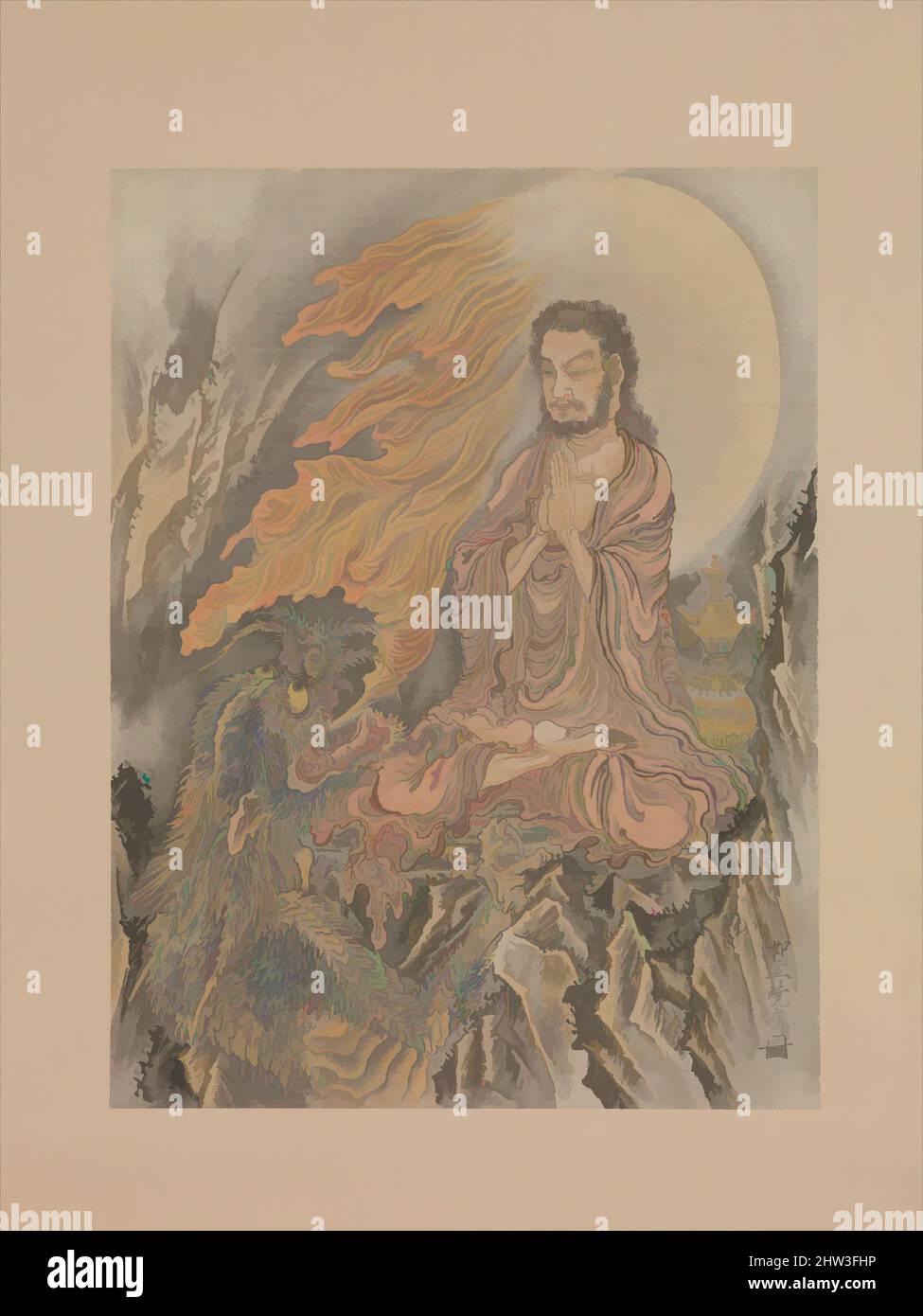 Art inspired by Shakyamuni Conquering the Demons (Shaka Gōma-zu), Meiji period (1868–1912), ca. 1888, Japan, Album leaf mounted as a hanging scroll; ink and color on silk, 14 1/2 x 11 in. (36.8 x 27.9 cm), Paintings, Kawanabe Kyōsai (Japanese, 1831–1889), This scene probably depicts an, Classic works modernized by Artotop with a splash of modernity. Shapes, color and value, eye-catching visual impact on art. Emotions through freedom of artworks in a contemporary way. A timeless message pursuing a wildly creative new direction. Artists turning to the digital medium and creating the Artotop NFT Stock Photohttps://www.alamy.com/image-license-details/?v=1https://www.alamy.com/art-inspired-by-shakyamuni-conquering-the-demons-shaka-gma-zu-meiji-period-18681912-ca-1888-japan-album-leaf-mounted-as-a-hanging-scroll-ink-and-color-on-silk-14-12-x-11-in-368-x-279-cm-paintings-kawanabe-kysai-japanese-18311889-this-scene-probably-depicts-an-classic-works-modernized-by-artotop-with-a-splash-of-modernity-shapes-color-and-value-eye-catching-visual-impact-on-art-emotions-through-freedom-of-artworks-in-a-contemporary-way-a-timeless-message-pursuing-a-wildly-creative-new-direction-artists-turning-to-the-digital-medium-and-creating-the-artotop-nft-image462914082.html
Art inspired by Shakyamuni Conquering the Demons (Shaka Gōma-zu), Meiji period (1868–1912), ca. 1888, Japan, Album leaf mounted as a hanging scroll; ink and color on silk, 14 1/2 x 11 in. (36.8 x 27.9 cm), Paintings, Kawanabe Kyōsai (Japanese, 1831–1889), This scene probably depicts an, Classic works modernized by Artotop with a splash of modernity. Shapes, color and value, eye-catching visual impact on art. Emotions through freedom of artworks in a contemporary way. A timeless message pursuing a wildly creative new direction. Artists turning to the digital medium and creating the Artotop NFT Stock Photohttps://www.alamy.com/image-license-details/?v=1https://www.alamy.com/art-inspired-by-shakyamuni-conquering-the-demons-shaka-gma-zu-meiji-period-18681912-ca-1888-japan-album-leaf-mounted-as-a-hanging-scroll-ink-and-color-on-silk-14-12-x-11-in-368-x-279-cm-paintings-kawanabe-kysai-japanese-18311889-this-scene-probably-depicts-an-classic-works-modernized-by-artotop-with-a-splash-of-modernity-shapes-color-and-value-eye-catching-visual-impact-on-art-emotions-through-freedom-of-artworks-in-a-contemporary-way-a-timeless-message-pursuing-a-wildly-creative-new-direction-artists-turning-to-the-digital-medium-and-creating-the-artotop-nft-image462914082.htmlRF2HW3FHP–Art inspired by Shakyamuni Conquering the Demons (Shaka Gōma-zu), Meiji period (1868–1912), ca. 1888, Japan, Album leaf mounted as a hanging scroll; ink and color on silk, 14 1/2 x 11 in. (36.8 x 27.9 cm), Paintings, Kawanabe Kyōsai (Japanese, 1831–1889), This scene probably depicts an, Classic works modernized by Artotop with a splash of modernity. Shapes, color and value, eye-catching visual impact on art. Emotions through freedom of artworks in a contemporary way. A timeless message pursuing a wildly creative new direction. Artists turning to the digital medium and creating the Artotop NFT
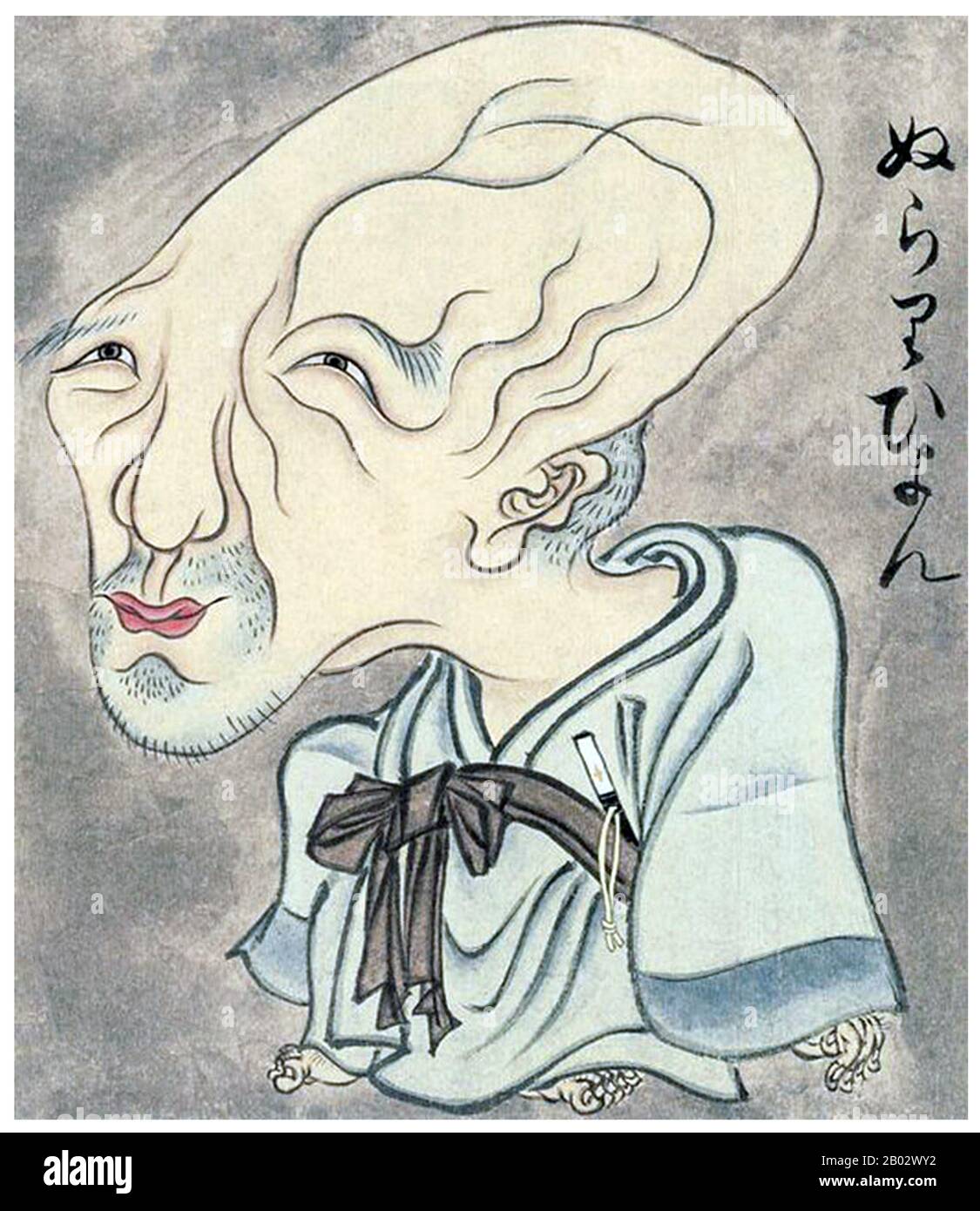 Nurarihyon or Nurihyon is a Japanese yokai (a supernatural monster in folklore) said to originate from Wakayama Prefecture. Nurarihyon is usually depicted as an old man with a gourd-shaped head and wearing a kesa robe. He is sometimes said to be leader of the yōkai. Nurarihyon will sneak into someone's house while they are away, drink their tea, and act as if it is his own house. Because it looks human, anyone who sees him will mistake him for the owner of the house, making it very hard to expel him. Nurarihyon is the leader of the Hyakki Yako Night Parade of 100 Demons. Stock Photohttps://www.alamy.com/image-license-details/?v=1https://www.alamy.com/nurarihyon-or-nurihyon-is-a-japanese-yokai-a-supernatural-monster-in-folklore-said-to-originate-from-wakayama-prefecture-nurarihyon-is-usually-depicted-as-an-old-man-with-a-gourd-shaped-head-and-wearing-a-kesa-robe-he-is-sometimes-said-to-be-leader-of-the-ykai-nurarihyon-will-sneak-into-someones-house-while-they-are-away-drink-their-tea-and-act-as-if-it-is-his-own-house-because-it-looks-human-anyone-who-sees-him-will-mistake-him-for-the-owner-of-the-house-making-it-very-hard-to-expel-him-nurarihyon-is-the-leader-of-the-hyakki-yako-night-parade-of-100-demons-image344271622.html
Nurarihyon or Nurihyon is a Japanese yokai (a supernatural monster in folklore) said to originate from Wakayama Prefecture. Nurarihyon is usually depicted as an old man with a gourd-shaped head and wearing a kesa robe. He is sometimes said to be leader of the yōkai. Nurarihyon will sneak into someone's house while they are away, drink their tea, and act as if it is his own house. Because it looks human, anyone who sees him will mistake him for the owner of the house, making it very hard to expel him. Nurarihyon is the leader of the Hyakki Yako Night Parade of 100 Demons. Stock Photohttps://www.alamy.com/image-license-details/?v=1https://www.alamy.com/nurarihyon-or-nurihyon-is-a-japanese-yokai-a-supernatural-monster-in-folklore-said-to-originate-from-wakayama-prefecture-nurarihyon-is-usually-depicted-as-an-old-man-with-a-gourd-shaped-head-and-wearing-a-kesa-robe-he-is-sometimes-said-to-be-leader-of-the-ykai-nurarihyon-will-sneak-into-someones-house-while-they-are-away-drink-their-tea-and-act-as-if-it-is-his-own-house-because-it-looks-human-anyone-who-sees-him-will-mistake-him-for-the-owner-of-the-house-making-it-very-hard-to-expel-him-nurarihyon-is-the-leader-of-the-hyakki-yako-night-parade-of-100-demons-image344271622.htmlRM2B02WY2–Nurarihyon or Nurihyon is a Japanese yokai (a supernatural monster in folklore) said to originate from Wakayama Prefecture. Nurarihyon is usually depicted as an old man with a gourd-shaped head and wearing a kesa robe. He is sometimes said to be leader of the yōkai. Nurarihyon will sneak into someone's house while they are away, drink their tea, and act as if it is his own house. Because it looks human, anyone who sees him will mistake him for the owner of the house, making it very hard to expel him. Nurarihyon is the leader of the Hyakki Yako Night Parade of 100 Demons.
 Art inspired by Beauty with Demons, Edo period (1615–1868), 18th century, Japan, Polychrome woodblock print (hashira-e); ink and color on paper, H. 27 1/2 in. (69.9 cm); W. 4 13/16 in. (12.2 cm), Prints, Suzuki Harunobu (Japanese, 1725–1770), In stunning contrast, Harunobu's satiric, Classic works modernized by Artotop with a splash of modernity. Shapes, color and value, eye-catching visual impact on art. Emotions through freedom of artworks in a contemporary way. A timeless message pursuing a wildly creative new direction. Artists turning to the digital medium and creating the Artotop NFT Stock Photohttps://www.alamy.com/image-license-details/?v=1https://www.alamy.com/art-inspired-by-beauty-with-demons-edo-period-16151868-18th-century-japan-polychrome-woodblock-print-hashira-e-ink-and-color-on-paper-h-27-12-in-699-cm-w-4-1316-in-122-cm-prints-suzuki-harunobu-japanese-17251770-in-stunning-contrast-harunobus-satiric-classic-works-modernized-by-artotop-with-a-splash-of-modernity-shapes-color-and-value-eye-catching-visual-impact-on-art-emotions-through-freedom-of-artworks-in-a-contemporary-way-a-timeless-message-pursuing-a-wildly-creative-new-direction-artists-turning-to-the-digital-medium-and-creating-the-artotop-nft-image462769640.html
Art inspired by Beauty with Demons, Edo period (1615–1868), 18th century, Japan, Polychrome woodblock print (hashira-e); ink and color on paper, H. 27 1/2 in. (69.9 cm); W. 4 13/16 in. (12.2 cm), Prints, Suzuki Harunobu (Japanese, 1725–1770), In stunning contrast, Harunobu's satiric, Classic works modernized by Artotop with a splash of modernity. Shapes, color and value, eye-catching visual impact on art. Emotions through freedom of artworks in a contemporary way. A timeless message pursuing a wildly creative new direction. Artists turning to the digital medium and creating the Artotop NFT Stock Photohttps://www.alamy.com/image-license-details/?v=1https://www.alamy.com/art-inspired-by-beauty-with-demons-edo-period-16151868-18th-century-japan-polychrome-woodblock-print-hashira-e-ink-and-color-on-paper-h-27-12-in-699-cm-w-4-1316-in-122-cm-prints-suzuki-harunobu-japanese-17251770-in-stunning-contrast-harunobus-satiric-classic-works-modernized-by-artotop-with-a-splash-of-modernity-shapes-color-and-value-eye-catching-visual-impact-on-art-emotions-through-freedom-of-artworks-in-a-contemporary-way-a-timeless-message-pursuing-a-wildly-creative-new-direction-artists-turning-to-the-digital-medium-and-creating-the-artotop-nft-image462769640.htmlRF2HTTYB4–Art inspired by Beauty with Demons, Edo period (1615–1868), 18th century, Japan, Polychrome woodblock print (hashira-e); ink and color on paper, H. 27 1/2 in. (69.9 cm); W. 4 13/16 in. (12.2 cm), Prints, Suzuki Harunobu (Japanese, 1725–1770), In stunning contrast, Harunobu's satiric, Classic works modernized by Artotop with a splash of modernity. Shapes, color and value, eye-catching visual impact on art. Emotions through freedom of artworks in a contemporary way. A timeless message pursuing a wildly creative new direction. Artists turning to the digital medium and creating the Artotop NFT
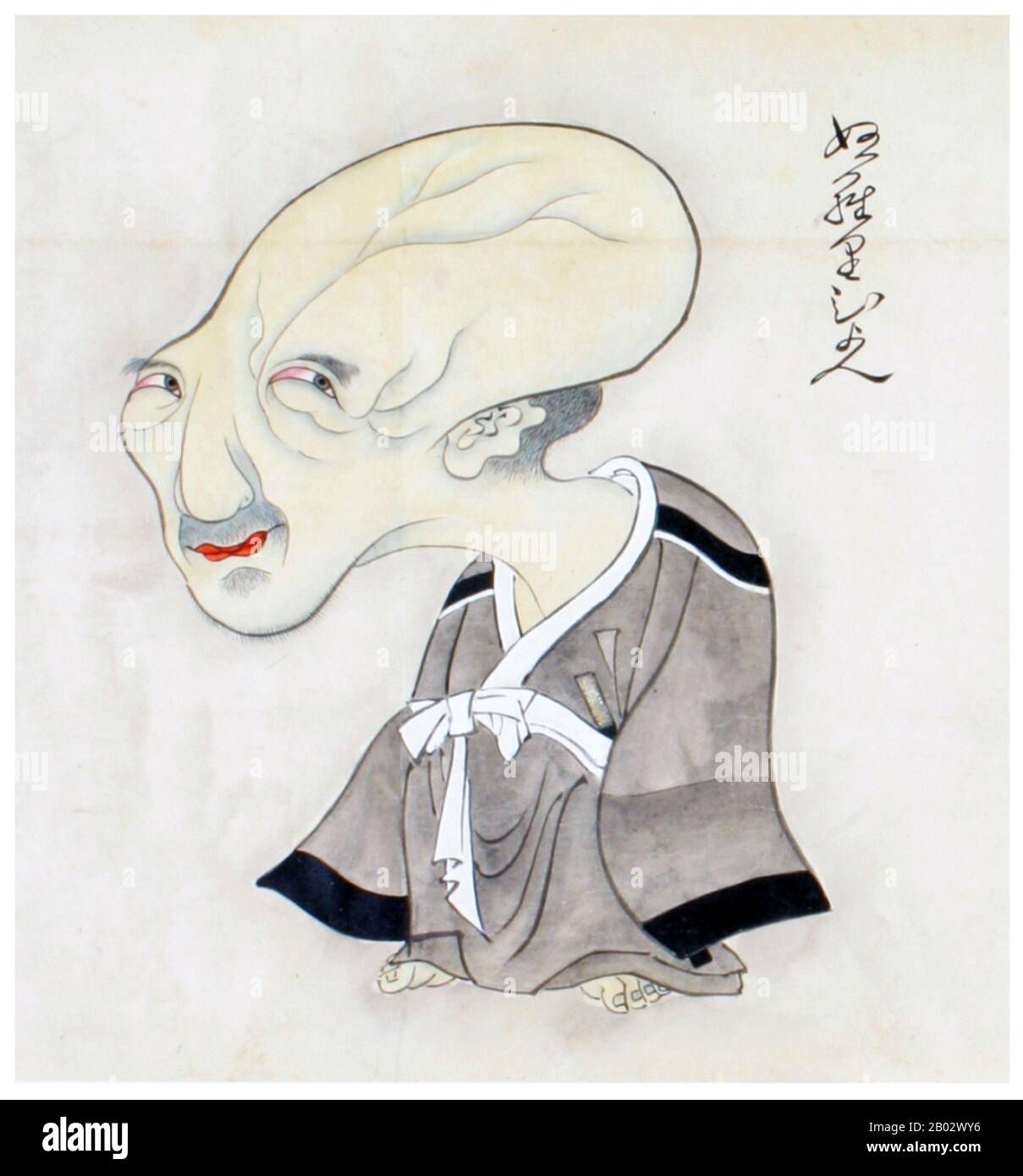 Nurarihyon or Nurihyon is a Japanese yokai (a supernatural monster in folklore) said to originate from Wakayama Prefecture. Nurarihyon is usually depicted as an old man with a gourd-shaped head and wearing a kesa robe. He is sometimes said to be leader of the yōkai. Nurarihyon will sneak into someone's house while they are away, drink their tea, and act as if it is his own house. Because it looks human, anyone who sees him will mistake him for the owner of the house, making it very hard to expel him. Nurarihyon is the leader of the Hyakki Yako Night Parade of 100 Demons. Stock Photohttps://www.alamy.com/image-license-details/?v=1https://www.alamy.com/nurarihyon-or-nurihyon-is-a-japanese-yokai-a-supernatural-monster-in-folklore-said-to-originate-from-wakayama-prefecture-nurarihyon-is-usually-depicted-as-an-old-man-with-a-gourd-shaped-head-and-wearing-a-kesa-robe-he-is-sometimes-said-to-be-leader-of-the-ykai-nurarihyon-will-sneak-into-someones-house-while-they-are-away-drink-their-tea-and-act-as-if-it-is-his-own-house-because-it-looks-human-anyone-who-sees-him-will-mistake-him-for-the-owner-of-the-house-making-it-very-hard-to-expel-him-nurarihyon-is-the-leader-of-the-hyakki-yako-night-parade-of-100-demons-image344271626.html
Nurarihyon or Nurihyon is a Japanese yokai (a supernatural monster in folklore) said to originate from Wakayama Prefecture. Nurarihyon is usually depicted as an old man with a gourd-shaped head and wearing a kesa robe. He is sometimes said to be leader of the yōkai. Nurarihyon will sneak into someone's house while they are away, drink their tea, and act as if it is his own house. Because it looks human, anyone who sees him will mistake him for the owner of the house, making it very hard to expel him. Nurarihyon is the leader of the Hyakki Yako Night Parade of 100 Demons. Stock Photohttps://www.alamy.com/image-license-details/?v=1https://www.alamy.com/nurarihyon-or-nurihyon-is-a-japanese-yokai-a-supernatural-monster-in-folklore-said-to-originate-from-wakayama-prefecture-nurarihyon-is-usually-depicted-as-an-old-man-with-a-gourd-shaped-head-and-wearing-a-kesa-robe-he-is-sometimes-said-to-be-leader-of-the-ykai-nurarihyon-will-sneak-into-someones-house-while-they-are-away-drink-their-tea-and-act-as-if-it-is-his-own-house-because-it-looks-human-anyone-who-sees-him-will-mistake-him-for-the-owner-of-the-house-making-it-very-hard-to-expel-him-nurarihyon-is-the-leader-of-the-hyakki-yako-night-parade-of-100-demons-image344271626.htmlRM2B02WY6–Nurarihyon or Nurihyon is a Japanese yokai (a supernatural monster in folklore) said to originate from Wakayama Prefecture. Nurarihyon is usually depicted as an old man with a gourd-shaped head and wearing a kesa robe. He is sometimes said to be leader of the yōkai. Nurarihyon will sneak into someone's house while they are away, drink their tea, and act as if it is his own house. Because it looks human, anyone who sees him will mistake him for the owner of the house, making it very hard to expel him. Nurarihyon is the leader of the Hyakki Yako Night Parade of 100 Demons.
 Art inspired by Shimabara Courtesans Exorcizing Demons, 島原の節分図, Edo period (1615–1868), second half of the 18th century, Japan, Hanging scroll; ink and color on paper, Image: 34 1/4 × 10 1/2 in. (87 × 26.6 cm), Paintings, Miyagawa Isshō (Japanese, 1689–1779), Two young, brightly, Classic works modernized by Artotop with a splash of modernity. Shapes, color and value, eye-catching visual impact on art. Emotions through freedom of artworks in a contemporary way. A timeless message pursuing a wildly creative new direction. Artists turning to the digital medium and creating the Artotop NFT Stock Photohttps://www.alamy.com/image-license-details/?v=1https://www.alamy.com/art-inspired-by-shimabara-courtesans-exorcizing-demons-edo-period-16151868-second-half-of-the-18th-century-japan-hanging-scroll-ink-and-color-on-paper-image-34-14-10-12-in-87-266-cm-paintings-miyagawa-issh-japanese-16891779-two-young-brightly-classic-works-modernized-by-artotop-with-a-splash-of-modernity-shapes-color-and-value-eye-catching-visual-impact-on-art-emotions-through-freedom-of-artworks-in-a-contemporary-way-a-timeless-message-pursuing-a-wildly-creative-new-direction-artists-turning-to-the-digital-medium-and-creating-the-artotop-nft-image463043796.html
Art inspired by Shimabara Courtesans Exorcizing Demons, 島原の節分図, Edo period (1615–1868), second half of the 18th century, Japan, Hanging scroll; ink and color on paper, Image: 34 1/4 × 10 1/2 in. (87 × 26.6 cm), Paintings, Miyagawa Isshō (Japanese, 1689–1779), Two young, brightly, Classic works modernized by Artotop with a splash of modernity. Shapes, color and value, eye-catching visual impact on art. Emotions through freedom of artworks in a contemporary way. A timeless message pursuing a wildly creative new direction. Artists turning to the digital medium and creating the Artotop NFT Stock Photohttps://www.alamy.com/image-license-details/?v=1https://www.alamy.com/art-inspired-by-shimabara-courtesans-exorcizing-demons-edo-period-16151868-second-half-of-the-18th-century-japan-hanging-scroll-ink-and-color-on-paper-image-34-14-10-12-in-87-266-cm-paintings-miyagawa-issh-japanese-16891779-two-young-brightly-classic-works-modernized-by-artotop-with-a-splash-of-modernity-shapes-color-and-value-eye-catching-visual-impact-on-art-emotions-through-freedom-of-artworks-in-a-contemporary-way-a-timeless-message-pursuing-a-wildly-creative-new-direction-artists-turning-to-the-digital-medium-and-creating-the-artotop-nft-image463043796.htmlRF2HW9D2C–Art inspired by Shimabara Courtesans Exorcizing Demons, 島原の節分図, Edo period (1615–1868), second half of the 18th century, Japan, Hanging scroll; ink and color on paper, Image: 34 1/4 × 10 1/2 in. (87 × 26.6 cm), Paintings, Miyagawa Isshō (Japanese, 1689–1779), Two young, brightly, Classic works modernized by Artotop with a splash of modernity. Shapes, color and value, eye-catching visual impact on art. Emotions through freedom of artworks in a contemporary way. A timeless message pursuing a wildly creative new direction. Artists turning to the digital medium and creating the Artotop NFT
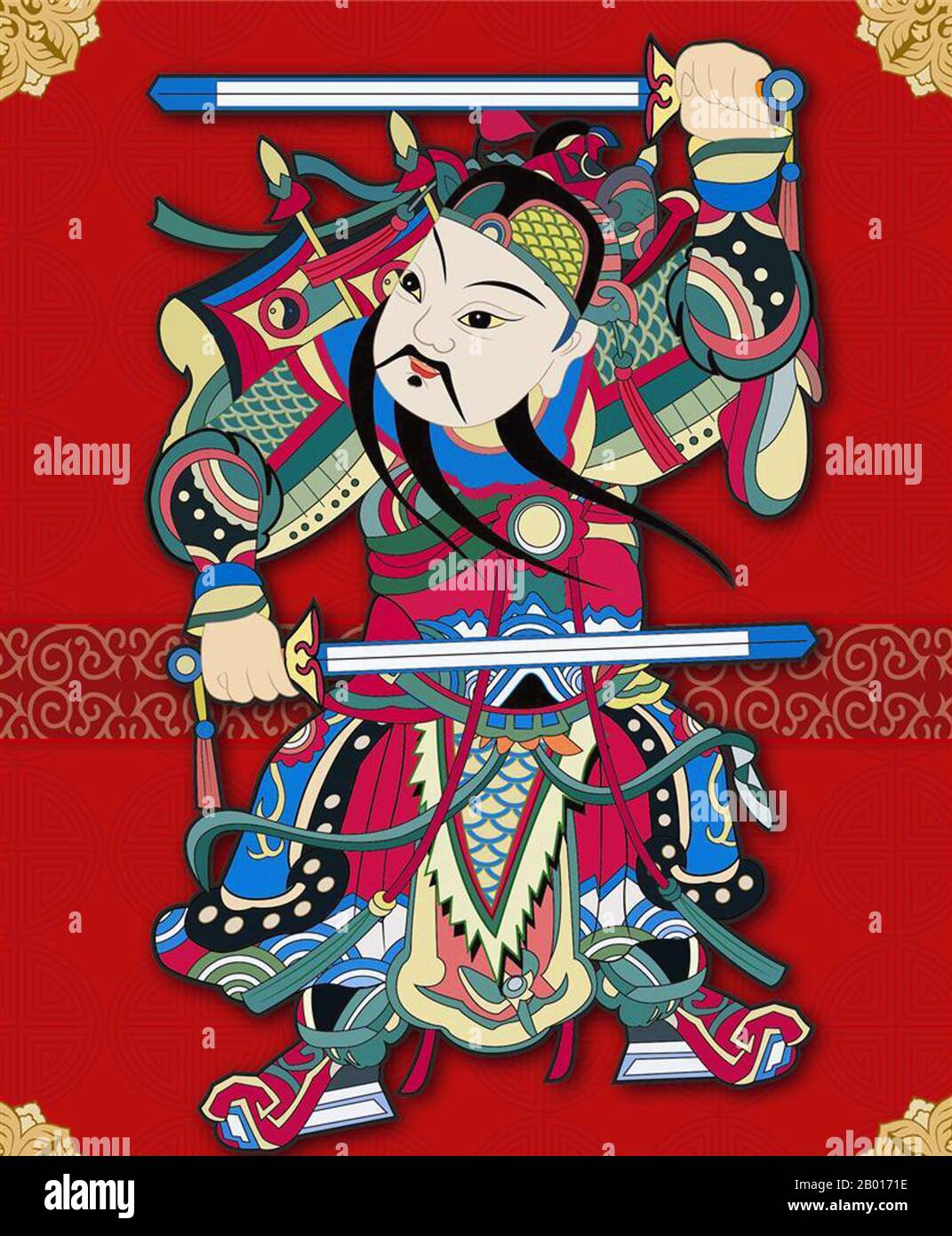 China: Zhong Kui, King of Ghosts, designed to protect businesses from intruders. Zhong Kui (Wade-Giles: Chung Kwei, Japanese: Shōki) is a figure of Chinese mythology. Traditionally regarded as a vanquisher of ghosts and evil beings, and reputedly able to command 80,000 demons, his image is often painted on household gates as a guardian spirit, as well as in places of business where high-value goods are involved. Zhong Kui's popularity in folklore can be traced to the reign of Emperor Xuanzong of Tang (712-756). Stock Photohttps://www.alamy.com/image-license-details/?v=1https://www.alamy.com/china-zhong-kui-king-of-ghosts-designed-to-protect-businesses-from-intruders-zhong-kui-wade-giles-chung-kwei-japanese-shki-is-a-figure-of-chinese-mythology-traditionally-regarded-as-a-vanquisher-of-ghosts-and-evil-beings-and-reputedly-able-to-command-80000-demons-his-image-is-often-painted-on-household-gates-as-a-guardian-spirit-as-well-as-in-places-of-business-where-high-value-goods-are-involved-zhong-kuis-popularity-in-folklore-can-be-traced-to-the-reign-of-emperor-xuanzong-of-tang-712-756-image344234842.html
China: Zhong Kui, King of Ghosts, designed to protect businesses from intruders. Zhong Kui (Wade-Giles: Chung Kwei, Japanese: Shōki) is a figure of Chinese mythology. Traditionally regarded as a vanquisher of ghosts and evil beings, and reputedly able to command 80,000 demons, his image is often painted on household gates as a guardian spirit, as well as in places of business where high-value goods are involved. Zhong Kui's popularity in folklore can be traced to the reign of Emperor Xuanzong of Tang (712-756). Stock Photohttps://www.alamy.com/image-license-details/?v=1https://www.alamy.com/china-zhong-kui-king-of-ghosts-designed-to-protect-businesses-from-intruders-zhong-kui-wade-giles-chung-kwei-japanese-shki-is-a-figure-of-chinese-mythology-traditionally-regarded-as-a-vanquisher-of-ghosts-and-evil-beings-and-reputedly-able-to-command-80000-demons-his-image-is-often-painted-on-household-gates-as-a-guardian-spirit-as-well-as-in-places-of-business-where-high-value-goods-are-involved-zhong-kuis-popularity-in-folklore-can-be-traced-to-the-reign-of-emperor-xuanzong-of-tang-712-756-image344234842.htmlRM2B0171E–China: Zhong Kui, King of Ghosts, designed to protect businesses from intruders. Zhong Kui (Wade-Giles: Chung Kwei, Japanese: Shōki) is a figure of Chinese mythology. Traditionally regarded as a vanquisher of ghosts and evil beings, and reputedly able to command 80,000 demons, his image is often painted on household gates as a guardian spirit, as well as in places of business where high-value goods are involved. Zhong Kui's popularity in folklore can be traced to the reign of Emperor Xuanzong of Tang (712-756).
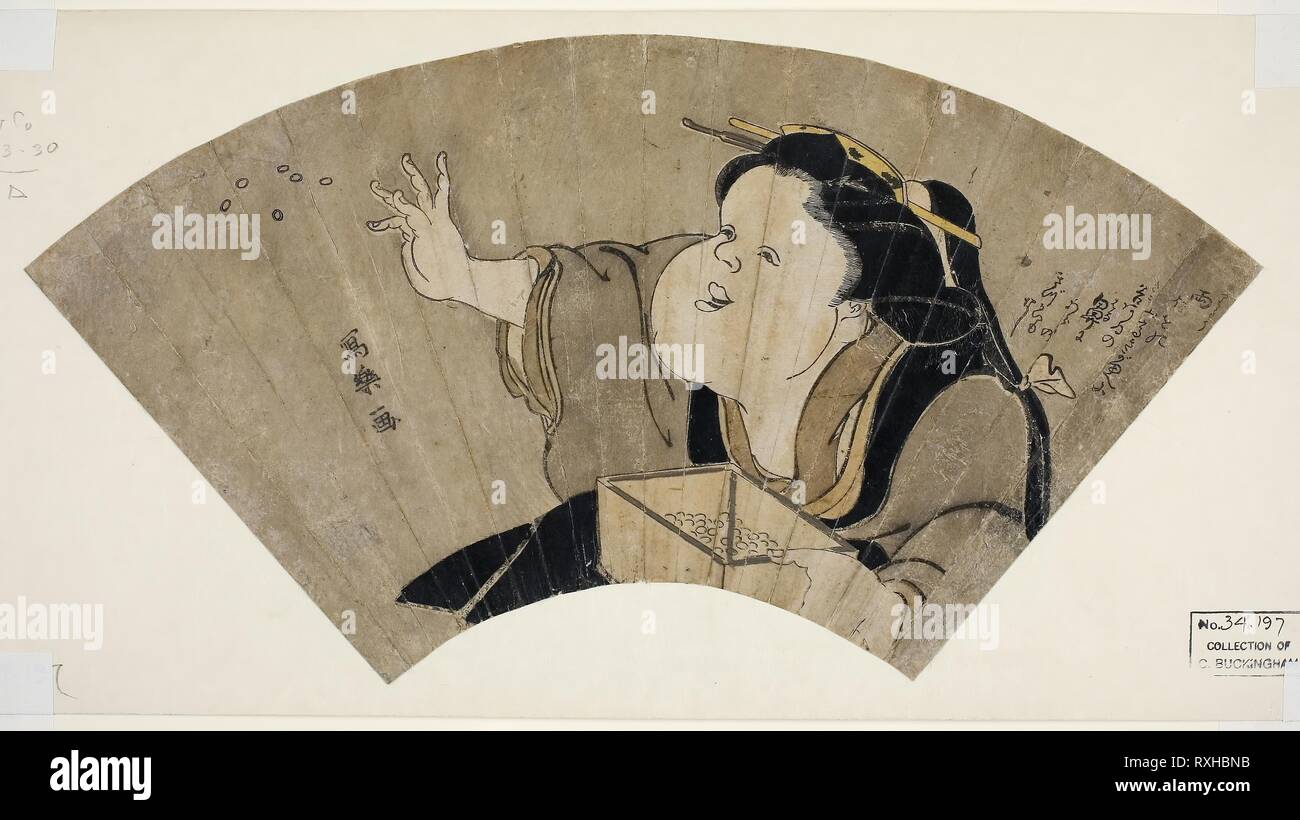 Otafuku Throwing Black Beans to Chase Away the Demons on New Year's Eve (Senmen Otafuku zu). Toshusai Sharaku ??? ??; Japanese, active 1794-95. Date: 1794-1795. Dimensions: 21.2 x 40.8 cm. Fan print, stencil-printed color on paper. Origin: Japan. Museum: The Chicago Art Institute. Stock Photohttps://www.alamy.com/image-license-details/?v=1https://www.alamy.com/otafuku-throwing-black-beans-to-chase-away-the-demons-on-new-years-eve-senmen-otafuku-zu-toshusai-sharaku-japanese-active-1794-95-date-1794-1795-dimensions-212-x-408-cm-fan-print-stencil-printed-color-on-paper-origin-japan-museum-the-chicago-art-institute-image240098247.html
Otafuku Throwing Black Beans to Chase Away the Demons on New Year's Eve (Senmen Otafuku zu). Toshusai Sharaku ??? ??; Japanese, active 1794-95. Date: 1794-1795. Dimensions: 21.2 x 40.8 cm. Fan print, stencil-printed color on paper. Origin: Japan. Museum: The Chicago Art Institute. Stock Photohttps://www.alamy.com/image-license-details/?v=1https://www.alamy.com/otafuku-throwing-black-beans-to-chase-away-the-demons-on-new-years-eve-senmen-otafuku-zu-toshusai-sharaku-japanese-active-1794-95-date-1794-1795-dimensions-212-x-408-cm-fan-print-stencil-printed-color-on-paper-origin-japan-museum-the-chicago-art-institute-image240098247.htmlRMRXHBNB–Otafuku Throwing Black Beans to Chase Away the Demons on New Year's Eve (Senmen Otafuku zu). Toshusai Sharaku ??? ??; Japanese, active 1794-95. Date: 1794-1795. Dimensions: 21.2 x 40.8 cm. Fan print, stencil-printed color on paper. Origin: Japan. Museum: The Chicago Art Institute.
 Art inspired by Green Peas in a Measure and Sprays of Hollyhock with Heads of Sardines; Symbols Representing the Ceremony of Exorcising Demons, Edo period (1615–1868), 19th century, Japan, Polychrome woodblock print (surimono); ink and color on paper, 7 7/8 x 7 3/16 in. (20 x 18.3 cm, Classic works modernized by Artotop with a splash of modernity. Shapes, color and value, eye-catching visual impact on art. Emotions through freedom of artworks in a contemporary way. A timeless message pursuing a wildly creative new direction. Artists turning to the digital medium and creating the Artotop NFT Stock Photohttps://www.alamy.com/image-license-details/?v=1https://www.alamy.com/art-inspired-by-green-peas-in-a-measure-and-sprays-of-hollyhock-with-heads-of-sardines-symbols-representing-the-ceremony-of-exorcising-demons-edo-period-16151868-19th-century-japan-polychrome-woodblock-print-surimono-ink-and-color-on-paper-7-78-x-7-316-in-20-x-183-cm-classic-works-modernized-by-artotop-with-a-splash-of-modernity-shapes-color-and-value-eye-catching-visual-impact-on-art-emotions-through-freedom-of-artworks-in-a-contemporary-way-a-timeless-message-pursuing-a-wildly-creative-new-direction-artists-turning-to-the-digital-medium-and-creating-the-artotop-nft-image462914389.html
Art inspired by Green Peas in a Measure and Sprays of Hollyhock with Heads of Sardines; Symbols Representing the Ceremony of Exorcising Demons, Edo period (1615–1868), 19th century, Japan, Polychrome woodblock print (surimono); ink and color on paper, 7 7/8 x 7 3/16 in. (20 x 18.3 cm, Classic works modernized by Artotop with a splash of modernity. Shapes, color and value, eye-catching visual impact on art. Emotions through freedom of artworks in a contemporary way. A timeless message pursuing a wildly creative new direction. Artists turning to the digital medium and creating the Artotop NFT Stock Photohttps://www.alamy.com/image-license-details/?v=1https://www.alamy.com/art-inspired-by-green-peas-in-a-measure-and-sprays-of-hollyhock-with-heads-of-sardines-symbols-representing-the-ceremony-of-exorcising-demons-edo-period-16151868-19th-century-japan-polychrome-woodblock-print-surimono-ink-and-color-on-paper-7-78-x-7-316-in-20-x-183-cm-classic-works-modernized-by-artotop-with-a-splash-of-modernity-shapes-color-and-value-eye-catching-visual-impact-on-art-emotions-through-freedom-of-artworks-in-a-contemporary-way-a-timeless-message-pursuing-a-wildly-creative-new-direction-artists-turning-to-the-digital-medium-and-creating-the-artotop-nft-image462914389.htmlRF2HW3G0N–Art inspired by Green Peas in a Measure and Sprays of Hollyhock with Heads of Sardines; Symbols Representing the Ceremony of Exorcising Demons, Edo period (1615–1868), 19th century, Japan, Polychrome woodblock print (surimono); ink and color on paper, 7 7/8 x 7 3/16 in. (20 x 18.3 cm, Classic works modernized by Artotop with a splash of modernity. Shapes, color and value, eye-catching visual impact on art. Emotions through freedom of artworks in a contemporary way. A timeless message pursuing a wildly creative new direction. Artists turning to the digital medium and creating the Artotop NFT
 Shot during a visit to Kyoto´s Imperial Palace Stock Photohttps://www.alamy.com/image-license-details/?v=1https://www.alamy.com/stock-photo-shot-during-a-visit-to-kyotos-imperial-palace-89678233.html
Shot during a visit to Kyoto´s Imperial Palace Stock Photohttps://www.alamy.com/image-license-details/?v=1https://www.alamy.com/stock-photo-shot-during-a-visit-to-kyotos-imperial-palace-89678233.htmlRFF5W5E1–Shot during a visit to Kyoto´s Imperial Palace
 Immerse yourself in the captivating world of Japanese arts with our stunning collection of vector art files, Vector Oni Hannya masks. Stock Vectorhttps://www.alamy.com/image-license-details/?v=1https://www.alamy.com/immerse-yourself-in-the-captivating-world-of-japanese-arts-with-our-stunning-collection-of-vector-art-files-vector-oni-hannya-masks-image595843428.html
Immerse yourself in the captivating world of Japanese arts with our stunning collection of vector art files, Vector Oni Hannya masks. Stock Vectorhttps://www.alamy.com/image-license-details/?v=1https://www.alamy.com/immerse-yourself-in-the-captivating-world-of-japanese-arts-with-our-stunning-collection-of-vector-art-files-vector-oni-hannya-masks-image595843428.htmlRF2WHB0AC–Immerse yourself in the captivating world of Japanese arts with our stunning collection of vector art files, Vector Oni Hannya masks.
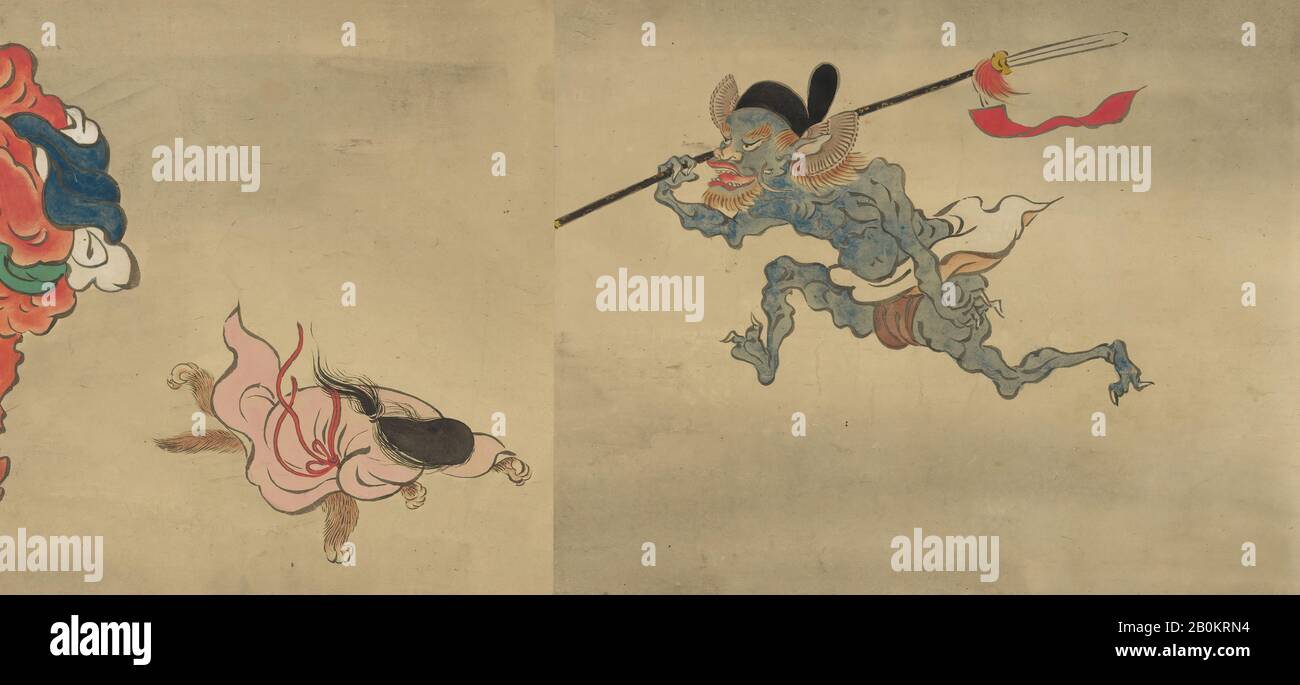 Mochizuki Gyokusen, Copy of Night Parade of One Hundred Demons from the Shinjuan Collection, Japan, Edo period (1615–1868), Mochizuki Gyokusen (Japanese, 1692–1755), 18th century, Japan, Handscroll; ink and color on paper, Image: 12 3/8 in. × 11 ft. 7/8 in. (31.4 × 337.5 cm), Overall with mounting: 12 7/16 in. × 13 ft. 1 1/2 in. (31.6 × 400 cm), Overall with knobs: 13 3/4 in. × 13 ft. 1 1/2 in. (34.9 × 400 cm), Paintings Stock Photohttps://www.alamy.com/image-license-details/?v=1https://www.alamy.com/mochizuki-gyokusen-copy-of-night-parade-of-one-hundred-demons-from-the-shinjuan-collection-japan-edo-period-16151868-mochizuki-gyokusen-japanese-16921755-18th-century-japan-handscroll-ink-and-color-on-paper-image-12-38-in-11-ft-78-in-314-3375-cm-overall-with-mounting-12-716-in-13-ft-1-12-in-316-400-cm-overall-with-knobs-13-34-in-13-ft-1-12-in-349-400-cm-paintings-image344643072.html
Mochizuki Gyokusen, Copy of Night Parade of One Hundred Demons from the Shinjuan Collection, Japan, Edo period (1615–1868), Mochizuki Gyokusen (Japanese, 1692–1755), 18th century, Japan, Handscroll; ink and color on paper, Image: 12 3/8 in. × 11 ft. 7/8 in. (31.4 × 337.5 cm), Overall with mounting: 12 7/16 in. × 13 ft. 1 1/2 in. (31.6 × 400 cm), Overall with knobs: 13 3/4 in. × 13 ft. 1 1/2 in. (34.9 × 400 cm), Paintings Stock Photohttps://www.alamy.com/image-license-details/?v=1https://www.alamy.com/mochizuki-gyokusen-copy-of-night-parade-of-one-hundred-demons-from-the-shinjuan-collection-japan-edo-period-16151868-mochizuki-gyokusen-japanese-16921755-18th-century-japan-handscroll-ink-and-color-on-paper-image-12-38-in-11-ft-78-in-314-3375-cm-overall-with-mounting-12-716-in-13-ft-1-12-in-316-400-cm-overall-with-knobs-13-34-in-13-ft-1-12-in-349-400-cm-paintings-image344643072.htmlRM2B0KRN4–Mochizuki Gyokusen, Copy of Night Parade of One Hundred Demons from the Shinjuan Collection, Japan, Edo period (1615–1868), Mochizuki Gyokusen (Japanese, 1692–1755), 18th century, Japan, Handscroll; ink and color on paper, Image: 12 3/8 in. × 11 ft. 7/8 in. (31.4 × 337.5 cm), Overall with mounting: 12 7/16 in. × 13 ft. 1 1/2 in. (31.6 × 400 cm), Overall with knobs: 13 3/4 in. × 13 ft. 1 1/2 in. (34.9 × 400 cm), Paintings
 Jatai, Konjaku Hyakki Shūi Second Volume Mist, published ca. 1781, by Japanese artist Sekien Toriyama ( 1712 - 1788 ) Stock Photohttps://www.alamy.com/image-license-details/?v=1https://www.alamy.com/jatai-konjaku-hyakki-shi-second-volume-mist-published-ca-1781-by-japanese-artist-sekien-toriyama-1712-1788-image208345588.html
Jatai, Konjaku Hyakki Shūi Second Volume Mist, published ca. 1781, by Japanese artist Sekien Toriyama ( 1712 - 1788 ) Stock Photohttps://www.alamy.com/image-license-details/?v=1https://www.alamy.com/jatai-konjaku-hyakki-shi-second-volume-mist-published-ca-1781-by-japanese-artist-sekien-toriyama-1712-1788-image208345588.htmlRMP2XXWT–Jatai, Konjaku Hyakki Shūi Second Volume Mist, published ca. 1781, by Japanese artist Sekien Toriyama ( 1712 - 1788 )
 Night Parade of One Hundred Demons, c. 1830s, Attributed to Eigyō, Japanese, active c. 1830s, 9 3/16 × 192 11/16 in. (23.34 × 489.43 cm) (image), Ink and color on paper, Japan, 19th century, Since ancient times, the legend exists in Japan that demons and other supernatural beings parade through the streets at night until the light of the rising sun drives them off. The earliest illustrated handscroll on this theme dated to the early 14th century but is no longer existing. In the 16th century works developed that share a variety of pictorial motifs, presenting the demons as both grotesque Stock Photohttps://www.alamy.com/image-license-details/?v=1https://www.alamy.com/night-parade-of-one-hundred-demons-c-1830s-attributed-to-eigy-japanese-active-c-1830s-9-316-192-1116-in-2334-48943-cm-image-ink-and-color-on-paper-japan-19th-century-since-ancient-times-the-legend-exists-in-japan-that-demons-and-other-supernatural-beings-parade-through-the-streets-at-night-until-the-light-of-the-rising-sun-drives-them-off-the-earliest-illustrated-handscroll-on-this-theme-dated-to-the-early-14th-century-but-is-no-longer-existing-in-the-16th-century-works-developed-that-share-a-variety-of-pictorial-motifs-presenting-the-demons-as-both-grotesque-image573486181.html
Night Parade of One Hundred Demons, c. 1830s, Attributed to Eigyō, Japanese, active c. 1830s, 9 3/16 × 192 11/16 in. (23.34 × 489.43 cm) (image), Ink and color on paper, Japan, 19th century, Since ancient times, the legend exists in Japan that demons and other supernatural beings parade through the streets at night until the light of the rising sun drives them off. The earliest illustrated handscroll on this theme dated to the early 14th century but is no longer existing. In the 16th century works developed that share a variety of pictorial motifs, presenting the demons as both grotesque Stock Photohttps://www.alamy.com/image-license-details/?v=1https://www.alamy.com/night-parade-of-one-hundred-demons-c-1830s-attributed-to-eigy-japanese-active-c-1830s-9-316-192-1116-in-2334-48943-cm-image-ink-and-color-on-paper-japan-19th-century-since-ancient-times-the-legend-exists-in-japan-that-demons-and-other-supernatural-beings-parade-through-the-streets-at-night-until-the-light-of-the-rising-sun-drives-them-off-the-earliest-illustrated-handscroll-on-this-theme-dated-to-the-early-14th-century-but-is-no-longer-existing-in-the-16th-century-works-developed-that-share-a-variety-of-pictorial-motifs-presenting-the-demons-as-both-grotesque-image573486181.htmlRM2T90FD9–Night Parade of One Hundred Demons, c. 1830s, Attributed to Eigyō, Japanese, active c. 1830s, 9 3/16 × 192 11/16 in. (23.34 × 489.43 cm) (image), Ink and color on paper, Japan, 19th century, Since ancient times, the legend exists in Japan that demons and other supernatural beings parade through the streets at night until the light of the rising sun drives them off. The earliest illustrated handscroll on this theme dated to the early 14th century but is no longer existing. In the 16th century works developed that share a variety of pictorial motifs, presenting the demons as both grotesque
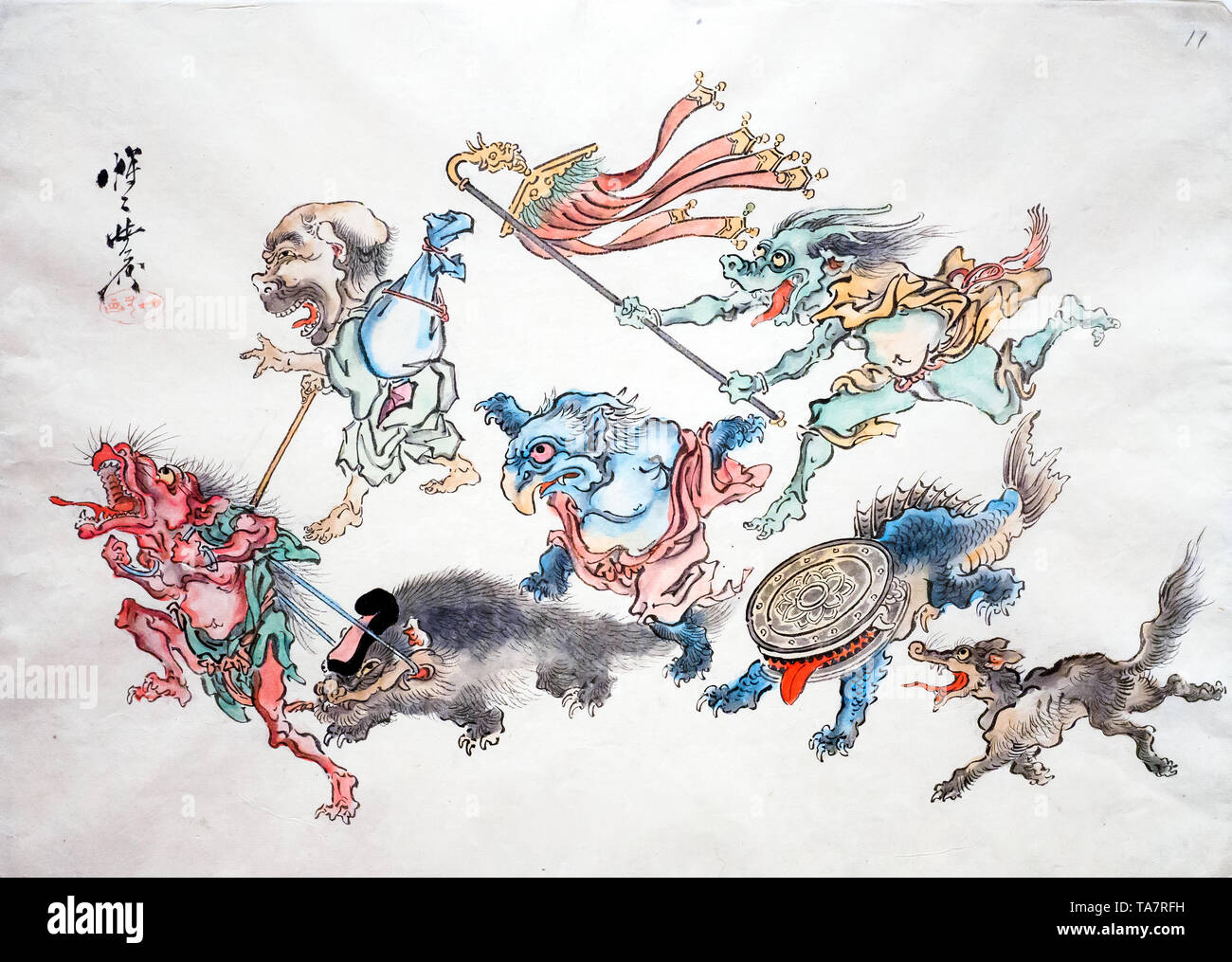 Night procession of hundred demons By Kawanabe Kyosai (1831-1889) Painting ink and colour on paper, about 1879 Stock Photohttps://www.alamy.com/image-license-details/?v=1https://www.alamy.com/night-procession-of-hundred-demons-by-kawanabe-kyosai-1831-1889-painting-ink-and-colour-on-paper-about-1879-image247263845.html
Night procession of hundred demons By Kawanabe Kyosai (1831-1889) Painting ink and colour on paper, about 1879 Stock Photohttps://www.alamy.com/image-license-details/?v=1https://www.alamy.com/night-procession-of-hundred-demons-by-kawanabe-kyosai-1831-1889-painting-ink-and-colour-on-paper-about-1879-image247263845.htmlRMTA7RFH–Night procession of hundred demons By Kawanabe Kyosai (1831-1889) Painting ink and colour on paper, about 1879
 The Tsugaru Shamisen Players from Japan performing the Traditional Sword Dance of the Demons on Stage Stock Photohttps://www.alamy.com/image-license-details/?v=1https://www.alamy.com/stock-photo-the-tsugaru-shamisen-players-from-japan-performing-the-traditional-13094188.html
The Tsugaru Shamisen Players from Japan performing the Traditional Sword Dance of the Demons on Stage Stock Photohttps://www.alamy.com/image-license-details/?v=1https://www.alamy.com/stock-photo-the-tsugaru-shamisen-players-from-japan-performing-the-traditional-13094188.htmlRMACADDH–The Tsugaru Shamisen Players from Japan performing the Traditional Sword Dance of the Demons on Stage
 Garden dedicated to Buddhist priest Rocho, who vowed to drive away demons, near Ishiyamadera temple, in Otsu, Shiga Prefecture, Kansai region, Japan. Stock Photohttps://www.alamy.com/image-license-details/?v=1https://www.alamy.com/garden-dedicated-to-buddhist-priest-rocho-who-vowed-to-drive-away-demons-near-ishiyamadera-temple-in-otsu-shiga-prefecture-kansai-region-japan-image611463694.html
Garden dedicated to Buddhist priest Rocho, who vowed to drive away demons, near Ishiyamadera temple, in Otsu, Shiga Prefecture, Kansai region, Japan. Stock Photohttps://www.alamy.com/image-license-details/?v=1https://www.alamy.com/garden-dedicated-to-buddhist-priest-rocho-who-vowed-to-drive-away-demons-near-ishiyamadera-temple-in-otsu-shiga-prefecture-kansai-region-japan-image611463694.htmlRF2XEPG52–Garden dedicated to Buddhist priest Rocho, who vowed to drive away demons, near Ishiyamadera temple, in Otsu, Shiga Prefecture, Kansai region, Japan.
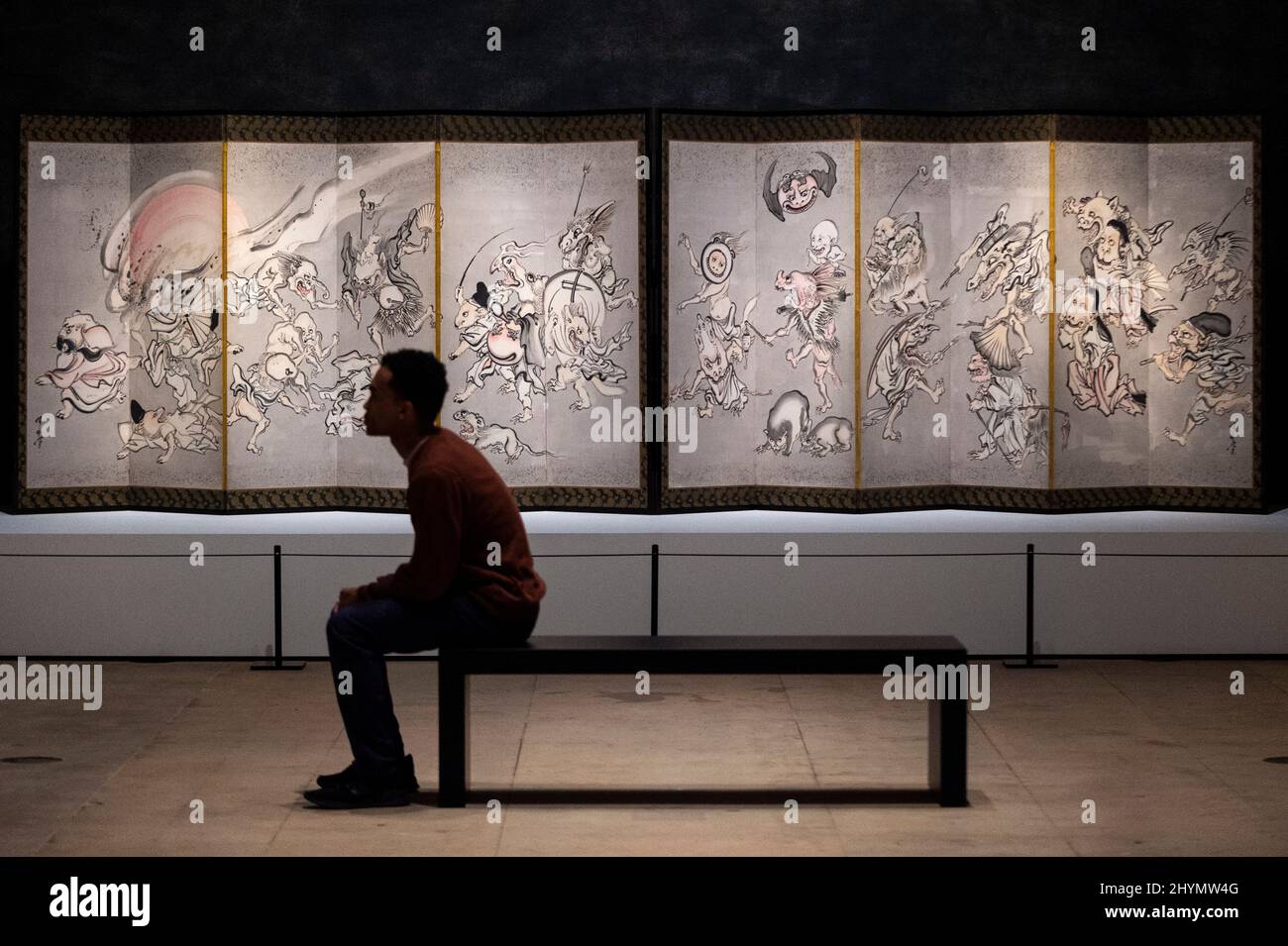 London, UK. 15 March 2022. A staff member views 'Night Procession of One Hundred Demons', 1871/89, by Kawanabe Kyōsai. Preview of Kyōsai: The Israel Goldman Collection exhibition at the Royal Academy of Arts where 80 works by late 19th century Japanese painter Kawanabe Kyōsai are on display 19 March to 19 June 2022 in the artist’s first solo UK exhibition in 30 years. Credit: Stephen Chung / Alamy Live News Stock Photohttps://www.alamy.com/image-license-details/?v=1https://www.alamy.com/london-uk-15-march-2022-a-staff-member-views-night-procession-of-one-hundred-demons-187189-by-kawanabe-kysai-preview-of-kysai-the-israel-goldman-collection-exhibition-at-the-royal-academy-of-arts-where-80-works-by-late-19th-century-japanese-painter-kawanabe-kysai-are-on-display-19-march-to-19-june-2022-in-the-artists-first-solo-uk-exhibition-in-30-years-credit-stephen-chung-alamy-live-news-image464524048.html
London, UK. 15 March 2022. A staff member views 'Night Procession of One Hundred Demons', 1871/89, by Kawanabe Kyōsai. Preview of Kyōsai: The Israel Goldman Collection exhibition at the Royal Academy of Arts where 80 works by late 19th century Japanese painter Kawanabe Kyōsai are on display 19 March to 19 June 2022 in the artist’s first solo UK exhibition in 30 years. Credit: Stephen Chung / Alamy Live News Stock Photohttps://www.alamy.com/image-license-details/?v=1https://www.alamy.com/london-uk-15-march-2022-a-staff-member-views-night-procession-of-one-hundred-demons-187189-by-kawanabe-kysai-preview-of-kysai-the-israel-goldman-collection-exhibition-at-the-royal-academy-of-arts-where-80-works-by-late-19th-century-japanese-painter-kawanabe-kysai-are-on-display-19-march-to-19-june-2022-in-the-artists-first-solo-uk-exhibition-in-30-years-credit-stephen-chung-alamy-live-news-image464524048.htmlRM2HYMW4G–London, UK. 15 March 2022. A staff member views 'Night Procession of One Hundred Demons', 1871/89, by Kawanabe Kyōsai. Preview of Kyōsai: The Israel Goldman Collection exhibition at the Royal Academy of Arts where 80 works by late 19th century Japanese painter Kawanabe Kyōsai are on display 19 March to 19 June 2022 in the artist’s first solo UK exhibition in 30 years. Credit: Stephen Chung / Alamy Live News
 Shoki san jaki ni sokuto (Shoki Destroys Evil Demons), 1858. Stock Photohttps://www.alamy.com/image-license-details/?v=1https://www.alamy.com/shoki-san-jaki-ni-sokuto-shoki-destroys-evil-demons-1858-image228940397.html
Shoki san jaki ni sokuto (Shoki Destroys Evil Demons), 1858. Stock Photohttps://www.alamy.com/image-license-details/?v=1https://www.alamy.com/shoki-san-jaki-ni-sokuto-shoki-destroys-evil-demons-1858-image228940397.htmlRMR8D3PN–Shoki san jaki ni sokuto (Shoki Destroys Evil Demons), 1858.
 . English: Yokai/' Night March of a Hundred Demons' scroll by Tosa Mitsuoki. Tosa Mitsuoki (Japanese: 土佐 光起; 1617–November 14, 1691) was a Japanese painter. Tosa was born in Sakai, Osaka, the son of Tosa Mitsunori (1583–1638), also a painter. His original name was Tosa Fujimitsu, also called Tsuneaki. Tosa lived in the early Edo period (1603–1867). He revived the Tosa school of painting, recapturing the title of official court artist. He died in Kyoto. 1600s. Tosa Mitsuki 289 Hyakki Yako no Zu by Tosa Mitsuoki- right half Stock Photohttps://www.alamy.com/image-license-details/?v=1https://www.alamy.com/english-yokai-night-march-of-a-hundred-demons-scroll-by-tosa-mitsuoki-tosa-mitsuoki-japanese-1617november-14-1691-was-a-japanese-painter-tosa-was-born-in-sakai-osaka-the-son-of-tosa-mitsunori-15831638-also-a-painter-his-original-name-was-tosa-fujimitsu-also-called-tsuneaki-tosa-lived-in-the-early-edo-period-16031867-he-revived-the-tosa-school-of-painting-recapturing-the-title-of-official-court-artist-he-died-in-kyoto-1600s-tosa-mitsuki-289-hyakki-yako-no-zu-by-tosa-mitsuoki-right-half-image188308717.html
. English: Yokai/' Night March of a Hundred Demons' scroll by Tosa Mitsuoki. Tosa Mitsuoki (Japanese: 土佐 光起; 1617–November 14, 1691) was a Japanese painter. Tosa was born in Sakai, Osaka, the son of Tosa Mitsunori (1583–1638), also a painter. His original name was Tosa Fujimitsu, also called Tsuneaki. Tosa lived in the early Edo period (1603–1867). He revived the Tosa school of painting, recapturing the title of official court artist. He died in Kyoto. 1600s. Tosa Mitsuki 289 Hyakki Yako no Zu by Tosa Mitsuoki- right half Stock Photohttps://www.alamy.com/image-license-details/?v=1https://www.alamy.com/english-yokai-night-march-of-a-hundred-demons-scroll-by-tosa-mitsuoki-tosa-mitsuoki-japanese-1617november-14-1691-was-a-japanese-painter-tosa-was-born-in-sakai-osaka-the-son-of-tosa-mitsunori-15831638-also-a-painter-his-original-name-was-tosa-fujimitsu-also-called-tsuneaki-tosa-lived-in-the-early-edo-period-16031867-he-revived-the-tosa-school-of-painting-recapturing-the-title-of-official-court-artist-he-died-in-kyoto-1600s-tosa-mitsuki-289-hyakki-yako-no-zu-by-tosa-mitsuoki-right-half-image188308717.htmlRMMXA5K9–. English: Yokai/' Night March of a Hundred Demons' scroll by Tosa Mitsuoki. Tosa Mitsuoki (Japanese: 土佐 光起; 1617–November 14, 1691) was a Japanese painter. Tosa was born in Sakai, Osaka, the son of Tosa Mitsunori (1583–1638), also a painter. His original name was Tosa Fujimitsu, also called Tsuneaki. Tosa lived in the early Edo period (1603–1867). He revived the Tosa school of painting, recapturing the title of official court artist. He died in Kyoto. 1600s. Tosa Mitsuki 289 Hyakki Yako no Zu by Tosa Mitsuoki- right half
 Gaki Zoshi (Hungry Ghosts Scroll), detail, color on paper, Heian period, 12th century Stock Photohttps://www.alamy.com/image-license-details/?v=1https://www.alamy.com/gaki-zoshi-hungry-ghosts-scroll-detail-color-on-paper-heian-period-12th-century-image261114394.html
Gaki Zoshi (Hungry Ghosts Scroll), detail, color on paper, Heian period, 12th century Stock Photohttps://www.alamy.com/image-license-details/?v=1https://www.alamy.com/gaki-zoshi-hungry-ghosts-scroll-detail-color-on-paper-heian-period-12th-century-image261114394.htmlRFW4PP22–Gaki Zoshi (Hungry Ghosts Scroll), detail, color on paper, Heian period, 12th century
 Kumano, Japan coast line at Onigajo 'Devil's Castle' rocks on the coastline. Stock Photohttps://www.alamy.com/image-license-details/?v=1https://www.alamy.com/kumano-japan-coast-line-at-onigajo-devils-castle-rocks-on-the-coastline-image153568160.html
Kumano, Japan coast line at Onigajo 'Devil's Castle' rocks on the coastline. Stock Photohttps://www.alamy.com/image-license-details/?v=1https://www.alamy.com/kumano-japan-coast-line-at-onigajo-devils-castle-rocks-on-the-coastline-image153568160.htmlRFJWRHN4–Kumano, Japan coast line at Onigajo 'Devil's Castle' rocks on the coastline.
 Venice, Biennale 2013, Japanese artist Shinichi Sawada, Art Brut monstrous creatures made of clay sculptures Stock Photohttps://www.alamy.com/image-license-details/?v=1https://www.alamy.com/stock-photo-venice-biennale-2013-japanese-artist-shinichi-sawada-art-brut-monstrous-73383659.html
Venice, Biennale 2013, Japanese artist Shinichi Sawada, Art Brut monstrous creatures made of clay sculptures Stock Photohttps://www.alamy.com/image-license-details/?v=1https://www.alamy.com/stock-photo-venice-biennale-2013-japanese-artist-shinichi-sawada-art-brut-monstrous-73383659.htmlRME7AWGY–Venice, Biennale 2013, Japanese artist Shinichi Sawada, Art Brut monstrous creatures made of clay sculptures
 Mounted soldiers fighting demons. Taishokkan. early Edo period (1640-1680). Kowakamai manuscript dealing with the life of Fujiwara no Kamatari, his daughter and a precious crystal ball. Image taken from Taishokkan. Originally published/produced in early Edo period (1640-1680). . Source: Or. 13129 volume 1, f.28. Language: Japanese. Stock Photohttps://www.alamy.com/image-license-details/?v=1https://www.alamy.com/mounted-soldiers-fighting-demons-taishokkan-early-edo-period-1640-1680-kowakamai-manuscript-dealing-with-the-life-of-fujiwara-no-kamatari-his-daughter-and-a-precious-crystal-ball-image-taken-from-taishokkan-originally-publishedproduced-in-early-edo-period-1640-1680-source-or-13129-volume-1-f28-language-japanese-image227037935.html
Mounted soldiers fighting demons. Taishokkan. early Edo period (1640-1680). Kowakamai manuscript dealing with the life of Fujiwara no Kamatari, his daughter and a precious crystal ball. Image taken from Taishokkan. Originally published/produced in early Edo period (1640-1680). . Source: Or. 13129 volume 1, f.28. Language: Japanese. Stock Photohttps://www.alamy.com/image-license-details/?v=1https://www.alamy.com/mounted-soldiers-fighting-demons-taishokkan-early-edo-period-1640-1680-kowakamai-manuscript-dealing-with-the-life-of-fujiwara-no-kamatari-his-daughter-and-a-precious-crystal-ball-image-taken-from-taishokkan-originally-publishedproduced-in-early-edo-period-1640-1680-source-or-13129-volume-1-f28-language-japanese-image227037935.htmlRMR5AD5K–Mounted soldiers fighting demons. Taishokkan. early Edo period (1640-1680). Kowakamai manuscript dealing with the life of Fujiwara no Kamatari, his daughter and a precious crystal ball. Image taken from Taishokkan. Originally published/produced in early Edo period (1640-1680). . Source: Or. 13129 volume 1, f.28. Language: Japanese.
 YOKOSUKA, Japan (Feb. 3, 2023) – In a bid to experience a Japanese traditional bean-throwing ceremony, nearly 50 employees of NAVSUP FLC Yokosuka flocked into the command’s back patio in the cold. Chanting “oni wa soto, fuku wa uchi!” or “good fortune in, demons out!”, bean-throwers scattered soy beans at oni or demon mask-clad Sailors. The ritual is performed to drive away evil spirit and bring good luck on “Setsubun”, the last day of winter on the Japanese traditional calendar that usually falls on February 3. Stock Photohttps://www.alamy.com/image-license-details/?v=1https://www.alamy.com/yokosuka-japan-feb-3-2023-in-a-bid-to-experience-a-japanese-traditional-bean-throwing-ceremony-nearly-50-employees-of-navsup-flc-yokosuka-flocked-into-the-commands-back-patio-in-the-cold-chanting-oni-wa-soto-fuku-wa-uchi!-or-good-fortune-in-demons-out!-bean-throwers-scattered-soy-beans-at-oni-or-demon-mask-clad-sailors-the-ritual-is-performed-to-drive-away-evil-spirit-and-bring-good-luck-on-setsubun-the-last-day-of-winter-on-the-japanese-traditional-calendar-that-usually-falls-on-february-3-image534731224.html
YOKOSUKA, Japan (Feb. 3, 2023) – In a bid to experience a Japanese traditional bean-throwing ceremony, nearly 50 employees of NAVSUP FLC Yokosuka flocked into the command’s back patio in the cold. Chanting “oni wa soto, fuku wa uchi!” or “good fortune in, demons out!”, bean-throwers scattered soy beans at oni or demon mask-clad Sailors. The ritual is performed to drive away evil spirit and bring good luck on “Setsubun”, the last day of winter on the Japanese traditional calendar that usually falls on February 3. Stock Photohttps://www.alamy.com/image-license-details/?v=1https://www.alamy.com/yokosuka-japan-feb-3-2023-in-a-bid-to-experience-a-japanese-traditional-bean-throwing-ceremony-nearly-50-employees-of-navsup-flc-yokosuka-flocked-into-the-commands-back-patio-in-the-cold-chanting-oni-wa-soto-fuku-wa-uchi!-or-good-fortune-in-demons-out!-bean-throwers-scattered-soy-beans-at-oni-or-demon-mask-clad-sailors-the-ritual-is-performed-to-drive-away-evil-spirit-and-bring-good-luck-on-setsubun-the-last-day-of-winter-on-the-japanese-traditional-calendar-that-usually-falls-on-february-3-image534731224.htmlRM2P1Y33M–YOKOSUKA, Japan (Feb. 3, 2023) – In a bid to experience a Japanese traditional bean-throwing ceremony, nearly 50 employees of NAVSUP FLC Yokosuka flocked into the command’s back patio in the cold. Chanting “oni wa soto, fuku wa uchi!” or “good fortune in, demons out!”, bean-throwers scattered soy beans at oni or demon mask-clad Sailors. The ritual is performed to drive away evil spirit and bring good luck on “Setsubun”, the last day of winter on the Japanese traditional calendar that usually falls on February 3.
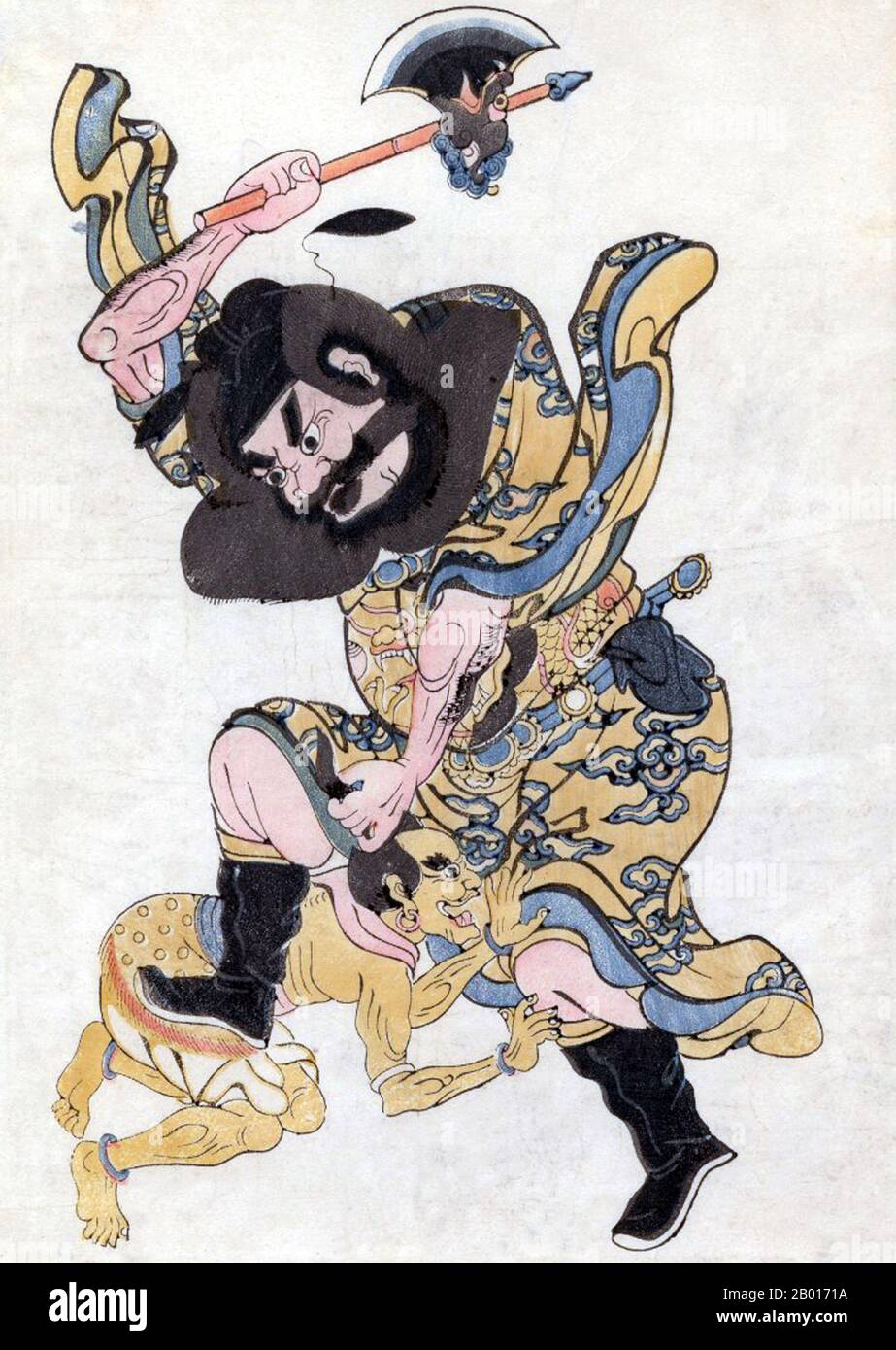 China: Zhong Kui assaulting a demon with an axe. Woodblock print, 17th century. Zhong Kui (Wade-Giles: Chung Kwei, Japanese: Shōki) is a figure of Chinese mythology. Traditionally regarded as a vanquisher of ghosts and evil beings, and reputedly able to command 80,000 demons, his image is often painted on household gates as a guardian spirit, as well as in places of business where high-value goods are involved. Zhong Kui's popularity in folklore can be traced to the reign of Emperor Xuanzong of Tang (712-756). Stock Photohttps://www.alamy.com/image-license-details/?v=1https://www.alamy.com/china-zhong-kui-assaulting-a-demon-with-an-axe-woodblock-print-17th-century-zhong-kui-wade-giles-chung-kwei-japanese-shki-is-a-figure-of-chinese-mythology-traditionally-regarded-as-a-vanquisher-of-ghosts-and-evil-beings-and-reputedly-able-to-command-80000-demons-his-image-is-often-painted-on-household-gates-as-a-guardian-spirit-as-well-as-in-places-of-business-where-high-value-goods-are-involved-zhong-kuis-popularity-in-folklore-can-be-traced-to-the-reign-of-emperor-xuanzong-of-tang-712-756-image344234838.html
China: Zhong Kui assaulting a demon with an axe. Woodblock print, 17th century. Zhong Kui (Wade-Giles: Chung Kwei, Japanese: Shōki) is a figure of Chinese mythology. Traditionally regarded as a vanquisher of ghosts and evil beings, and reputedly able to command 80,000 demons, his image is often painted on household gates as a guardian spirit, as well as in places of business where high-value goods are involved. Zhong Kui's popularity in folklore can be traced to the reign of Emperor Xuanzong of Tang (712-756). Stock Photohttps://www.alamy.com/image-license-details/?v=1https://www.alamy.com/china-zhong-kui-assaulting-a-demon-with-an-axe-woodblock-print-17th-century-zhong-kui-wade-giles-chung-kwei-japanese-shki-is-a-figure-of-chinese-mythology-traditionally-regarded-as-a-vanquisher-of-ghosts-and-evil-beings-and-reputedly-able-to-command-80000-demons-his-image-is-often-painted-on-household-gates-as-a-guardian-spirit-as-well-as-in-places-of-business-where-high-value-goods-are-involved-zhong-kuis-popularity-in-folklore-can-be-traced-to-the-reign-of-emperor-xuanzong-of-tang-712-756-image344234838.htmlRM2B0171A–China: Zhong Kui assaulting a demon with an axe. Woodblock print, 17th century. Zhong Kui (Wade-Giles: Chung Kwei, Japanese: Shōki) is a figure of Chinese mythology. Traditionally regarded as a vanquisher of ghosts and evil beings, and reputedly able to command 80,000 demons, his image is often painted on household gates as a guardian spirit, as well as in places of business where high-value goods are involved. Zhong Kui's popularity in folklore can be traced to the reign of Emperor Xuanzong of Tang (712-756).
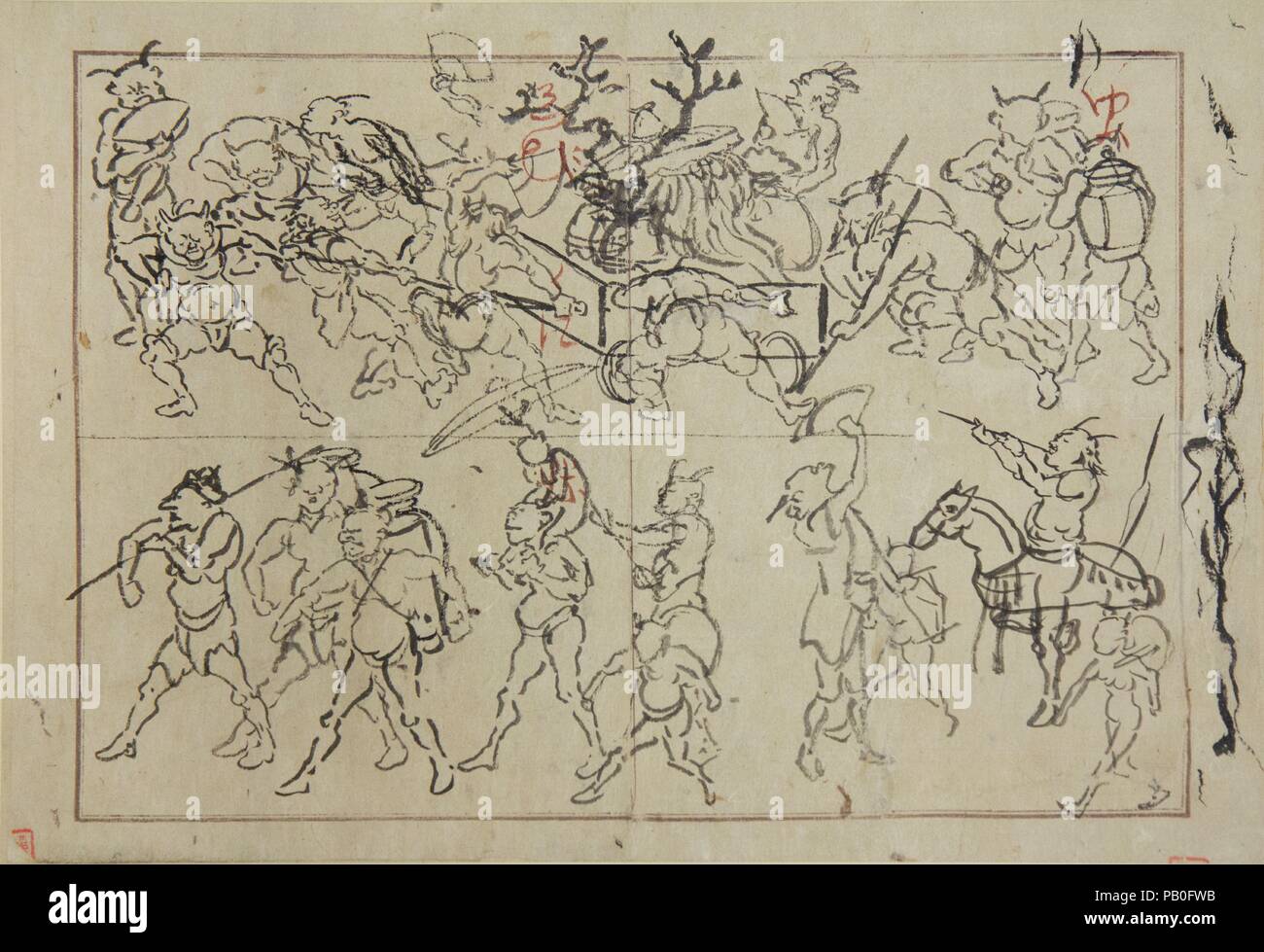 Preliminary Drawings of Demons. Artist: Kawanabe Kyosai (Japanese, 1831-1889). Culture: Japan. Dimensions: 9 1/8 x 13 1/4 in. (23.2 x 33.7 cm). Date: late 19th century. These sketches in the distinctive drawing style of Kawanabe Kyosai appear to be preliminary drawings for an illustrated book. Like the images of dancers in the Met's collection (37.119.6), they were formerly in the collection of his pupil Mano Kyotei (Yasokichi, 1874/5-1937). Museum: Metropolitan Museum of Art, New York, USA. Stock Photohttps://www.alamy.com/image-license-details/?v=1https://www.alamy.com/preliminary-drawings-of-demons-artist-kawanabe-kyosai-japanese-1831-1889-culture-japan-dimensions-9-18-x-13-14-in-232-x-337-cm-date-late-19th-century-these-sketches-in-the-distinctive-drawing-style-of-kawanabe-kyosai-appear-to-be-preliminary-drawings-for-an-illustrated-book-like-the-images-of-dancers-in-the-mets-collection-371196-they-were-formerly-in-the-collection-of-his-pupil-mano-kyotei-yasokichi-18745-1937-museum-metropolitan-museum-of-art-new-york-usa-image213298103.html
Preliminary Drawings of Demons. Artist: Kawanabe Kyosai (Japanese, 1831-1889). Culture: Japan. Dimensions: 9 1/8 x 13 1/4 in. (23.2 x 33.7 cm). Date: late 19th century. These sketches in the distinctive drawing style of Kawanabe Kyosai appear to be preliminary drawings for an illustrated book. Like the images of dancers in the Met's collection (37.119.6), they were formerly in the collection of his pupil Mano Kyotei (Yasokichi, 1874/5-1937). Museum: Metropolitan Museum of Art, New York, USA. Stock Photohttps://www.alamy.com/image-license-details/?v=1https://www.alamy.com/preliminary-drawings-of-demons-artist-kawanabe-kyosai-japanese-1831-1889-culture-japan-dimensions-9-18-x-13-14-in-232-x-337-cm-date-late-19th-century-these-sketches-in-the-distinctive-drawing-style-of-kawanabe-kyosai-appear-to-be-preliminary-drawings-for-an-illustrated-book-like-the-images-of-dancers-in-the-mets-collection-371196-they-were-formerly-in-the-collection-of-his-pupil-mano-kyotei-yasokichi-18745-1937-museum-metropolitan-museum-of-art-new-york-usa-image213298103.htmlRMPB0FWB–Preliminary Drawings of Demons. Artist: Kawanabe Kyosai (Japanese, 1831-1889). Culture: Japan. Dimensions: 9 1/8 x 13 1/4 in. (23.2 x 33.7 cm). Date: late 19th century. These sketches in the distinctive drawing style of Kawanabe Kyosai appear to be preliminary drawings for an illustrated book. Like the images of dancers in the Met's collection (37.119.6), they were formerly in the collection of his pupil Mano Kyotei (Yasokichi, 1874/5-1937). Museum: Metropolitan Museum of Art, New York, USA.
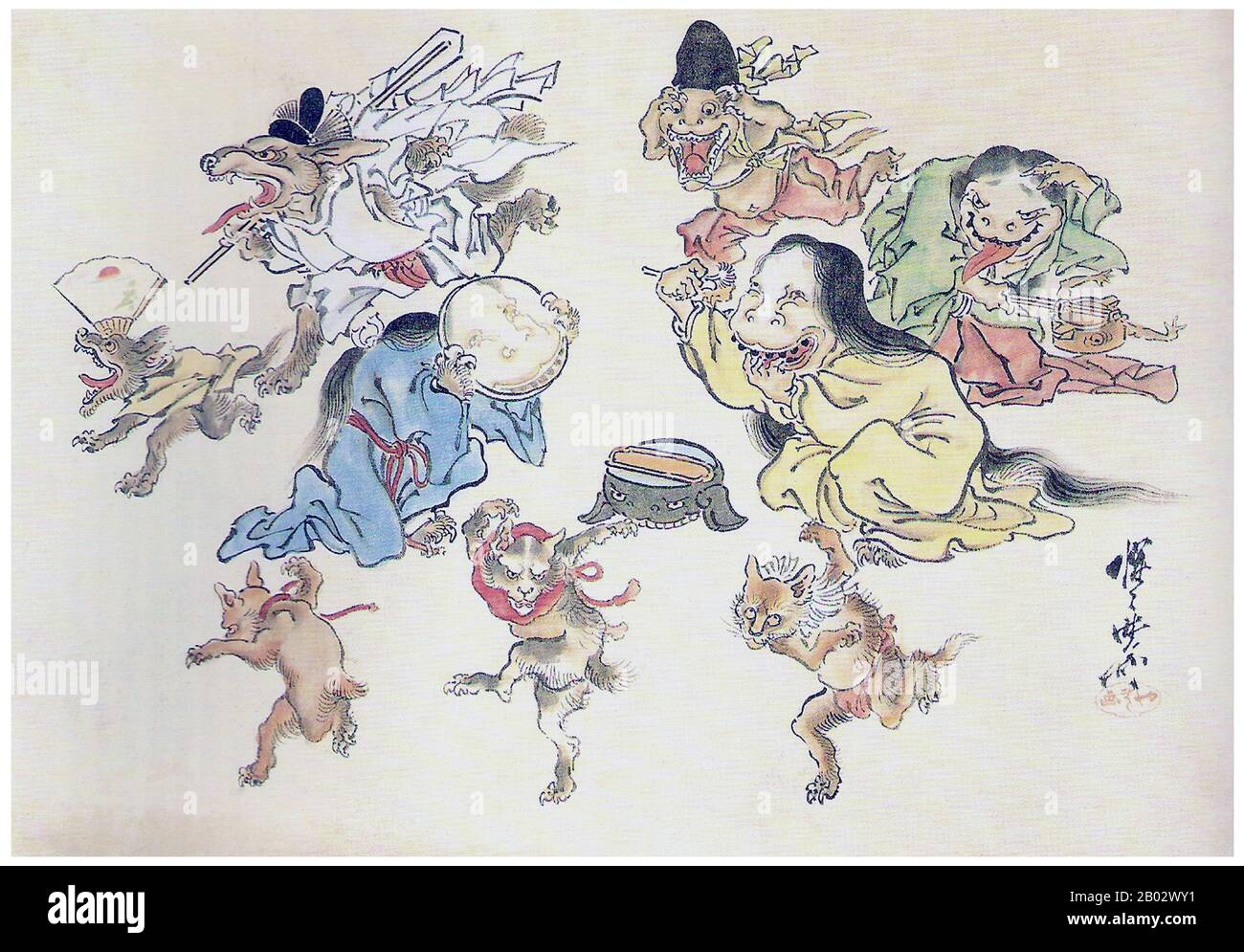 Hyakki Yagyo, variation: hyakki yako, (lit. 'Night Parade of One Hundred Demons') is a concept in Japanese folklore. It is a parade which is composed of a hundred kinds of yokai (supernatural monsters). Legend has it that every year the yokai Nurarihyon, will lead all of the yokai through the streets of Japan during summer nights. Anyone who comes across the procession will perish or be spirited away by the yokai, unless protected by handwritten scrolls by anti-yokai onmyoji spellcasters. According to the account in the Shugaisho, a medieval Japanese encyclopedia, the only way to be kept saf Stock Photohttps://www.alamy.com/image-license-details/?v=1https://www.alamy.com/hyakki-yagyo-variation-hyakki-yako-lit-night-parade-of-one-hundred-demons-is-a-concept-in-japanese-folklore-it-is-a-parade-which-is-composed-of-a-hundred-kinds-of-yokai-supernatural-monsters-legend-has-it-that-every-year-the-yokai-nurarihyon-will-lead-all-of-the-yokai-through-the-streets-of-japan-during-summer-nights-anyone-who-comes-across-the-procession-will-perish-or-be-spirited-away-by-the-yokai-unless-protected-by-handwritten-scrolls-by-anti-yokai-onmyoji-spellcasters-according-to-the-account-in-the-shugaisho-a-medieval-japanese-encyclopedia-the-only-way-to-be-kept-saf-image344271621.html
Hyakki Yagyo, variation: hyakki yako, (lit. 'Night Parade of One Hundred Demons') is a concept in Japanese folklore. It is a parade which is composed of a hundred kinds of yokai (supernatural monsters). Legend has it that every year the yokai Nurarihyon, will lead all of the yokai through the streets of Japan during summer nights. Anyone who comes across the procession will perish or be spirited away by the yokai, unless protected by handwritten scrolls by anti-yokai onmyoji spellcasters. According to the account in the Shugaisho, a medieval Japanese encyclopedia, the only way to be kept saf Stock Photohttps://www.alamy.com/image-license-details/?v=1https://www.alamy.com/hyakki-yagyo-variation-hyakki-yako-lit-night-parade-of-one-hundred-demons-is-a-concept-in-japanese-folklore-it-is-a-parade-which-is-composed-of-a-hundred-kinds-of-yokai-supernatural-monsters-legend-has-it-that-every-year-the-yokai-nurarihyon-will-lead-all-of-the-yokai-through-the-streets-of-japan-during-summer-nights-anyone-who-comes-across-the-procession-will-perish-or-be-spirited-away-by-the-yokai-unless-protected-by-handwritten-scrolls-by-anti-yokai-onmyoji-spellcasters-according-to-the-account-in-the-shugaisho-a-medieval-japanese-encyclopedia-the-only-way-to-be-kept-saf-image344271621.htmlRM2B02WY1–Hyakki Yagyo, variation: hyakki yako, (lit. 'Night Parade of One Hundred Demons') is a concept in Japanese folklore. It is a parade which is composed of a hundred kinds of yokai (supernatural monsters). Legend has it that every year the yokai Nurarihyon, will lead all of the yokai through the streets of Japan during summer nights. Anyone who comes across the procession will perish or be spirited away by the yokai, unless protected by handwritten scrolls by anti-yokai onmyoji spellcasters. According to the account in the Shugaisho, a medieval Japanese encyclopedia, the only way to be kept saf
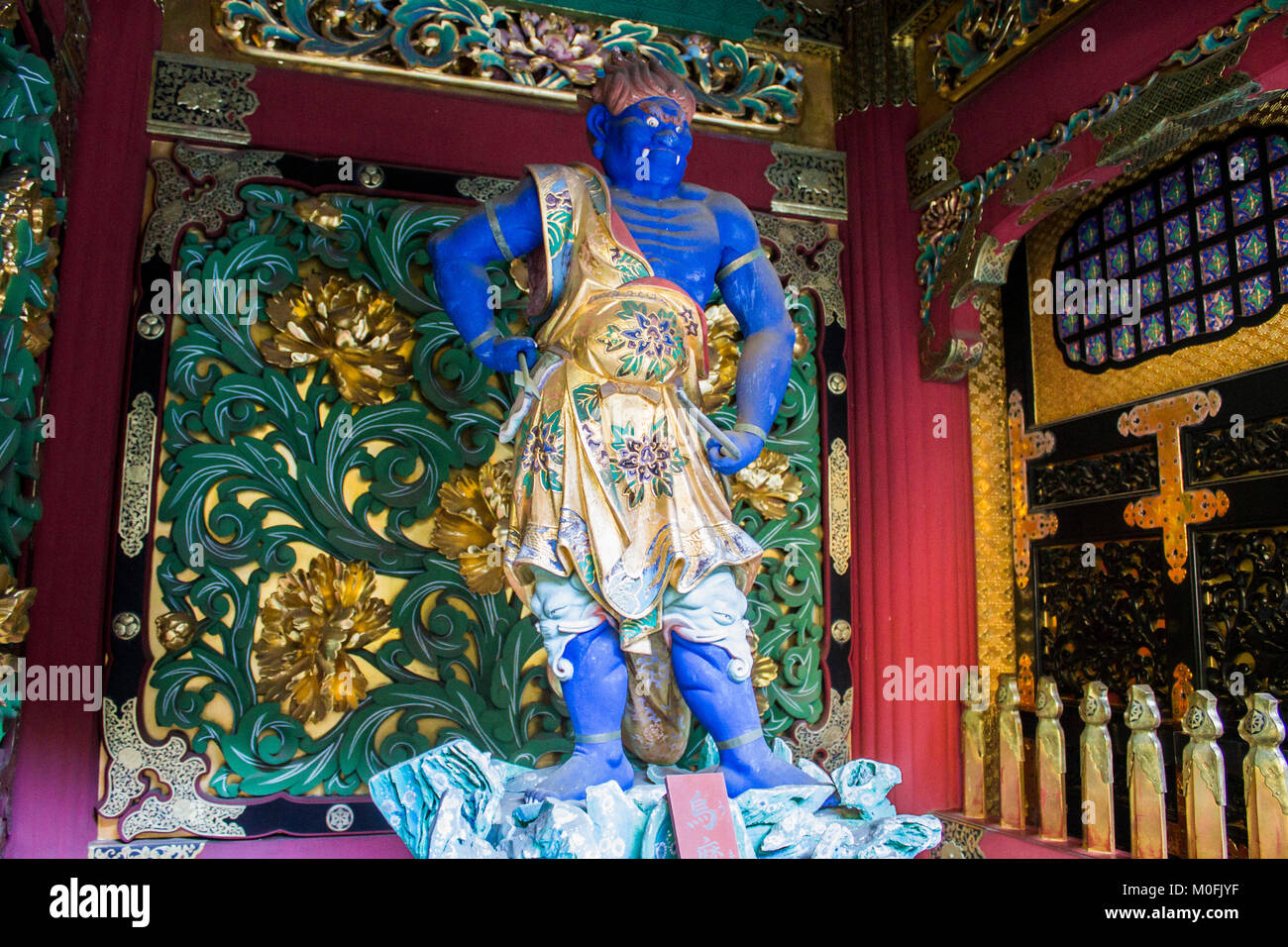 Umarokya, who protects the north sky. One of the four guardian deities in the Yashamon gate of Taiyuin temple, Nikko, Japan Stock Photohttps://www.alamy.com/image-license-details/?v=1https://www.alamy.com/stock-photo-umarokya-who-protects-the-north-sky-one-of-the-four-guardian-deities-172447843.html
Umarokya, who protects the north sky. One of the four guardian deities in the Yashamon gate of Taiyuin temple, Nikko, Japan Stock Photohttps://www.alamy.com/image-license-details/?v=1https://www.alamy.com/stock-photo-umarokya-who-protects-the-north-sky-one-of-the-four-guardian-deities-172447843.htmlRFM0FJYF–Umarokya, who protects the north sky. One of the four guardian deities in the Yashamon gate of Taiyuin temple, Nikko, Japan
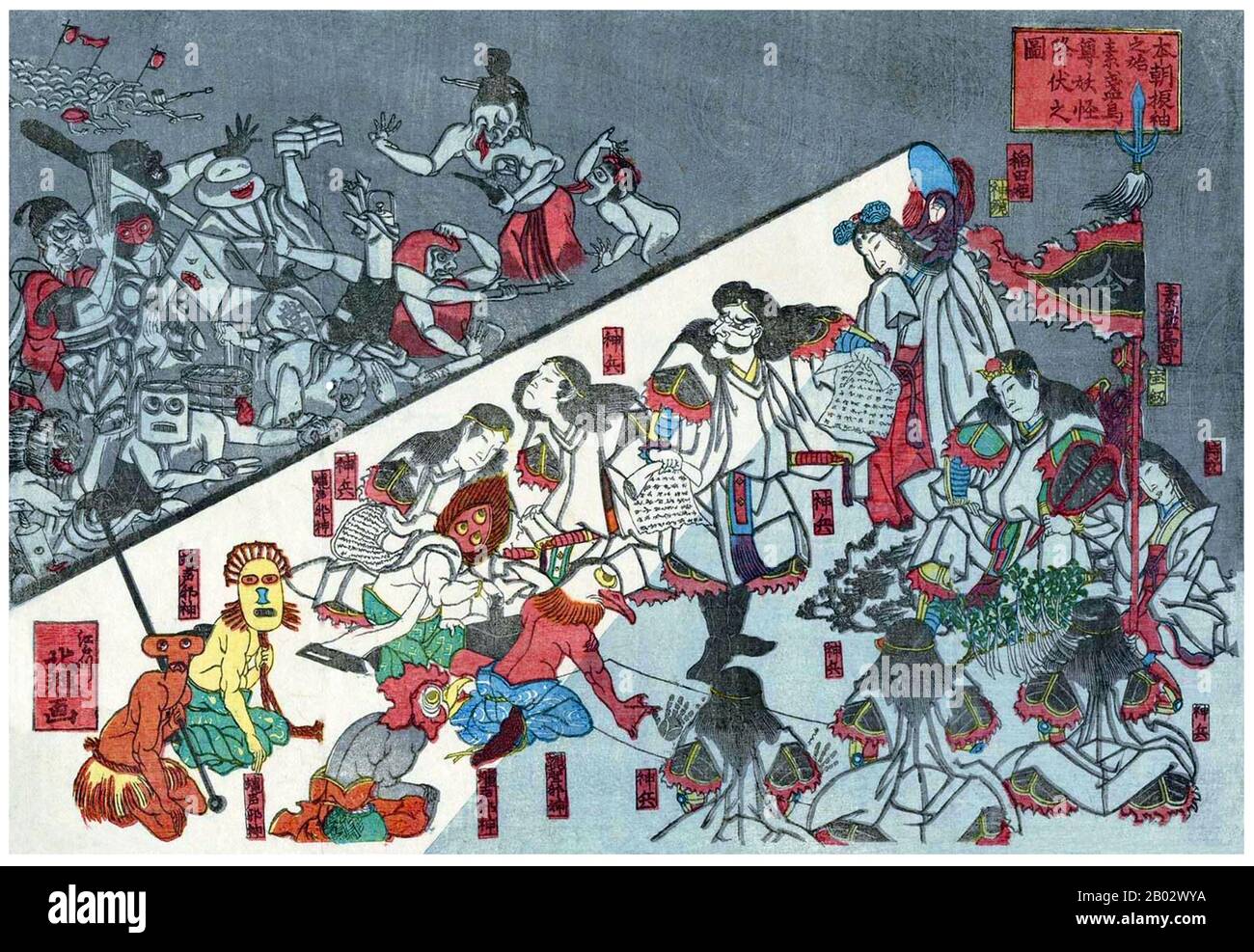 Hyakki Yagyo, variation: hyakki yako, (lit. 'Night Parade of One Hundred Demons') is a concept in Japanese folklore. It is a parade which is composed of a hundred kinds of yokai (supernatural monsters). Legend has it that every year the yokai Nurarihyon, will lead all of the yokai through the streets of Japan during summer nights. Anyone who comes across the procession will perish or be spirited away by the yokai, unless protected by handwritten scrolls by anti-yokai onmyoji spellcasters. According to the account in the Shugaisho, a medieval Japanese encyclopedia, the only way to be kept saf Stock Photohttps://www.alamy.com/image-license-details/?v=1https://www.alamy.com/hyakki-yagyo-variation-hyakki-yako-lit-night-parade-of-one-hundred-demons-is-a-concept-in-japanese-folklore-it-is-a-parade-which-is-composed-of-a-hundred-kinds-of-yokai-supernatural-monsters-legend-has-it-that-every-year-the-yokai-nurarihyon-will-lead-all-of-the-yokai-through-the-streets-of-japan-during-summer-nights-anyone-who-comes-across-the-procession-will-perish-or-be-spirited-away-by-the-yokai-unless-protected-by-handwritten-scrolls-by-anti-yokai-onmyoji-spellcasters-according-to-the-account-in-the-shugaisho-a-medieval-japanese-encyclopedia-the-only-way-to-be-kept-saf-image344271630.html
Hyakki Yagyo, variation: hyakki yako, (lit. 'Night Parade of One Hundred Demons') is a concept in Japanese folklore. It is a parade which is composed of a hundred kinds of yokai (supernatural monsters). Legend has it that every year the yokai Nurarihyon, will lead all of the yokai through the streets of Japan during summer nights. Anyone who comes across the procession will perish or be spirited away by the yokai, unless protected by handwritten scrolls by anti-yokai onmyoji spellcasters. According to the account in the Shugaisho, a medieval Japanese encyclopedia, the only way to be kept saf Stock Photohttps://www.alamy.com/image-license-details/?v=1https://www.alamy.com/hyakki-yagyo-variation-hyakki-yako-lit-night-parade-of-one-hundred-demons-is-a-concept-in-japanese-folklore-it-is-a-parade-which-is-composed-of-a-hundred-kinds-of-yokai-supernatural-monsters-legend-has-it-that-every-year-the-yokai-nurarihyon-will-lead-all-of-the-yokai-through-the-streets-of-japan-during-summer-nights-anyone-who-comes-across-the-procession-will-perish-or-be-spirited-away-by-the-yokai-unless-protected-by-handwritten-scrolls-by-anti-yokai-onmyoji-spellcasters-according-to-the-account-in-the-shugaisho-a-medieval-japanese-encyclopedia-the-only-way-to-be-kept-saf-image344271630.htmlRM2B02WYA–Hyakki Yagyo, variation: hyakki yako, (lit. 'Night Parade of One Hundred Demons') is a concept in Japanese folklore. It is a parade which is composed of a hundred kinds of yokai (supernatural monsters). Legend has it that every year the yokai Nurarihyon, will lead all of the yokai through the streets of Japan during summer nights. Anyone who comes across the procession will perish or be spirited away by the yokai, unless protected by handwritten scrolls by anti-yokai onmyoji spellcasters. According to the account in the Shugaisho, a medieval Japanese encyclopedia, the only way to be kept saf
 Immerse yourself in the captivating world of Japanese arts with our stunning collection of vector art files, Vector Oni Hannya masks. Stock Vectorhttps://www.alamy.com/image-license-details/?v=1https://www.alamy.com/immerse-yourself-in-the-captivating-world-of-japanese-arts-with-our-stunning-collection-of-vector-art-files-vector-oni-hannya-masks-image595843449.html
Immerse yourself in the captivating world of Japanese arts with our stunning collection of vector art files, Vector Oni Hannya masks. Stock Vectorhttps://www.alamy.com/image-license-details/?v=1https://www.alamy.com/immerse-yourself-in-the-captivating-world-of-japanese-arts-with-our-stunning-collection-of-vector-art-files-vector-oni-hannya-masks-image595843449.htmlRF2WHB0B5–Immerse yourself in the captivating world of Japanese arts with our stunning collection of vector art files, Vector Oni Hannya masks.
 China: 'Zhongshan Going on Excursion'. Handscroll painting by Gong Kai (1222-1307), late 13th - early 14th century. Zhong Kui (Wade-Giles: Chung Kwei, Japanese: Shōki) is a figure of Chinese mythology. Traditionally regarded as a vanquisher of ghosts and evil beings, and reputedly able to command 80,000 demons, his image is often painted on household gates as a guardian spirit, as well as in places of business where high-value goods are involved. Zhong Kui's popularity in folklore can be traced to the reign of Emperor Xuanzong of Tang (712-756). Stock Photohttps://www.alamy.com/image-license-details/?v=1https://www.alamy.com/china-zhongshan-going-on-excursion-handscroll-painting-by-gong-kai-1222-1307-late-13th-early-14th-century-zhong-kui-wade-giles-chung-kwei-japanese-shki-is-a-figure-of-chinese-mythology-traditionally-regarded-as-a-vanquisher-of-ghosts-and-evil-beings-and-reputedly-able-to-command-80000-demons-his-image-is-often-painted-on-household-gates-as-a-guardian-spirit-as-well-as-in-places-of-business-where-high-value-goods-are-involved-zhong-kuis-popularity-in-folklore-can-be-traced-to-the-reign-of-emperor-xuanzong-of-tang-712-756-image344234843.html
China: 'Zhongshan Going on Excursion'. Handscroll painting by Gong Kai (1222-1307), late 13th - early 14th century. Zhong Kui (Wade-Giles: Chung Kwei, Japanese: Shōki) is a figure of Chinese mythology. Traditionally regarded as a vanquisher of ghosts and evil beings, and reputedly able to command 80,000 demons, his image is often painted on household gates as a guardian spirit, as well as in places of business where high-value goods are involved. Zhong Kui's popularity in folklore can be traced to the reign of Emperor Xuanzong of Tang (712-756). Stock Photohttps://www.alamy.com/image-license-details/?v=1https://www.alamy.com/china-zhongshan-going-on-excursion-handscroll-painting-by-gong-kai-1222-1307-late-13th-early-14th-century-zhong-kui-wade-giles-chung-kwei-japanese-shki-is-a-figure-of-chinese-mythology-traditionally-regarded-as-a-vanquisher-of-ghosts-and-evil-beings-and-reputedly-able-to-command-80000-demons-his-image-is-often-painted-on-household-gates-as-a-guardian-spirit-as-well-as-in-places-of-business-where-high-value-goods-are-involved-zhong-kuis-popularity-in-folklore-can-be-traced-to-the-reign-of-emperor-xuanzong-of-tang-712-756-image344234843.htmlRM2B0171F–China: 'Zhongshan Going on Excursion'. Handscroll painting by Gong Kai (1222-1307), late 13th - early 14th century. Zhong Kui (Wade-Giles: Chung Kwei, Japanese: Shōki) is a figure of Chinese mythology. Traditionally regarded as a vanquisher of ghosts and evil beings, and reputedly able to command 80,000 demons, his image is often painted on household gates as a guardian spirit, as well as in places of business where high-value goods are involved. Zhong Kui's popularity in folklore can be traced to the reign of Emperor Xuanzong of Tang (712-756).
 Shōki and Demons, late 19th century, Aoki Toshio, Japanese, 1854 - 1912, 20 × 48 in. (50.8 × 121.92 cm) (image)52 × 53 in. (132.08 × 134.62 cm) (mount) (approximate), Ink and color on silk, Japan, 19th century, A grotto-like space is filled with demons playing musical instruments, arm wrestling, quarrelling, and even, it would seem, preaching. Contemptuously surveying the scene is Shōki, the Queller of Demons. A deity from China’s Daoist pantheon, Shōki became a popular figure associated with Boys’ Day celebrations during Japan’s Edo period. Stock Photohttps://www.alamy.com/image-license-details/?v=1https://www.alamy.com/shki-and-demons-late-19th-century-aoki-toshio-japanese-1854-1912-20-48-in-508-12192-cm-image52-53-in-13208-13462-cm-mount-approximate-ink-and-color-on-silk-japan-19th-century-a-grotto-like-space-is-filled-with-demons-playing-musical-instruments-arm-wrestling-quarrelling-and-even-it-would-seem-preaching-contemptuously-surveying-the-scene-is-shki-the-queller-of-demons-a-deity-from-chinas-daoist-pantheon-shki-became-a-popular-figure-associated-with-boys-day-celebrations-during-japans-edo-period-image573484550.html
Shōki and Demons, late 19th century, Aoki Toshio, Japanese, 1854 - 1912, 20 × 48 in. (50.8 × 121.92 cm) (image)52 × 53 in. (132.08 × 134.62 cm) (mount) (approximate), Ink and color on silk, Japan, 19th century, A grotto-like space is filled with demons playing musical instruments, arm wrestling, quarrelling, and even, it would seem, preaching. Contemptuously surveying the scene is Shōki, the Queller of Demons. A deity from China’s Daoist pantheon, Shōki became a popular figure associated with Boys’ Day celebrations during Japan’s Edo period. Stock Photohttps://www.alamy.com/image-license-details/?v=1https://www.alamy.com/shki-and-demons-late-19th-century-aoki-toshio-japanese-1854-1912-20-48-in-508-12192-cm-image52-53-in-13208-13462-cm-mount-approximate-ink-and-color-on-silk-japan-19th-century-a-grotto-like-space-is-filled-with-demons-playing-musical-instruments-arm-wrestling-quarrelling-and-even-it-would-seem-preaching-contemptuously-surveying-the-scene-is-shki-the-queller-of-demons-a-deity-from-chinas-daoist-pantheon-shki-became-a-popular-figure-associated-with-boys-day-celebrations-during-japans-edo-period-image573484550.htmlRM2T90DB2–Shōki and Demons, late 19th century, Aoki Toshio, Japanese, 1854 - 1912, 20 × 48 in. (50.8 × 121.92 cm) (image)52 × 53 in. (132.08 × 134.62 cm) (mount) (approximate), Ink and color on silk, Japan, 19th century, A grotto-like space is filled with demons playing musical instruments, arm wrestling, quarrelling, and even, it would seem, preaching. Contemptuously surveying the scene is Shōki, the Queller of Demons. A deity from China’s Daoist pantheon, Shōki became a popular figure associated with Boys’ Day celebrations during Japan’s Edo period.
 Jinmenju, Konjaku Hyakki Shūi First Volume Cloud, published ca. 1781, by Japanese artist Sekien Toriyama ( 1712 - 1788 ) Stock Photohttps://www.alamy.com/image-license-details/?v=1https://www.alamy.com/jinmenju-konjaku-hyakki-shi-first-volume-cloud-published-ca-1781-by-japanese-artist-sekien-toriyama-1712-1788-image208345609.html
Jinmenju, Konjaku Hyakki Shūi First Volume Cloud, published ca. 1781, by Japanese artist Sekien Toriyama ( 1712 - 1788 ) Stock Photohttps://www.alamy.com/image-license-details/?v=1https://www.alamy.com/jinmenju-konjaku-hyakki-shi-first-volume-cloud-published-ca-1781-by-japanese-artist-sekien-toriyama-1712-1788-image208345609.htmlRMP2XXXH–Jinmenju, Konjaku Hyakki Shūi First Volume Cloud, published ca. 1781, by Japanese artist Sekien Toriyama ( 1712 - 1788 )
 A bearded man in battle with a group of demons, most of them floating in the air, Man in battle with demons, print maker: Johannes Josephus Aarts, (signed by artist), 1881 - 1934, Japanese paper (handmade paper), h 329 mm × w 248 mm Stock Photohttps://www.alamy.com/image-license-details/?v=1https://www.alamy.com/a-bearded-man-in-battle-with-a-group-of-demons-most-of-them-floating-in-the-air-man-in-battle-with-demons-print-maker-johannes-josephus-aarts-signed-by-artist-1881-1934-japanese-paper-handmade-paper-h-329-mm-w-248-mm-image473391242.html
A bearded man in battle with a group of demons, most of them floating in the air, Man in battle with demons, print maker: Johannes Josephus Aarts, (signed by artist), 1881 - 1934, Japanese paper (handmade paper), h 329 mm × w 248 mm Stock Photohttps://www.alamy.com/image-license-details/?v=1https://www.alamy.com/a-bearded-man-in-battle-with-a-group-of-demons-most-of-them-floating-in-the-air-man-in-battle-with-demons-print-maker-johannes-josephus-aarts-signed-by-artist-1881-1934-japanese-paper-handmade-paper-h-329-mm-w-248-mm-image473391242.htmlRM2JE4RA2–A bearded man in battle with a group of demons, most of them floating in the air, Man in battle with demons, print maker: Johannes Josephus Aarts, (signed by artist), 1881 - 1934, Japanese paper (handmade paper), h 329 mm × w 248 mm
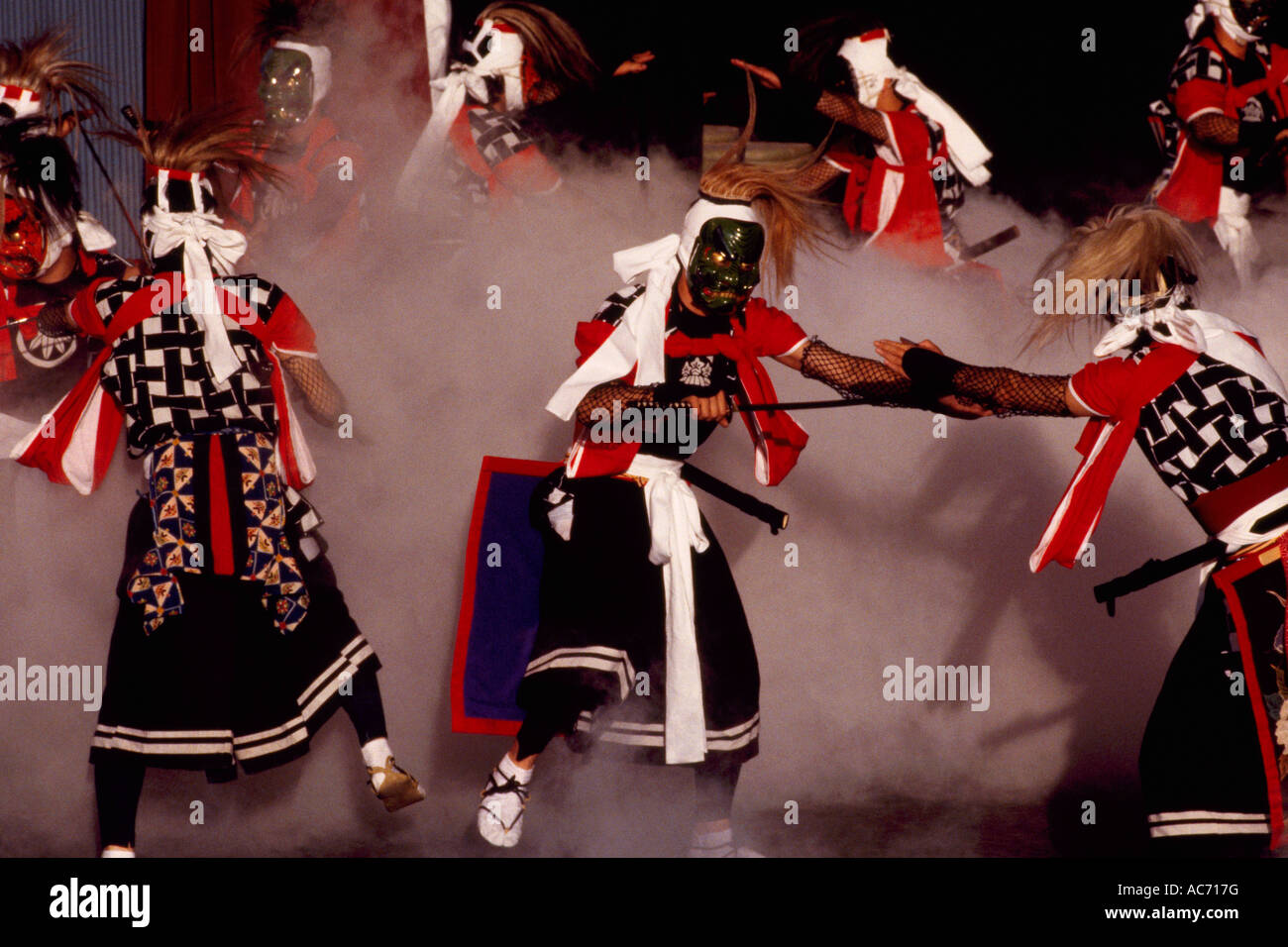 The Tsugaru Shamisen Players from Japan performing the Traditional Sword Dance of the Demons on Stage Stock Photohttps://www.alamy.com/image-license-details/?v=1https://www.alamy.com/stock-photo-the-tsugaru-shamisen-players-from-japan-performing-the-traditional-13061859.html
The Tsugaru Shamisen Players from Japan performing the Traditional Sword Dance of the Demons on Stage Stock Photohttps://www.alamy.com/image-license-details/?v=1https://www.alamy.com/stock-photo-the-tsugaru-shamisen-players-from-japan-performing-the-traditional-13061859.htmlRMAC717G–The Tsugaru Shamisen Players from Japan performing the Traditional Sword Dance of the Demons on Stage
 Bishamonten, the Guardian of the North, 11th century, Unknown Japanese, 116 cm (including base), Wood with polychrome, Japan, 11th century, Vaishravana is one of the Twelve Devas, a group of Hindu gods adopted as Buddhist guardian deities charged with protecting the four cardinal directions and the four intermediate directions, as well as the sun, moon, heaven, and earth. As the most powerful of the 12, Vaishravana presides over the north, which was understood to be the most dangerous of all directions as it was also inhabited by evil demons and ogres. Stock Photohttps://www.alamy.com/image-license-details/?v=1https://www.alamy.com/bishamonten-the-guardian-of-the-north-11th-century-unknown-japanese-116-cm-including-base-wood-with-polychrome-japan-11th-century-vaishravana-is-one-of-the-twelve-devas-a-group-of-hindu-gods-adopted-as-buddhist-guardian-deities-charged-with-protecting-the-four-cardinal-directions-and-the-four-intermediate-directions-as-well-as-the-sun-moon-heaven-and-earth-as-the-most-powerful-of-the-12-vaishravana-presides-over-the-north-which-was-understood-to-be-the-most-dangerous-of-all-directions-as-it-was-also-inhabited-by-evil-demons-and-ogres-image573486516.html
Bishamonten, the Guardian of the North, 11th century, Unknown Japanese, 116 cm (including base), Wood with polychrome, Japan, 11th century, Vaishravana is one of the Twelve Devas, a group of Hindu gods adopted as Buddhist guardian deities charged with protecting the four cardinal directions and the four intermediate directions, as well as the sun, moon, heaven, and earth. As the most powerful of the 12, Vaishravana presides over the north, which was understood to be the most dangerous of all directions as it was also inhabited by evil demons and ogres. Stock Photohttps://www.alamy.com/image-license-details/?v=1https://www.alamy.com/bishamonten-the-guardian-of-the-north-11th-century-unknown-japanese-116-cm-including-base-wood-with-polychrome-japan-11th-century-vaishravana-is-one-of-the-twelve-devas-a-group-of-hindu-gods-adopted-as-buddhist-guardian-deities-charged-with-protecting-the-four-cardinal-directions-and-the-four-intermediate-directions-as-well-as-the-sun-moon-heaven-and-earth-as-the-most-powerful-of-the-12-vaishravana-presides-over-the-north-which-was-understood-to-be-the-most-dangerous-of-all-directions-as-it-was-also-inhabited-by-evil-demons-and-ogres-image573486516.htmlRM2T90FW8–Bishamonten, the Guardian of the North, 11th century, Unknown Japanese, 116 cm (including base), Wood with polychrome, Japan, 11th century, Vaishravana is one of the Twelve Devas, a group of Hindu gods adopted as Buddhist guardian deities charged with protecting the four cardinal directions and the four intermediate directions, as well as the sun, moon, heaven, and earth. As the most powerful of the 12, Vaishravana presides over the north, which was understood to be the most dangerous of all directions as it was also inhabited by evil demons and ogres.
 London, UK. 15 March 2022. Staff members view 'Night Procession of One Hundred Demons', 1871/89, by Kawanabe Kyōsai. Preview of Kyōsai: The Israel Goldman Collection exhibition at the Royal Academy of Arts where 80 works by late 19th century Japanese painter Kawanabe Kyōsai are on display 19 March to 19 June 2022 in the artist’s first solo UK exhibition in 30 years. Credit: Stephen Chung / Alamy Live News Stock Photohttps://www.alamy.com/image-license-details/?v=1https://www.alamy.com/london-uk-15-march-2022-staff-members-view-night-procession-of-one-hundred-demons-187189-by-kawanabe-kysai-preview-of-kysai-the-israel-goldman-collection-exhibition-at-the-royal-academy-of-arts-where-80-works-by-late-19th-century-japanese-painter-kawanabe-kysai-are-on-display-19-march-to-19-june-2022-in-the-artists-first-solo-uk-exhibition-in-30-years-credit-stephen-chung-alamy-live-news-image464523574.html
London, UK. 15 March 2022. Staff members view 'Night Procession of One Hundred Demons', 1871/89, by Kawanabe Kyōsai. Preview of Kyōsai: The Israel Goldman Collection exhibition at the Royal Academy of Arts where 80 works by late 19th century Japanese painter Kawanabe Kyōsai are on display 19 March to 19 June 2022 in the artist’s first solo UK exhibition in 30 years. Credit: Stephen Chung / Alamy Live News Stock Photohttps://www.alamy.com/image-license-details/?v=1https://www.alamy.com/london-uk-15-march-2022-staff-members-view-night-procession-of-one-hundred-demons-187189-by-kawanabe-kysai-preview-of-kysai-the-israel-goldman-collection-exhibition-at-the-royal-academy-of-arts-where-80-works-by-late-19th-century-japanese-painter-kawanabe-kysai-are-on-display-19-march-to-19-june-2022-in-the-artists-first-solo-uk-exhibition-in-30-years-credit-stephen-chung-alamy-live-news-image464523574.htmlRM2HYMTFJ–London, UK. 15 March 2022. Staff members view 'Night Procession of One Hundred Demons', 1871/89, by Kawanabe Kyōsai. Preview of Kyōsai: The Israel Goldman Collection exhibition at the Royal Academy of Arts where 80 works by late 19th century Japanese painter Kawanabe Kyōsai are on display 19 March to 19 June 2022 in the artist’s first solo UK exhibition in 30 years. Credit: Stephen Chung / Alamy Live News
 . English: Yokai/' Night March of a Hundred Demons' scroll by Tosa Mitsuoki. Tosa Mitsuoki (Japanese: 土佐 光起; 1617–November 14, 1691) was a Japanese painter. Tosa was born in Sakai, Osaka, the son of Tosa Mitsunori (1583–1638), also a painter. His original name was Tosa Fujimitsu, also called Tsuneaki. Tosa lived in the early Edo period (1603–1867). He revived the Tosa school of painting, recapturing the title of official court artist. He died in Kyoto. 1600s. Tosa Mitsuki 288 Hyakki Yako no Zu by Tosa Mitsuoki- right half Stock Photohttps://www.alamy.com/image-license-details/?v=1https://www.alamy.com/english-yokai-night-march-of-a-hundred-demons-scroll-by-tosa-mitsuoki-tosa-mitsuoki-japanese-1617november-14-1691-was-a-japanese-painter-tosa-was-born-in-sakai-osaka-the-son-of-tosa-mitsunori-15831638-also-a-painter-his-original-name-was-tosa-fujimitsu-also-called-tsuneaki-tosa-lived-in-the-early-edo-period-16031867-he-revived-the-tosa-school-of-painting-recapturing-the-title-of-official-court-artist-he-died-in-kyoto-1600s-tosa-mitsuki-288-hyakki-yako-no-zu-by-tosa-mitsuoki-right-half-image187785244.html
. English: Yokai/' Night March of a Hundred Demons' scroll by Tosa Mitsuoki. Tosa Mitsuoki (Japanese: 土佐 光起; 1617–November 14, 1691) was a Japanese painter. Tosa was born in Sakai, Osaka, the son of Tosa Mitsunori (1583–1638), also a painter. His original name was Tosa Fujimitsu, also called Tsuneaki. Tosa lived in the early Edo period (1603–1867). He revived the Tosa school of painting, recapturing the title of official court artist. He died in Kyoto. 1600s. Tosa Mitsuki 288 Hyakki Yako no Zu by Tosa Mitsuoki- right half Stock Photohttps://www.alamy.com/image-license-details/?v=1https://www.alamy.com/english-yokai-night-march-of-a-hundred-demons-scroll-by-tosa-mitsuoki-tosa-mitsuoki-japanese-1617november-14-1691-was-a-japanese-painter-tosa-was-born-in-sakai-osaka-the-son-of-tosa-mitsunori-15831638-also-a-painter-his-original-name-was-tosa-fujimitsu-also-called-tsuneaki-tosa-lived-in-the-early-edo-period-16031867-he-revived-the-tosa-school-of-painting-recapturing-the-title-of-official-court-artist-he-died-in-kyoto-1600s-tosa-mitsuki-288-hyakki-yako-no-zu-by-tosa-mitsuoki-right-half-image187785244.htmlRMMWE9YT–. English: Yokai/' Night March of a Hundred Demons' scroll by Tosa Mitsuoki. Tosa Mitsuoki (Japanese: 土佐 光起; 1617–November 14, 1691) was a Japanese painter. Tosa was born in Sakai, Osaka, the son of Tosa Mitsunori (1583–1638), also a painter. His original name was Tosa Fujimitsu, also called Tsuneaki. Tosa lived in the early Edo period (1603–1867). He revived the Tosa school of painting, recapturing the title of official court artist. He died in Kyoto. 1600s. Tosa Mitsuki 288 Hyakki Yako no Zu by Tosa Mitsuoki- right half
 Gaki Zoshi (Hungry Ghosts Scroll), detail, color on paper, Heian period, 12th century Stock Photohttps://www.alamy.com/image-license-details/?v=1https://www.alamy.com/gaki-zoshi-hungry-ghosts-scroll-detail-color-on-paper-heian-period-12th-century-image261114375.html
Gaki Zoshi (Hungry Ghosts Scroll), detail, color on paper, Heian period, 12th century Stock Photohttps://www.alamy.com/image-license-details/?v=1https://www.alamy.com/gaki-zoshi-hungry-ghosts-scroll-detail-color-on-paper-heian-period-12th-century-image261114375.htmlRFW4PP1B–Gaki Zoshi (Hungry Ghosts Scroll), detail, color on paper, Heian period, 12th century
 Kumano, Japan at the Onigajo coastline. Stock Photohttps://www.alamy.com/image-license-details/?v=1https://www.alamy.com/kumano-japan-at-the-onigajo-coastline-image233181289.html
Kumano, Japan at the Onigajo coastline. Stock Photohttps://www.alamy.com/image-license-details/?v=1https://www.alamy.com/kumano-japan-at-the-onigajo-coastline-image233181289.htmlRFRFA935–Kumano, Japan at the Onigajo coastline.
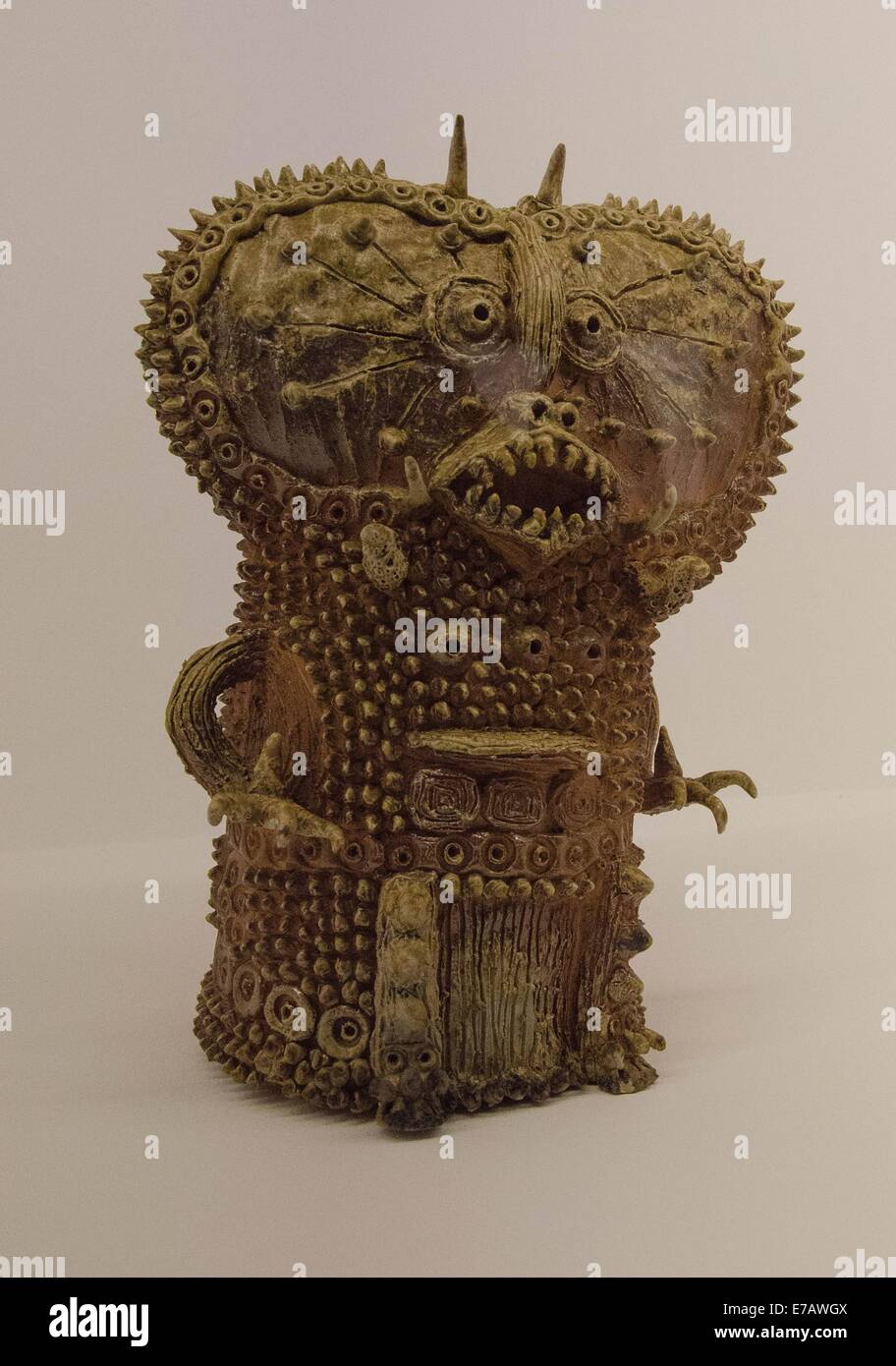 Venice, Biennale 2013, Japanese artist Shinichi Sawada, Art Brut monstrous creatures made of clay sculptures Stock Photohttps://www.alamy.com/image-license-details/?v=1https://www.alamy.com/stock-photo-venice-biennale-2013-japanese-artist-shinichi-sawada-art-brut-monstrous-73383658.html
Venice, Biennale 2013, Japanese artist Shinichi Sawada, Art Brut monstrous creatures made of clay sculptures Stock Photohttps://www.alamy.com/image-license-details/?v=1https://www.alamy.com/stock-photo-venice-biennale-2013-japanese-artist-shinichi-sawada-art-brut-monstrous-73383658.htmlRME7AWGX–Venice, Biennale 2013, Japanese artist Shinichi Sawada, Art Brut monstrous creatures made of clay sculptures
 Mounted soldiers fighting demons. Taishokkan. early Edo period (1640-1680). Kowakamai manuscript dealing with the life of Fujiwara no Kamatari, his daughter and a precious crystal ball. Image taken from Taishokkan. Originally published/produced in early Edo period (1640-1680). . Source: Or. 13129 volume 1, f.27v. Language: Japanese. Stock Photohttps://www.alamy.com/image-license-details/?v=1https://www.alamy.com/mounted-soldiers-fighting-demons-taishokkan-early-edo-period-1640-1680-kowakamai-manuscript-dealing-with-the-life-of-fujiwara-no-kamatari-his-daughter-and-a-precious-crystal-ball-image-taken-from-taishokkan-originally-publishedproduced-in-early-edo-period-1640-1680-source-or-13129-volume-1-f27v-language-japanese-image226989469.html
Mounted soldiers fighting demons. Taishokkan. early Edo period (1640-1680). Kowakamai manuscript dealing with the life of Fujiwara no Kamatari, his daughter and a precious crystal ball. Image taken from Taishokkan. Originally published/produced in early Edo period (1640-1680). . Source: Or. 13129 volume 1, f.27v. Language: Japanese. Stock Photohttps://www.alamy.com/image-license-details/?v=1https://www.alamy.com/mounted-soldiers-fighting-demons-taishokkan-early-edo-period-1640-1680-kowakamai-manuscript-dealing-with-the-life-of-fujiwara-no-kamatari-his-daughter-and-a-precious-crystal-ball-image-taken-from-taishokkan-originally-publishedproduced-in-early-edo-period-1640-1680-source-or-13129-volume-1-f27v-language-japanese-image226989469.htmlRMR587AN–Mounted soldiers fighting demons. Taishokkan. early Edo period (1640-1680). Kowakamai manuscript dealing with the life of Fujiwara no Kamatari, his daughter and a precious crystal ball. Image taken from Taishokkan. Originally published/produced in early Edo period (1640-1680). . Source: Or. 13129 volume 1, f.27v. Language: Japanese.
 YOKOSUKA, Japan (Feb. 3, 2023) – In a bid to experience a Japanese traditional bean-throwing ceremony, nearly 50 employees of NAVSUP FLC Yokosuka flocked into the command’s back patio in the cold. Chanting “oni wa soto, fuku wa uchi!” or “good fortune in, demons out!”, bean-throwers scattered soy beans at oni or demon mask-clad Sailors. The ritual is performed to drive away evil spirit and bring good luck on “Setsubun”, the last day of winter on the Japanese traditional calendar that usually falls on February 3. Stock Photohttps://www.alamy.com/image-license-details/?v=1https://www.alamy.com/yokosuka-japan-feb-3-2023-in-a-bid-to-experience-a-japanese-traditional-bean-throwing-ceremony-nearly-50-employees-of-navsup-flc-yokosuka-flocked-into-the-commands-back-patio-in-the-cold-chanting-oni-wa-soto-fuku-wa-uchi!-or-good-fortune-in-demons-out!-bean-throwers-scattered-soy-beans-at-oni-or-demon-mask-clad-sailors-the-ritual-is-performed-to-drive-away-evil-spirit-and-bring-good-luck-on-setsubun-the-last-day-of-winter-on-the-japanese-traditional-calendar-that-usually-falls-on-february-3-image534631392.html
YOKOSUKA, Japan (Feb. 3, 2023) – In a bid to experience a Japanese traditional bean-throwing ceremony, nearly 50 employees of NAVSUP FLC Yokosuka flocked into the command’s back patio in the cold. Chanting “oni wa soto, fuku wa uchi!” or “good fortune in, demons out!”, bean-throwers scattered soy beans at oni or demon mask-clad Sailors. The ritual is performed to drive away evil spirit and bring good luck on “Setsubun”, the last day of winter on the Japanese traditional calendar that usually falls on February 3. Stock Photohttps://www.alamy.com/image-license-details/?v=1https://www.alamy.com/yokosuka-japan-feb-3-2023-in-a-bid-to-experience-a-japanese-traditional-bean-throwing-ceremony-nearly-50-employees-of-navsup-flc-yokosuka-flocked-into-the-commands-back-patio-in-the-cold-chanting-oni-wa-soto-fuku-wa-uchi!-or-good-fortune-in-demons-out!-bean-throwers-scattered-soy-beans-at-oni-or-demon-mask-clad-sailors-the-ritual-is-performed-to-drive-away-evil-spirit-and-bring-good-luck-on-setsubun-the-last-day-of-winter-on-the-japanese-traditional-calendar-that-usually-falls-on-february-3-image534631392.htmlRM2P1PFP8–YOKOSUKA, Japan (Feb. 3, 2023) – In a bid to experience a Japanese traditional bean-throwing ceremony, nearly 50 employees of NAVSUP FLC Yokosuka flocked into the command’s back patio in the cold. Chanting “oni wa soto, fuku wa uchi!” or “good fortune in, demons out!”, bean-throwers scattered soy beans at oni or demon mask-clad Sailors. The ritual is performed to drive away evil spirit and bring good luck on “Setsubun”, the last day of winter on the Japanese traditional calendar that usually falls on February 3.
 Tora Tora Tora warbird performers fly over the crowd during the 2023 Scott AFB Airshow & STEM Expo, on Scott Air Force Base, Illinois, May 13, 2023. Tora, Tora, Tora began in 1972, when 6 replica Japanese aircraft used in the movie of the same name were donated to the Commemorative Air Force. The Scott AFB Airshow and STEM EXPO demonstrate the Air Force's continuing progress in building the future of airpower with military and civilian air acts including the U.S. Navy Blue Angels, F-35 and F-22 static displays, science, technology, engineering, and math exhibits, and military operations demons Stock Photohttps://www.alamy.com/image-license-details/?v=1https://www.alamy.com/tora-tora-tora-warbird-performers-fly-over-the-crowd-during-the-2023-scott-afb-airshow-stem-expo-on-scott-air-force-base-illinois-may-13-2023-tora-tora-tora-began-in-1972-when-6-replica-japanese-aircraft-used-in-the-movie-of-the-same-name-were-donated-to-the-commemorative-air-force-the-scott-afb-airshow-and-stem-expo-demonstrate-the-air-forces-continuing-progress-in-building-the-future-of-airpower-with-military-and-civilian-air-acts-including-the-us-navy-blue-angels-f-35-and-f-22-static-displays-science-technology-engineering-and-math-exhibits-and-military-operations-demons-image591314385.html
Tora Tora Tora warbird performers fly over the crowd during the 2023 Scott AFB Airshow & STEM Expo, on Scott Air Force Base, Illinois, May 13, 2023. Tora, Tora, Tora began in 1972, when 6 replica Japanese aircraft used in the movie of the same name were donated to the Commemorative Air Force. The Scott AFB Airshow and STEM EXPO demonstrate the Air Force's continuing progress in building the future of airpower with military and civilian air acts including the U.S. Navy Blue Angels, F-35 and F-22 static displays, science, technology, engineering, and math exhibits, and military operations demons Stock Photohttps://www.alamy.com/image-license-details/?v=1https://www.alamy.com/tora-tora-tora-warbird-performers-fly-over-the-crowd-during-the-2023-scott-afb-airshow-stem-expo-on-scott-air-force-base-illinois-may-13-2023-tora-tora-tora-began-in-1972-when-6-replica-japanese-aircraft-used-in-the-movie-of-the-same-name-were-donated-to-the-commemorative-air-force-the-scott-afb-airshow-and-stem-expo-demonstrate-the-air-forces-continuing-progress-in-building-the-future-of-airpower-with-military-and-civilian-air-acts-including-the-us-navy-blue-angels-f-35-and-f-22-static-displays-science-technology-engineering-and-math-exhibits-and-military-operations-demons-image591314385.htmlRM2WA0KEW–Tora Tora Tora warbird performers fly over the crowd during the 2023 Scott AFB Airshow & STEM Expo, on Scott Air Force Base, Illinois, May 13, 2023. Tora, Tora, Tora began in 1972, when 6 replica Japanese aircraft used in the movie of the same name were donated to the Commemorative Air Force. The Scott AFB Airshow and STEM EXPO demonstrate the Air Force's continuing progress in building the future of airpower with military and civilian air acts including the U.S. Navy Blue Angels, F-35 and F-22 static displays, science, technology, engineering, and math exhibits, and military operations demons
 Kyosai's Pictures of One Hundred Demons (Kyosai Hyakkigadan). Artist: Kawanabe Kyosai (Japanese, 1831-1889). Culture: Japan. Dimensions: 8 1/4 × 4 13/16 in. (21 × 12.2 cm). Date: 1890. This was one of the Meiji artist's most popular books, which was published in various editions, including posthumous ones such as this one, from a year after the artist died. It shows a procession of demons who appear throughout the night, offering a spectacular visual encyclopedia of supernatural creatures of premodern Japanese folklore. Museum: Metropolitan Museum of Art, New York, USA. Stock Photohttps://www.alamy.com/image-license-details/?v=1https://www.alamy.com/kyosais-pictures-of-one-hundred-demons-kyosai-hyakkigadan-artist-kawanabe-kyosai-japanese-1831-1889-culture-japan-dimensions-8-14-4-1316-in-21-122-cm-date-1890-this-was-one-of-the-meiji-artists-most-popular-books-which-was-published-in-various-editions-including-posthumous-ones-such-as-this-one-from-a-year-after-the-artist-died-it-shows-a-procession-of-demons-who-appear-throughout-the-night-offering-a-spectacular-visual-encyclopedia-of-supernatural-creatures-of-premodern-japanese-folklore-museum-metropolitan-museum-of-art-new-york-usa-image213154046.html
Kyosai's Pictures of One Hundred Demons (Kyosai Hyakkigadan). Artist: Kawanabe Kyosai (Japanese, 1831-1889). Culture: Japan. Dimensions: 8 1/4 × 4 13/16 in. (21 × 12.2 cm). Date: 1890. This was one of the Meiji artist's most popular books, which was published in various editions, including posthumous ones such as this one, from a year after the artist died. It shows a procession of demons who appear throughout the night, offering a spectacular visual encyclopedia of supernatural creatures of premodern Japanese folklore. Museum: Metropolitan Museum of Art, New York, USA. Stock Photohttps://www.alamy.com/image-license-details/?v=1https://www.alamy.com/kyosais-pictures-of-one-hundred-demons-kyosai-hyakkigadan-artist-kawanabe-kyosai-japanese-1831-1889-culture-japan-dimensions-8-14-4-1316-in-21-122-cm-date-1890-this-was-one-of-the-meiji-artists-most-popular-books-which-was-published-in-various-editions-including-posthumous-ones-such-as-this-one-from-a-year-after-the-artist-died-it-shows-a-procession-of-demons-who-appear-throughout-the-night-offering-a-spectacular-visual-encyclopedia-of-supernatural-creatures-of-premodern-japanese-folklore-museum-metropolitan-museum-of-art-new-york-usa-image213154046.htmlRMPAP04E–Kyosai's Pictures of One Hundred Demons (Kyosai Hyakkigadan). Artist: Kawanabe Kyosai (Japanese, 1831-1889). Culture: Japan. Dimensions: 8 1/4 × 4 13/16 in. (21 × 12.2 cm). Date: 1890. This was one of the Meiji artist's most popular books, which was published in various editions, including posthumous ones such as this one, from a year after the artist died. It shows a procession of demons who appear throughout the night, offering a spectacular visual encyclopedia of supernatural creatures of premodern Japanese folklore. Museum: Metropolitan Museum of Art, New York, USA.